Dearth of Women Representation in the Top Management in the Banking Sector in Bahrain
VerifiedAdded on 2023/06/11
|62
|19487
|263
AI Summary
This research aims to explore the shortage of women executives in the Bahrain Banking Sector and the need for diversity within the board members. The research objectives include finding out the current situation, causes, and barriers behind the requirement of women in high-profile positions. The literature review covers topics such as women leadership, influence on institution performance, and feminism. The study concludes with recommendations for organizations to increase the number of women employees in banking sectors.
Contribute Materials
Your contribution can guide someone’s learning journey. Share your
documents today.
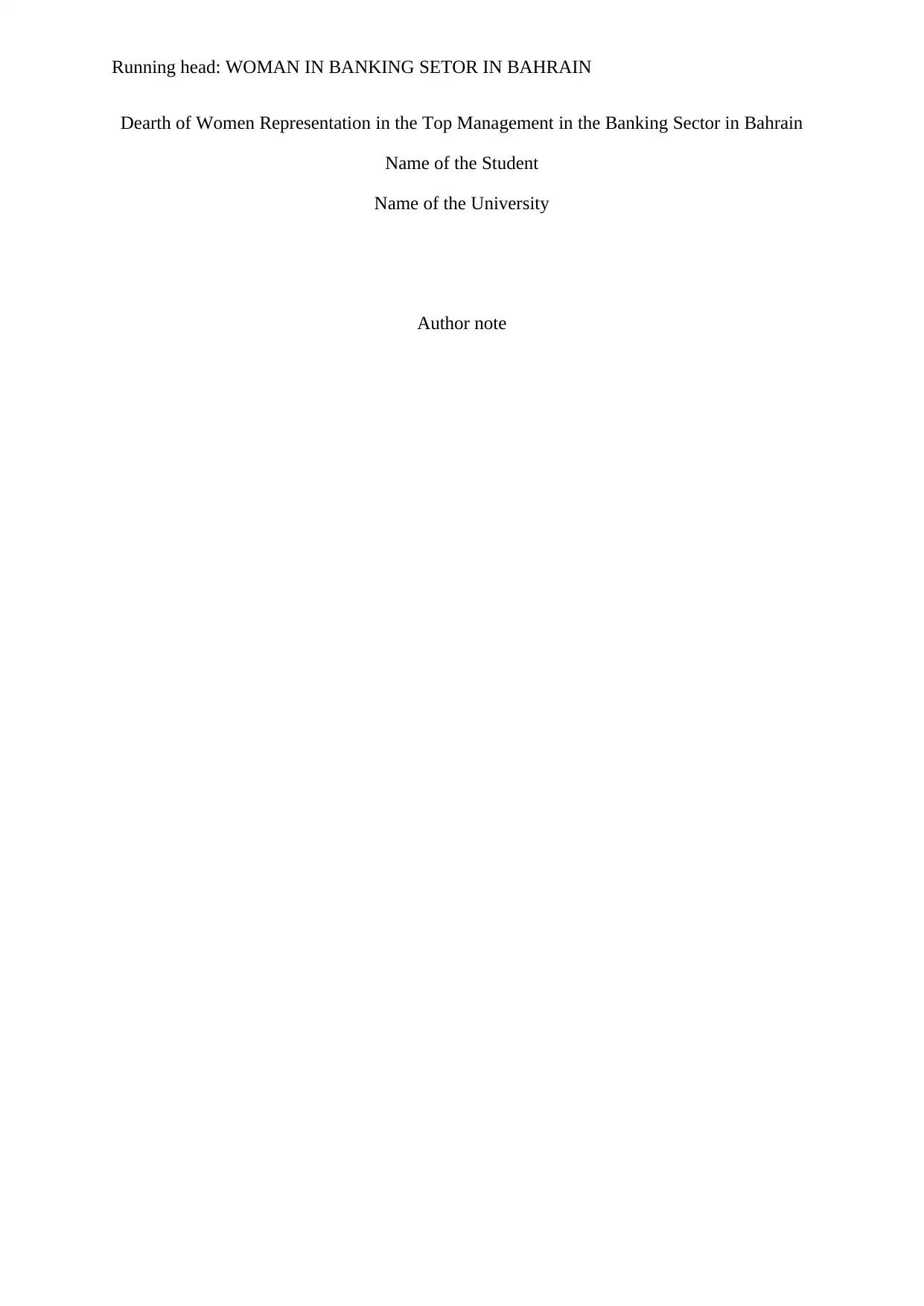
Running head: WOMAN IN BANKING SETOR IN BAHRAIN
Dearth of Women Representation in the Top Management in the Banking Sector in Bahrain
Name of the Student
Name of the University
Author note
Dearth of Women Representation in the Top Management in the Banking Sector in Bahrain
Name of the Student
Name of the University
Author note
Secure Best Marks with AI Grader
Need help grading? Try our AI Grader for instant feedback on your assignments.

1WOMAN IN BANKING SETOR IN BAHRAIN
Abstract
While working in the banking or financial sectors, female employees faces several obstacles
on the basis of professional as well as social perspective. Several factors can be responsible
for the shortage of women executives in BBS (Bahrain Banking Sector). The aim of this
research is to find out the dearth of Women Representation in the top management of the
Banking Sector in Bahrain while analysing the real time and secondary data collection. The
research objectives of this research have been made as per the aim of the study while aligning
the scope of the study with it. It has been found that there is a need for diversity within the
board members and this can only be done by inducing female executives into the managerial
positions. Reports suggest that a company is more likely to undergo a failure when it
undergoes a crisis. Increasing of the cultural and the social awareness and promotion of the
participation of the women in all the management positions to increase the opportunity of the
women to lead the banking and the financial sector. The development of the sustainability of
the women in the Bahraini financial sector needs the continued concern of the authorities for
the effective development of the mechanisms that encourage women employment and
accelerating development in the career that enables them to take up the challenges of
leadership position.
Abstract
While working in the banking or financial sectors, female employees faces several obstacles
on the basis of professional as well as social perspective. Several factors can be responsible
for the shortage of women executives in BBS (Bahrain Banking Sector). The aim of this
research is to find out the dearth of Women Representation in the top management of the
Banking Sector in Bahrain while analysing the real time and secondary data collection. The
research objectives of this research have been made as per the aim of the study while aligning
the scope of the study with it. It has been found that there is a need for diversity within the
board members and this can only be done by inducing female executives into the managerial
positions. Reports suggest that a company is more likely to undergo a failure when it
undergoes a crisis. Increasing of the cultural and the social awareness and promotion of the
participation of the women in all the management positions to increase the opportunity of the
women to lead the banking and the financial sector. The development of the sustainability of
the women in the Bahraini financial sector needs the continued concern of the authorities for
the effective development of the mechanisms that encourage women employment and
accelerating development in the career that enables them to take up the challenges of
leadership position.
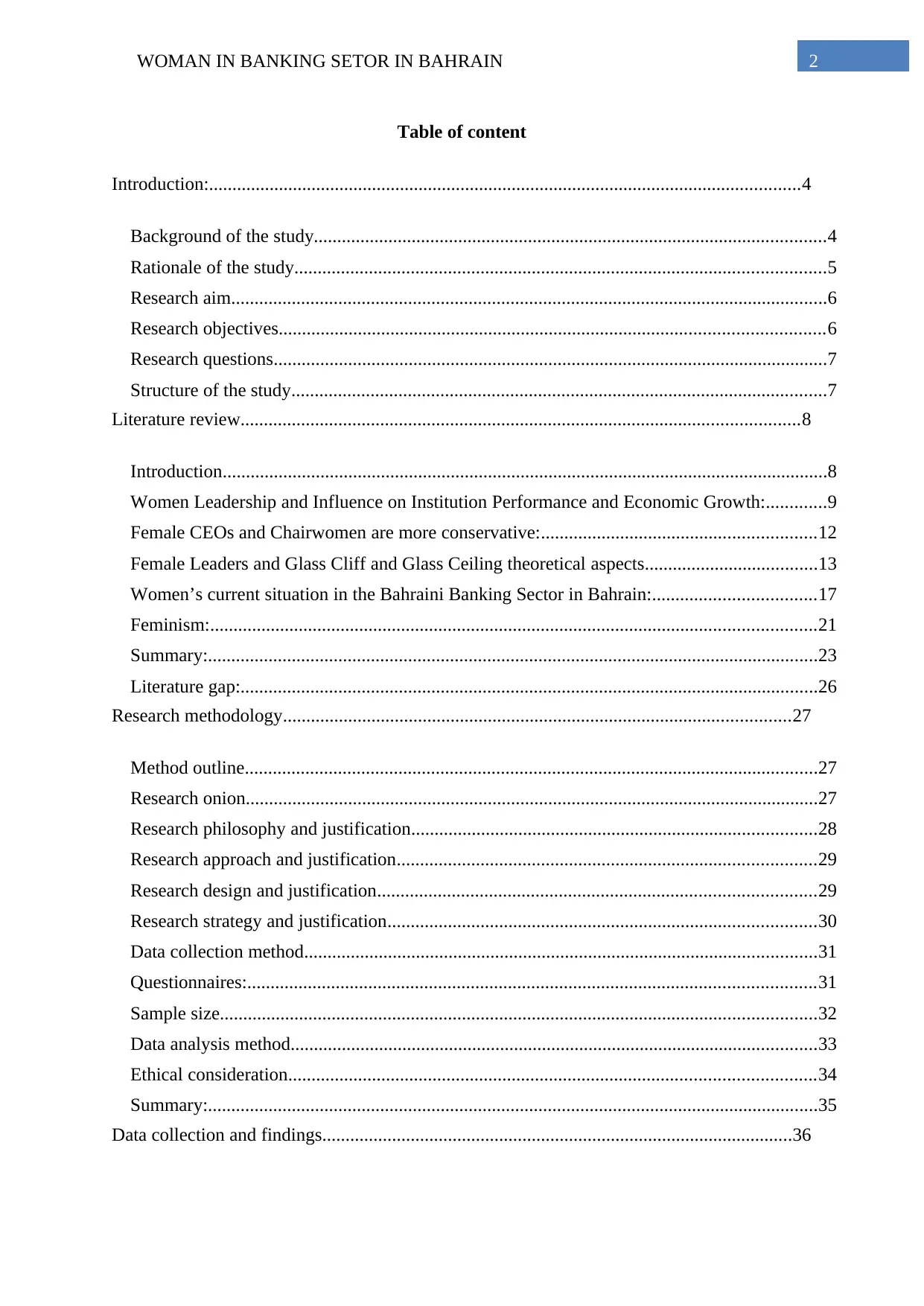
2WOMAN IN BANKING SETOR IN BAHRAIN
Table of content
Introduction:...............................................................................................................................4
Background of the study..............................................................................................................4
Rationale of the study..................................................................................................................5
Research aim................................................................................................................................6
Research objectives.....................................................................................................................6
Research questions.......................................................................................................................7
Structure of the study...................................................................................................................7
Literature review........................................................................................................................8
Introduction..................................................................................................................................8
Women Leadership and Influence on Institution Performance and Economic Growth:.............9
Female CEOs and Chairwomen are more conservative:...........................................................12
Female Leaders and Glass Cliff and Glass Ceiling theoretical aspects.....................................13
Women’s current situation in the Bahraini Banking Sector in Bahrain:...................................17
Feminism:..................................................................................................................................21
Summary:...................................................................................................................................23
Literature gap:............................................................................................................................26
Research methodology.............................................................................................................27
Method outline...........................................................................................................................27
Research onion...........................................................................................................................27
Research philosophy and justification.......................................................................................28
Research approach and justification..........................................................................................29
Research design and justification..............................................................................................29
Research strategy and justification............................................................................................30
Data collection method..............................................................................................................31
Questionnaires:..........................................................................................................................31
Sample size................................................................................................................................32
Data analysis method.................................................................................................................33
Ethical consideration.................................................................................................................34
Summary:...................................................................................................................................35
Data collection and findings.....................................................................................................36
Table of content
Introduction:...............................................................................................................................4
Background of the study..............................................................................................................4
Rationale of the study..................................................................................................................5
Research aim................................................................................................................................6
Research objectives.....................................................................................................................6
Research questions.......................................................................................................................7
Structure of the study...................................................................................................................7
Literature review........................................................................................................................8
Introduction..................................................................................................................................8
Women Leadership and Influence on Institution Performance and Economic Growth:.............9
Female CEOs and Chairwomen are more conservative:...........................................................12
Female Leaders and Glass Cliff and Glass Ceiling theoretical aspects.....................................13
Women’s current situation in the Bahraini Banking Sector in Bahrain:...................................17
Feminism:..................................................................................................................................21
Summary:...................................................................................................................................23
Literature gap:............................................................................................................................26
Research methodology.............................................................................................................27
Method outline...........................................................................................................................27
Research onion...........................................................................................................................27
Research philosophy and justification.......................................................................................28
Research approach and justification..........................................................................................29
Research design and justification..............................................................................................29
Research strategy and justification............................................................................................30
Data collection method..............................................................................................................31
Questionnaires:..........................................................................................................................31
Sample size................................................................................................................................32
Data analysis method.................................................................................................................33
Ethical consideration.................................................................................................................34
Summary:...................................................................................................................................35
Data collection and findings.....................................................................................................36
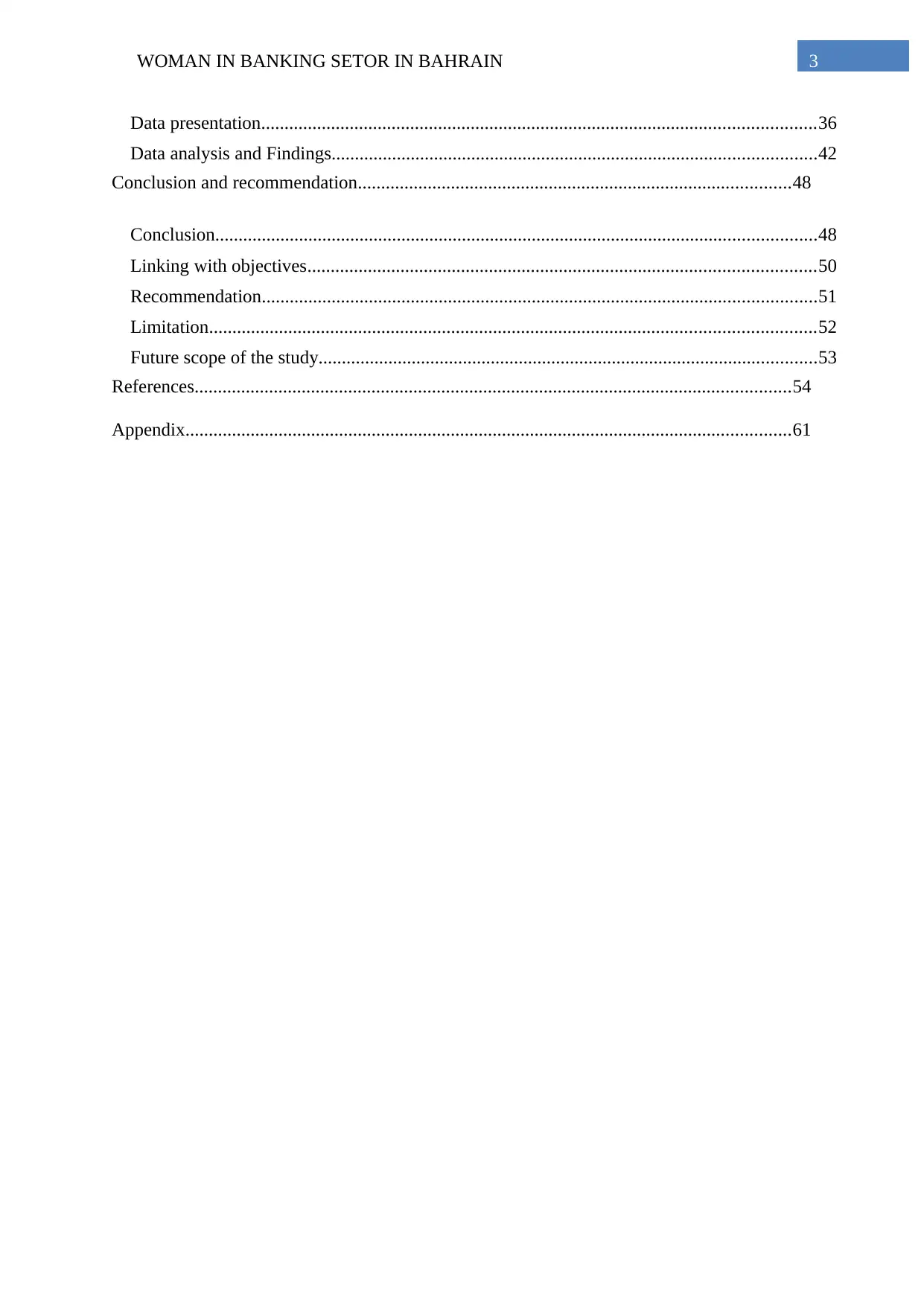
3WOMAN IN BANKING SETOR IN BAHRAIN
Data presentation.......................................................................................................................36
Data analysis and Findings........................................................................................................42
Conclusion and recommendation.............................................................................................48
Conclusion.................................................................................................................................48
Linking with objectives.............................................................................................................50
Recommendation.......................................................................................................................51
Limitation..................................................................................................................................52
Future scope of the study...........................................................................................................53
References................................................................................................................................54
Appendix..................................................................................................................................61
Data presentation.......................................................................................................................36
Data analysis and Findings........................................................................................................42
Conclusion and recommendation.............................................................................................48
Conclusion.................................................................................................................................48
Linking with objectives.............................................................................................................50
Recommendation.......................................................................................................................51
Limitation..................................................................................................................................52
Future scope of the study...........................................................................................................53
References................................................................................................................................54
Appendix..................................................................................................................................61
Secure Best Marks with AI Grader
Need help grading? Try our AI Grader for instant feedback on your assignments.
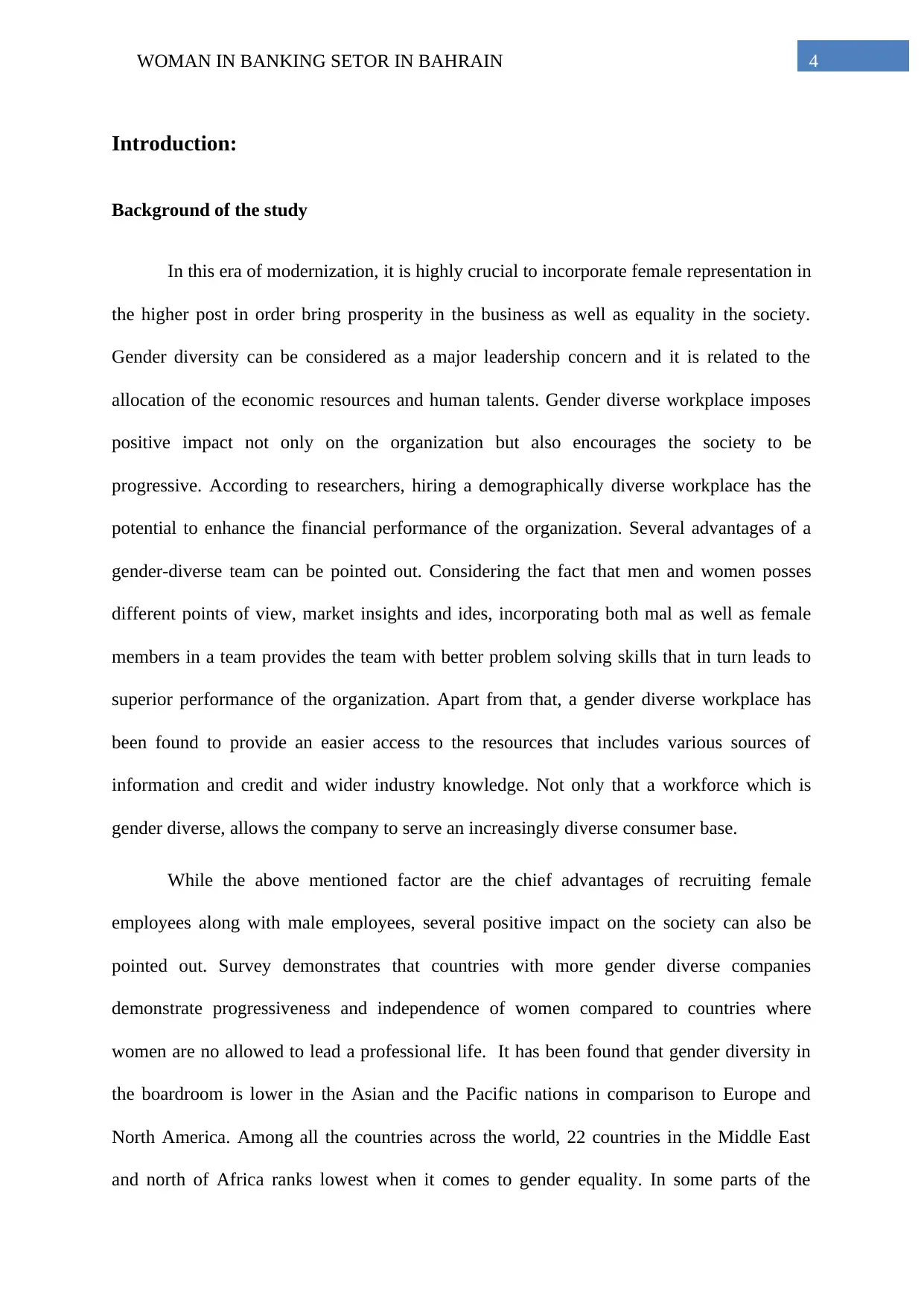
4WOMAN IN BANKING SETOR IN BAHRAIN
Introduction:
Background of the study
In this era of modernization, it is highly crucial to incorporate female representation in
the higher post in order bring prosperity in the business as well as equality in the society.
Gender diversity can be considered as a major leadership concern and it is related to the
allocation of the economic resources and human talents. Gender diverse workplace imposes
positive impact not only on the organization but also encourages the society to be
progressive. According to researchers, hiring a demographically diverse workplace has the
potential to enhance the financial performance of the organization. Several advantages of a
gender-diverse team can be pointed out. Considering the fact that men and women posses
different points of view, market insights and ides, incorporating both mal as well as female
members in a team provides the team with better problem solving skills that in turn leads to
superior performance of the organization. Apart from that, a gender diverse workplace has
been found to provide an easier access to the resources that includes various sources of
information and credit and wider industry knowledge. Not only that a workforce which is
gender diverse, allows the company to serve an increasingly diverse consumer base.
While the above mentioned factor are the chief advantages of recruiting female
employees along with male employees, several positive impact on the society can also be
pointed out. Survey demonstrates that countries with more gender diverse companies
demonstrate progressiveness and independence of women compared to countries where
women are no allowed to lead a professional life. It has been found that gender diversity in
the boardroom is lower in the Asian and the Pacific nations in comparison to Europe and
North America. Among all the countries across the world, 22 countries in the Middle East
and north of Africa ranks lowest when it comes to gender equality. In some parts of the
Introduction:
Background of the study
In this era of modernization, it is highly crucial to incorporate female representation in
the higher post in order bring prosperity in the business as well as equality in the society.
Gender diversity can be considered as a major leadership concern and it is related to the
allocation of the economic resources and human talents. Gender diverse workplace imposes
positive impact not only on the organization but also encourages the society to be
progressive. According to researchers, hiring a demographically diverse workplace has the
potential to enhance the financial performance of the organization. Several advantages of a
gender-diverse team can be pointed out. Considering the fact that men and women posses
different points of view, market insights and ides, incorporating both mal as well as female
members in a team provides the team with better problem solving skills that in turn leads to
superior performance of the organization. Apart from that, a gender diverse workplace has
been found to provide an easier access to the resources that includes various sources of
information and credit and wider industry knowledge. Not only that a workforce which is
gender diverse, allows the company to serve an increasingly diverse consumer base.
While the above mentioned factor are the chief advantages of recruiting female
employees along with male employees, several positive impact on the society can also be
pointed out. Survey demonstrates that countries with more gender diverse companies
demonstrate progressiveness and independence of women compared to countries where
women are no allowed to lead a professional life. It has been found that gender diversity in
the boardroom is lower in the Asian and the Pacific nations in comparison to Europe and
North America. Among all the countries across the world, 22 countries in the Middle East
and north of Africa ranks lowest when it comes to gender equality. In some parts of the
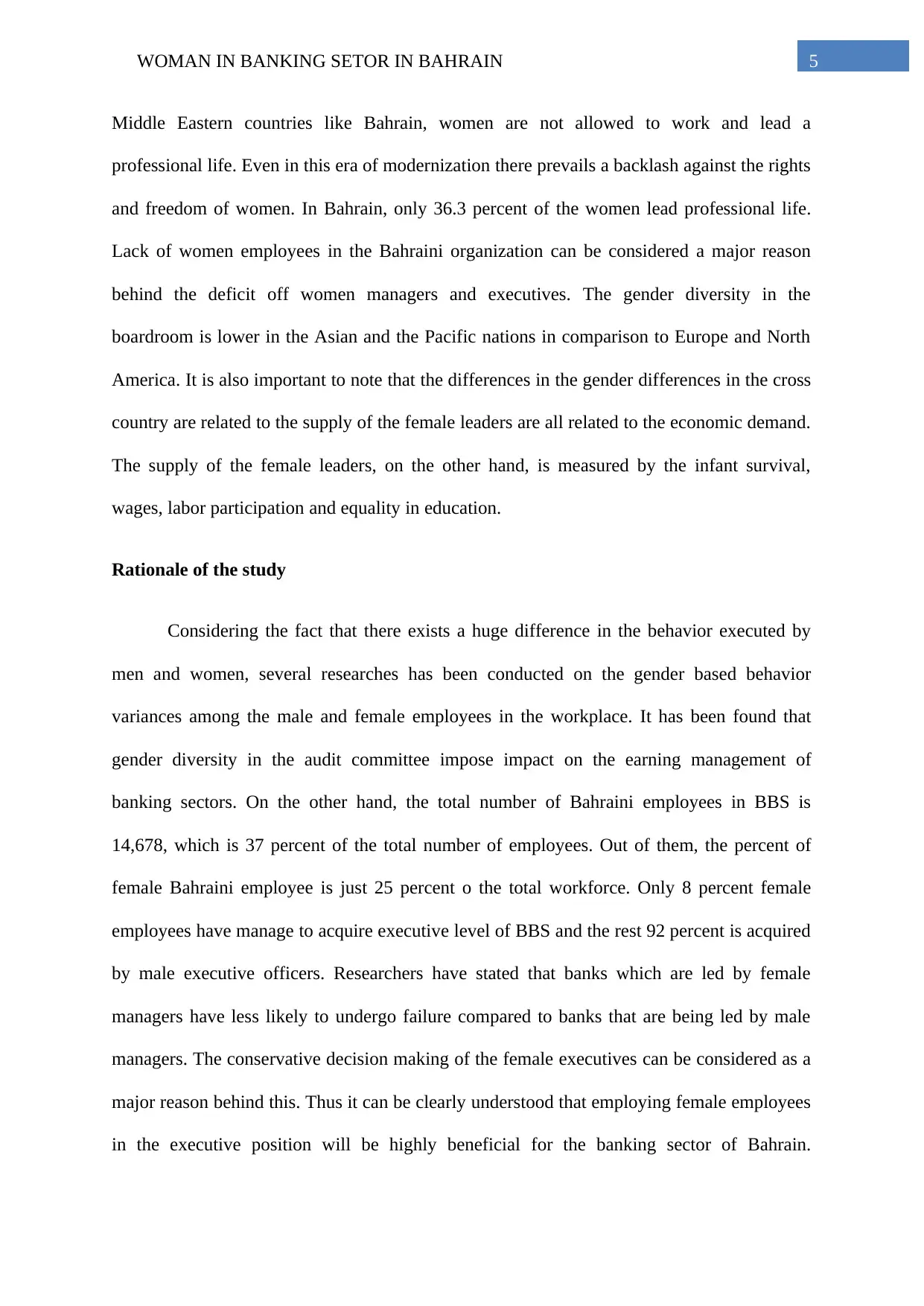
5WOMAN IN BANKING SETOR IN BAHRAIN
Middle Eastern countries like Bahrain, women are not allowed to work and lead a
professional life. Even in this era of modernization there prevails a backlash against the rights
and freedom of women. In Bahrain, only 36.3 percent of the women lead professional life.
Lack of women employees in the Bahraini organization can be considered a major reason
behind the deficit off women managers and executives. The gender diversity in the
boardroom is lower in the Asian and the Pacific nations in comparison to Europe and North
America. It is also important to note that the differences in the gender differences in the cross
country are related to the supply of the female leaders are all related to the economic demand.
The supply of the female leaders, on the other hand, is measured by the infant survival,
wages, labor participation and equality in education.
Rationale of the study
Considering the fact that there exists a huge difference in the behavior executed by
men and women, several researches has been conducted on the gender based behavior
variances among the male and female employees in the workplace. It has been found that
gender diversity in the audit committee impose impact on the earning management of
banking sectors. On the other hand, the total number of Bahraini employees in BBS is
14,678, which is 37 percent of the total number of employees. Out of them, the percent of
female Bahraini employee is just 25 percent o the total workforce. Only 8 percent female
employees have manage to acquire executive level of BBS and the rest 92 percent is acquired
by male executive officers. Researchers have stated that banks which are led by female
managers have less likely to undergo failure compared to banks that are being led by male
managers. The conservative decision making of the female executives can be considered as a
major reason behind this. Thus it can be clearly understood that employing female employees
in the executive position will be highly beneficial for the banking sector of Bahrain.
Middle Eastern countries like Bahrain, women are not allowed to work and lead a
professional life. Even in this era of modernization there prevails a backlash against the rights
and freedom of women. In Bahrain, only 36.3 percent of the women lead professional life.
Lack of women employees in the Bahraini organization can be considered a major reason
behind the deficit off women managers and executives. The gender diversity in the
boardroom is lower in the Asian and the Pacific nations in comparison to Europe and North
America. It is also important to note that the differences in the gender differences in the cross
country are related to the supply of the female leaders are all related to the economic demand.
The supply of the female leaders, on the other hand, is measured by the infant survival,
wages, labor participation and equality in education.
Rationale of the study
Considering the fact that there exists a huge difference in the behavior executed by
men and women, several researches has been conducted on the gender based behavior
variances among the male and female employees in the workplace. It has been found that
gender diversity in the audit committee impose impact on the earning management of
banking sectors. On the other hand, the total number of Bahraini employees in BBS is
14,678, which is 37 percent of the total number of employees. Out of them, the percent of
female Bahraini employee is just 25 percent o the total workforce. Only 8 percent female
employees have manage to acquire executive level of BBS and the rest 92 percent is acquired
by male executive officers. Researchers have stated that banks which are led by female
managers have less likely to undergo failure compared to banks that are being led by male
managers. The conservative decision making of the female executives can be considered as a
major reason behind this. Thus it can be clearly understood that employing female employees
in the executive position will be highly beneficial for the banking sector of Bahrain.
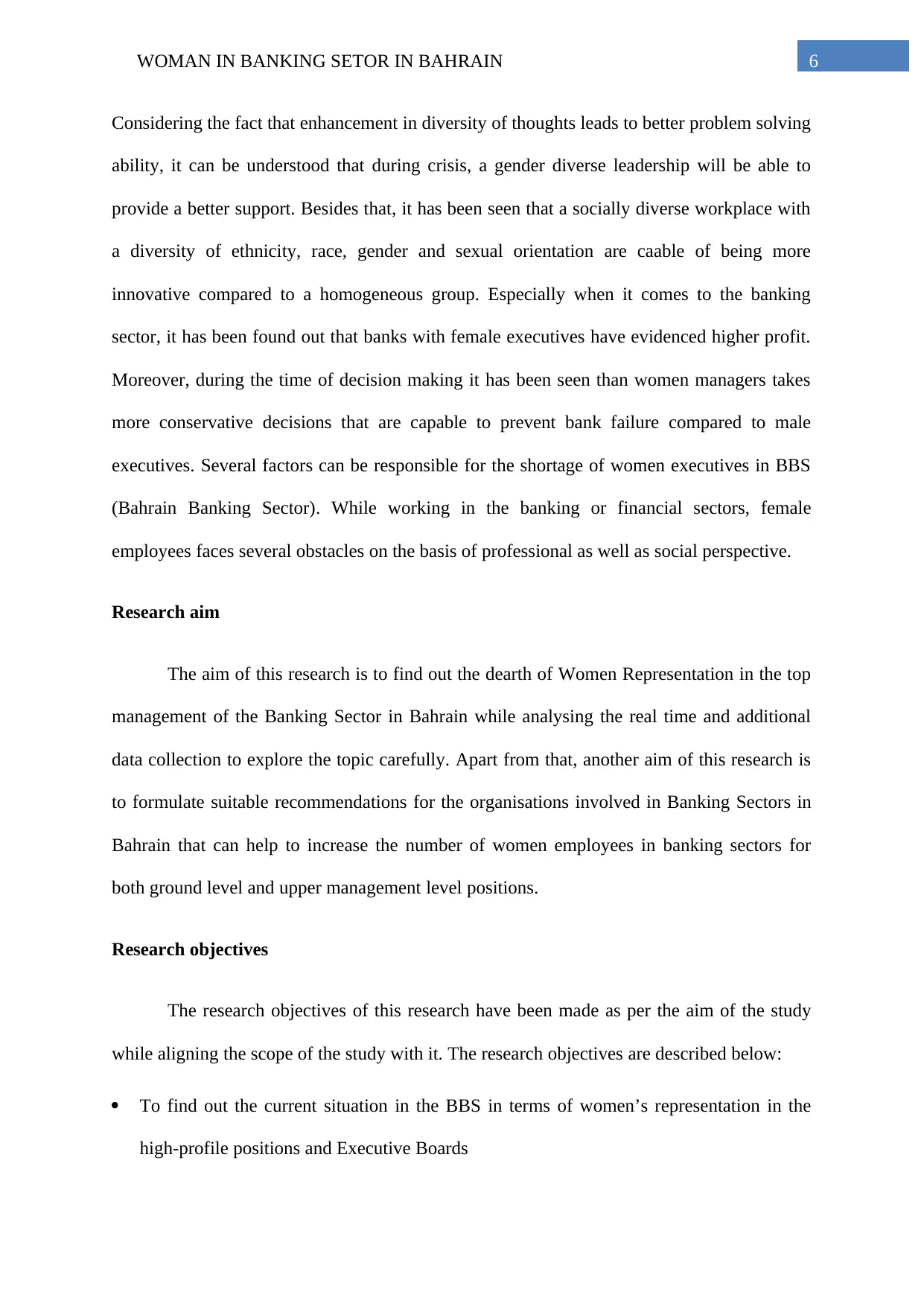
6WOMAN IN BANKING SETOR IN BAHRAIN
Considering the fact that enhancement in diversity of thoughts leads to better problem solving
ability, it can be understood that during crisis, a gender diverse leadership will be able to
provide a better support. Besides that, it has been seen that a socially diverse workplace with
a diversity of ethnicity, race, gender and sexual orientation are caable of being more
innovative compared to a homogeneous group. Especially when it comes to the banking
sector, it has been found out that banks with female executives have evidenced higher profit.
Moreover, during the time of decision making it has been seen than women managers takes
more conservative decisions that are capable to prevent bank failure compared to male
executives. Several factors can be responsible for the shortage of women executives in BBS
(Bahrain Banking Sector). While working in the banking or financial sectors, female
employees faces several obstacles on the basis of professional as well as social perspective.
Research aim
The aim of this research is to find out the dearth of Women Representation in the top
management of the Banking Sector in Bahrain while analysing the real time and additional
data collection to explore the topic carefully. Apart from that, another aim of this research is
to formulate suitable recommendations for the organisations involved in Banking Sectors in
Bahrain that can help to increase the number of women employees in banking sectors for
both ground level and upper management level positions.
Research objectives
The research objectives of this research have been made as per the aim of the study
while aligning the scope of the study with it. The research objectives are described below:
To find out the current situation in the BBS in terms of women’s representation in the
high-profile positions and Executive Boards
Considering the fact that enhancement in diversity of thoughts leads to better problem solving
ability, it can be understood that during crisis, a gender diverse leadership will be able to
provide a better support. Besides that, it has been seen that a socially diverse workplace with
a diversity of ethnicity, race, gender and sexual orientation are caable of being more
innovative compared to a homogeneous group. Especially when it comes to the banking
sector, it has been found out that banks with female executives have evidenced higher profit.
Moreover, during the time of decision making it has been seen than women managers takes
more conservative decisions that are capable to prevent bank failure compared to male
executives. Several factors can be responsible for the shortage of women executives in BBS
(Bahrain Banking Sector). While working in the banking or financial sectors, female
employees faces several obstacles on the basis of professional as well as social perspective.
Research aim
The aim of this research is to find out the dearth of Women Representation in the top
management of the Banking Sector in Bahrain while analysing the real time and additional
data collection to explore the topic carefully. Apart from that, another aim of this research is
to formulate suitable recommendations for the organisations involved in Banking Sectors in
Bahrain that can help to increase the number of women employees in banking sectors for
both ground level and upper management level positions.
Research objectives
The research objectives of this research have been made as per the aim of the study
while aligning the scope of the study with it. The research objectives are described below:
To find out the current situation in the BBS in terms of women’s representation in the
high-profile positions and Executive Boards
Paraphrase This Document
Need a fresh take? Get an instant paraphrase of this document with our AI Paraphraser
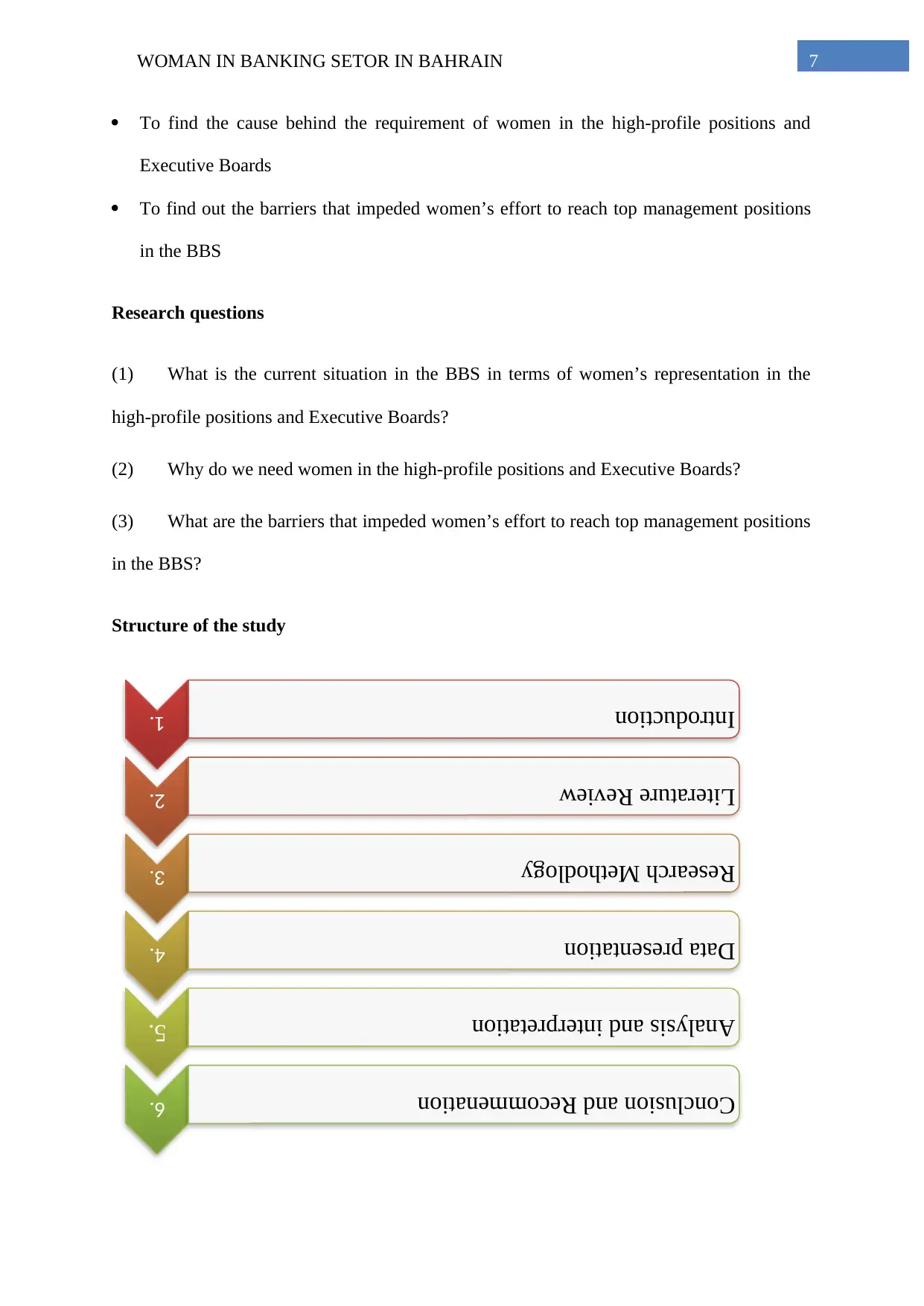
7WOMAN IN BANKING SETOR IN BAHRAIN
To find the cause behind the requirement of women in the high-profile positions and
Executive Boards
To find out the barriers that impeded women’s effort to reach top management positions
in the BBS
Research questions
(1) What is the current situation in the BBS in terms of women’s representation in the
high-profile positions and Executive Boards?
(2) Why do we need women in the high-profile positions and Executive Boards?
(3) What are the barriers that impeded women’s effort to reach top management positions
in the BBS?
Structure of the study
1.Introduction
2.Literature Review
3.Research Methodlogy
4.Data presentation
5.Analysis and interpretation
6.Conclusion and Recommenation
To find the cause behind the requirement of women in the high-profile positions and
Executive Boards
To find out the barriers that impeded women’s effort to reach top management positions
in the BBS
Research questions
(1) What is the current situation in the BBS in terms of women’s representation in the
high-profile positions and Executive Boards?
(2) Why do we need women in the high-profile positions and Executive Boards?
(3) What are the barriers that impeded women’s effort to reach top management positions
in the BBS?
Structure of the study
1.Introduction
2.Literature Review
3.Research Methodlogy
4.Data presentation
5.Analysis and interpretation
6.Conclusion and Recommenation
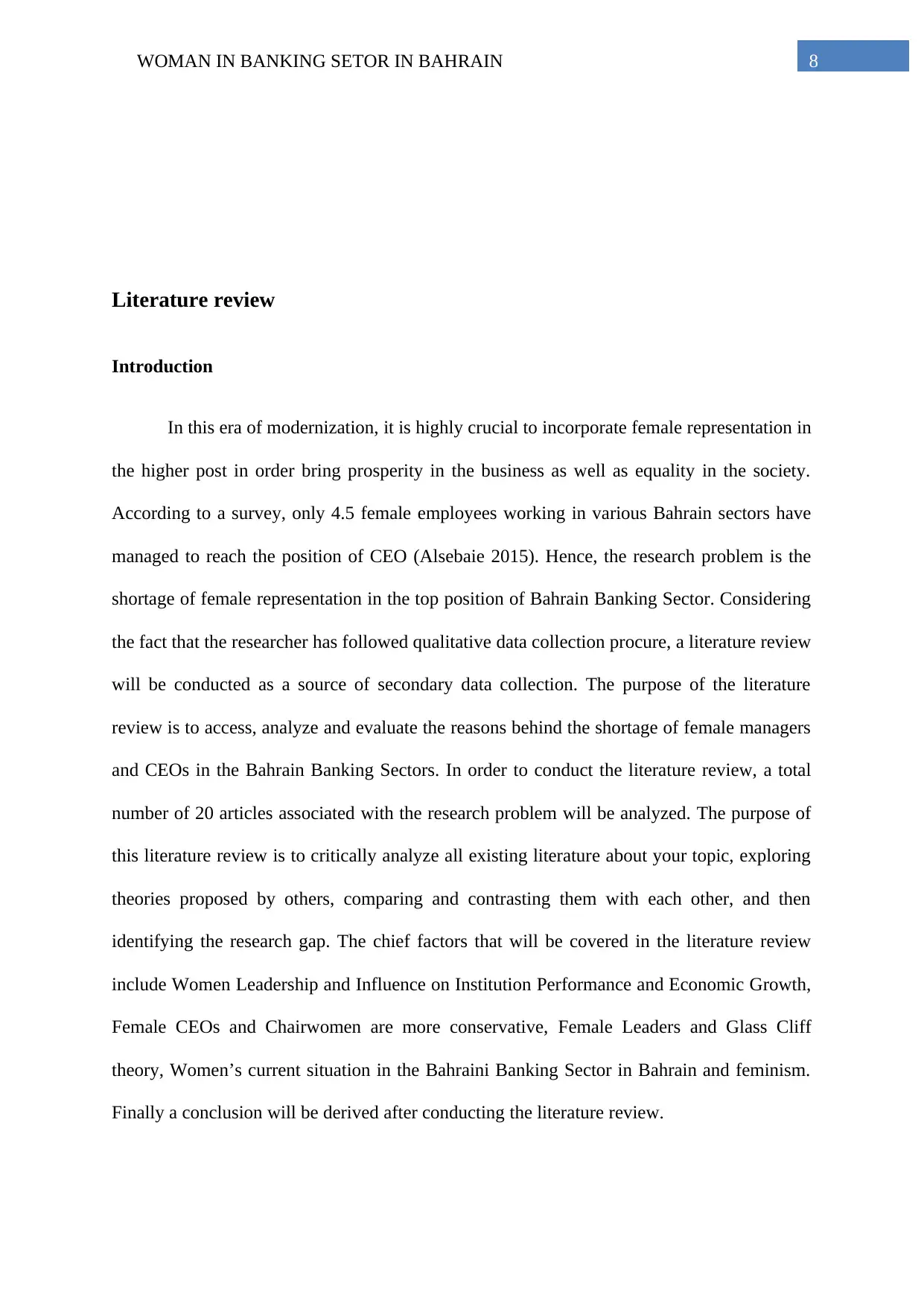
8WOMAN IN BANKING SETOR IN BAHRAIN
Literature review
Introduction
In this era of modernization, it is highly crucial to incorporate female representation in
the higher post in order bring prosperity in the business as well as equality in the society.
According to a survey, only 4.5 female employees working in various Bahrain sectors have
managed to reach the position of CEO (Alsebaie 2015). Hence, the research problem is the
shortage of female representation in the top position of Bahrain Banking Sector. Considering
the fact that the researcher has followed qualitative data collection procure, a literature review
will be conducted as a source of secondary data collection. The purpose of the literature
review is to access, analyze and evaluate the reasons behind the shortage of female managers
and CEOs in the Bahrain Banking Sectors. In order to conduct the literature review, a total
number of 20 articles associated with the research problem will be analyzed. The purpose of
this literature review is to critically analyze all existing literature about your topic, exploring
theories proposed by others, comparing and contrasting them with each other, and then
identifying the research gap. The chief factors that will be covered in the literature review
include Women Leadership and Influence on Institution Performance and Economic Growth,
Female CEOs and Chairwomen are more conservative, Female Leaders and Glass Cliff
theory, Women’s current situation in the Bahraini Banking Sector in Bahrain and feminism.
Finally a conclusion will be derived after conducting the literature review.
Literature review
Introduction
In this era of modernization, it is highly crucial to incorporate female representation in
the higher post in order bring prosperity in the business as well as equality in the society.
According to a survey, only 4.5 female employees working in various Bahrain sectors have
managed to reach the position of CEO (Alsebaie 2015). Hence, the research problem is the
shortage of female representation in the top position of Bahrain Banking Sector. Considering
the fact that the researcher has followed qualitative data collection procure, a literature review
will be conducted as a source of secondary data collection. The purpose of the literature
review is to access, analyze and evaluate the reasons behind the shortage of female managers
and CEOs in the Bahrain Banking Sectors. In order to conduct the literature review, a total
number of 20 articles associated with the research problem will be analyzed. The purpose of
this literature review is to critically analyze all existing literature about your topic, exploring
theories proposed by others, comparing and contrasting them with each other, and then
identifying the research gap. The chief factors that will be covered in the literature review
include Women Leadership and Influence on Institution Performance and Economic Growth,
Female CEOs and Chairwomen are more conservative, Female Leaders and Glass Cliff
theory, Women’s current situation in the Bahraini Banking Sector in Bahrain and feminism.
Finally a conclusion will be derived after conducting the literature review.

9WOMAN IN BANKING SETOR IN BAHRAIN
Women Leadership and Influence on Institution Performance and Economic Growth:
According to Dezsö and Ross (2012), gender diversity can be considered as a major
leadership concern and it is related to the allocation of the economic resources and human
talents. The Asian countries in comparison to the European countries are less proactive in
pressurizing the gender diversity. It is important to note that the data collected from the
western countries are applicable to the data collected from the Asian countries. The prime
reason for such a difference in the data are the economic development, differences in the
demographics and the culture. Gender diversity can be considered as an important topic for
the social development and economic development. It has been argued that Strøm,
D’Espallier and Mersland (2014), that the gender diversity in the boardroom is lower in the
Asian and the Pacific nations in comparison to Europe and North America. The highest
gender diversity is noticed in Australia and in the Republic of Korea, it is lowest. The least
emphasis on the gender diversity in the female boardroom is noticed in the People's Republic
of China, however, the representation of the females has increased in the boardroom.
Malaysia and India are the only countries that had imposed a mandatory quota for the gender
diversity. Studies have shown that at least one female on the board has the capability to
significantly outperform the other companies or organizations. The return on equity (ROE)
and the return on assets (ROA) are positively associated with the appointment of a female
director in the subsequent years. According to Boehe and Cruz (2013), that it is important to
note that there is no predictive power between the financial performance and the gender
diversity after the endogeneity issues are considered. It is also important to note that the
differences in the gender differences in the cross country are related to the supply of the
female leaders are all related to the economic demand. The supply of the female leaders, on
the other hand, is measured by the infant survival, wages, labour participation and equality in
education. However, it is important to note that the gender diversity does not significantly
Women Leadership and Influence on Institution Performance and Economic Growth:
According to Dezsö and Ross (2012), gender diversity can be considered as a major
leadership concern and it is related to the allocation of the economic resources and human
talents. The Asian countries in comparison to the European countries are less proactive in
pressurizing the gender diversity. It is important to note that the data collected from the
western countries are applicable to the data collected from the Asian countries. The prime
reason for such a difference in the data are the economic development, differences in the
demographics and the culture. Gender diversity can be considered as an important topic for
the social development and economic development. It has been argued that Strøm,
D’Espallier and Mersland (2014), that the gender diversity in the boardroom is lower in the
Asian and the Pacific nations in comparison to Europe and North America. The highest
gender diversity is noticed in Australia and in the Republic of Korea, it is lowest. The least
emphasis on the gender diversity in the female boardroom is noticed in the People's Republic
of China, however, the representation of the females has increased in the boardroom.
Malaysia and India are the only countries that had imposed a mandatory quota for the gender
diversity. Studies have shown that at least one female on the board has the capability to
significantly outperform the other companies or organizations. The return on equity (ROE)
and the return on assets (ROA) are positively associated with the appointment of a female
director in the subsequent years. According to Boehe and Cruz (2013), that it is important to
note that there is no predictive power between the financial performance and the gender
diversity after the endogeneity issues are considered. It is also important to note that the
differences in the gender differences in the cross country are related to the supply of the
female leaders are all related to the economic demand. The supply of the female leaders, on
the other hand, is measured by the infant survival, wages, labour participation and equality in
education. However, it is important to note that the gender diversity does not significantly
Secure Best Marks with AI Grader
Need help grading? Try our AI Grader for instant feedback on your assignments.
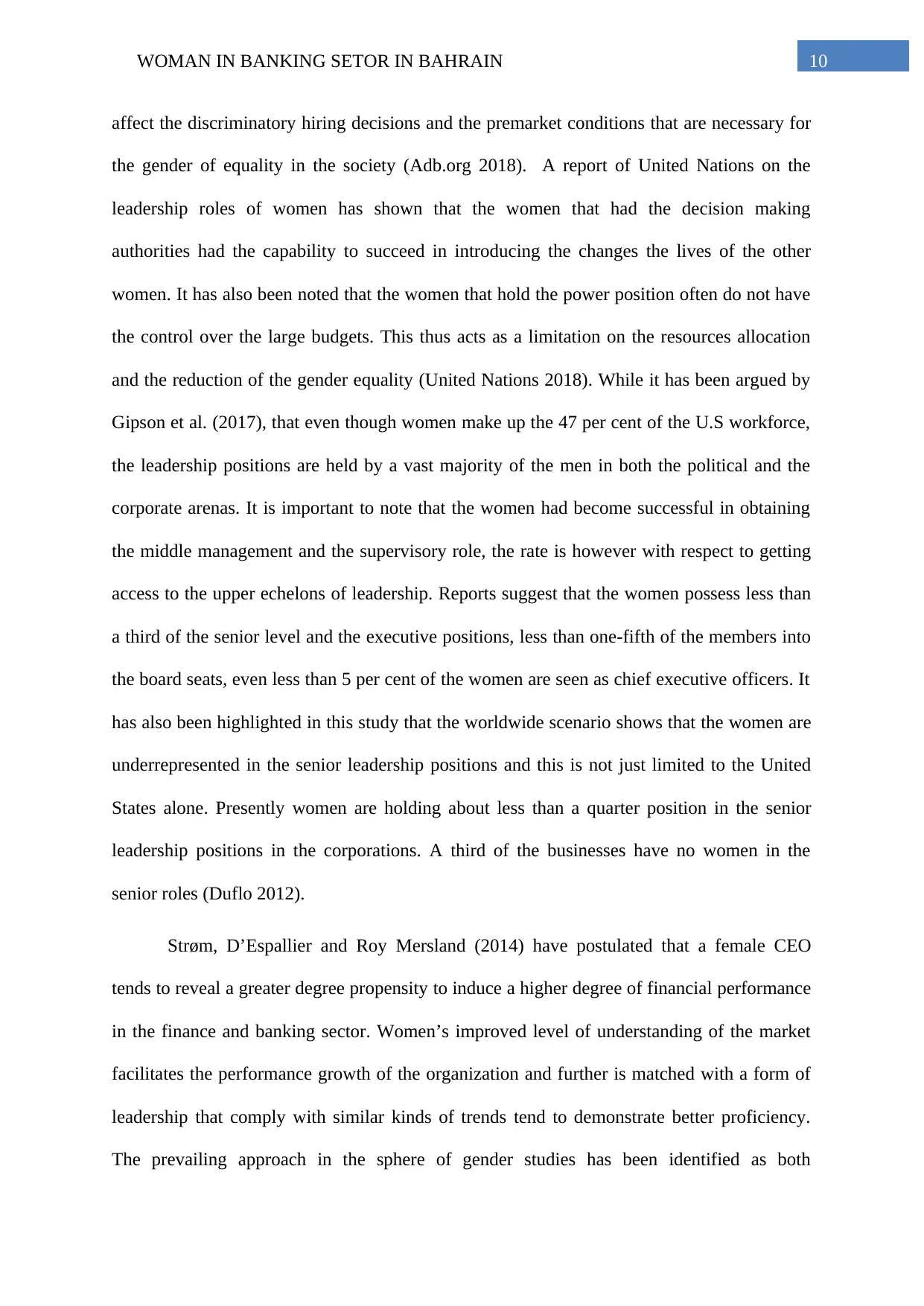
10WOMAN IN BANKING SETOR IN BAHRAIN
affect the discriminatory hiring decisions and the premarket conditions that are necessary for
the gender of equality in the society (Adb.org 2018). A report of United Nations on the
leadership roles of women has shown that the women that had the decision making
authorities had the capability to succeed in introducing the changes the lives of the other
women. It has also been noted that the women that hold the power position often do not have
the control over the large budgets. This thus acts as a limitation on the resources allocation
and the reduction of the gender equality (United Nations 2018). While it has been argued by
Gipson et al. (2017), that even though women make up the 47 per cent of the U.S workforce,
the leadership positions are held by a vast majority of the men in both the political and the
corporate arenas. It is important to note that the women had become successful in obtaining
the middle management and the supervisory role, the rate is however with respect to getting
access to the upper echelons of leadership. Reports suggest that the women possess less than
a third of the senior level and the executive positions, less than one-fifth of the members into
the board seats, even less than 5 per cent of the women are seen as chief executive officers. It
has also been highlighted in this study that the worldwide scenario shows that the women are
underrepresented in the senior leadership positions and this is not just limited to the United
States alone. Presently women are holding about less than a quarter position in the senior
leadership positions in the corporations. A third of the businesses have no women in the
senior roles (Duflo 2012).
Strøm, D’Espallier and Roy Mersland (2014) have postulated that a female CEO
tends to reveal a greater degree propensity to induce a higher degree of financial performance
in the finance and banking sector. Women’s improved level of understanding of the market
facilitates the performance growth of the organization and further is matched with a form of
leadership that comply with similar kinds of trends tend to demonstrate better proficiency.
The prevailing approach in the sphere of gender studies has been identified as both
affect the discriminatory hiring decisions and the premarket conditions that are necessary for
the gender of equality in the society (Adb.org 2018). A report of United Nations on the
leadership roles of women has shown that the women that had the decision making
authorities had the capability to succeed in introducing the changes the lives of the other
women. It has also been noted that the women that hold the power position often do not have
the control over the large budgets. This thus acts as a limitation on the resources allocation
and the reduction of the gender equality (United Nations 2018). While it has been argued by
Gipson et al. (2017), that even though women make up the 47 per cent of the U.S workforce,
the leadership positions are held by a vast majority of the men in both the political and the
corporate arenas. It is important to note that the women had become successful in obtaining
the middle management and the supervisory role, the rate is however with respect to getting
access to the upper echelons of leadership. Reports suggest that the women possess less than
a third of the senior level and the executive positions, less than one-fifth of the members into
the board seats, even less than 5 per cent of the women are seen as chief executive officers. It
has also been highlighted in this study that the worldwide scenario shows that the women are
underrepresented in the senior leadership positions and this is not just limited to the United
States alone. Presently women are holding about less than a quarter position in the senior
leadership positions in the corporations. A third of the businesses have no women in the
senior roles (Duflo 2012).
Strøm, D’Espallier and Roy Mersland (2014) have postulated that a female CEO
tends to reveal a greater degree propensity to induce a higher degree of financial performance
in the finance and banking sector. Women’s improved level of understanding of the market
facilitates the performance growth of the organization and further is matched with a form of
leadership that comply with similar kinds of trends tend to demonstrate better proficiency.
The prevailing approach in the sphere of gender studies has been identified as both
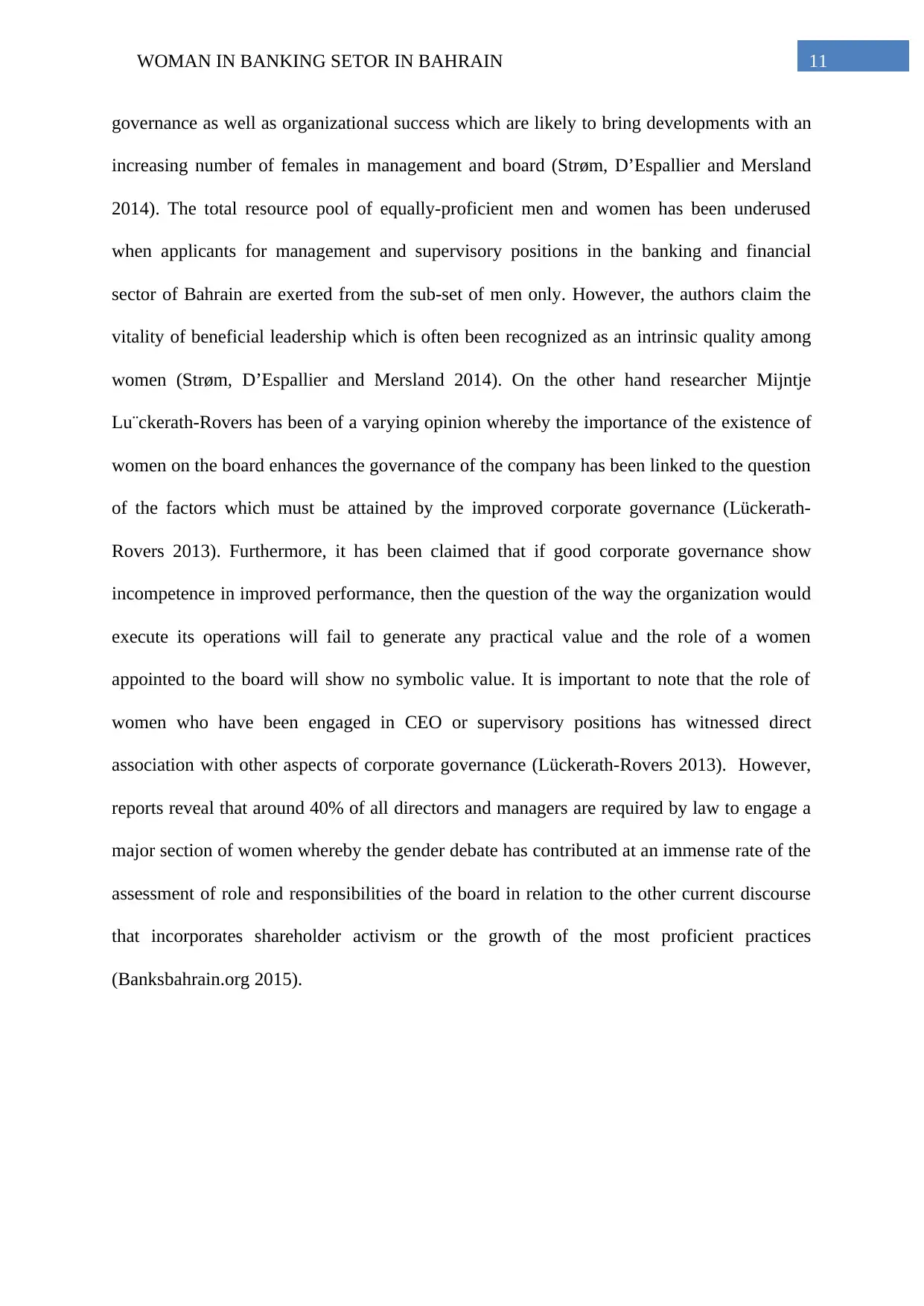
11WOMAN IN BANKING SETOR IN BAHRAIN
governance as well as organizational success which are likely to bring developments with an
increasing number of females in management and board (Strøm, D’Espallier and Mersland
2014). The total resource pool of equally-proficient men and women has been underused
when applicants for management and supervisory positions in the banking and financial
sector of Bahrain are exerted from the sub-set of men only. However, the authors claim the
vitality of beneficial leadership which is often been recognized as an intrinsic quality among
women (Strøm, D’Espallier and Mersland 2014). On the other hand researcher Mijntje
Lu¨ckerath-Rovers has been of a varying opinion whereby the importance of the existence of
women on the board enhances the governance of the company has been linked to the question
of the factors which must be attained by the improved corporate governance (Lückerath-
Rovers 2013). Furthermore, it has been claimed that if good corporate governance show
incompetence in improved performance, then the question of the way the organization would
execute its operations will fail to generate any practical value and the role of a women
appointed to the board will show no symbolic value. It is important to note that the role of
women who have been engaged in CEO or supervisory positions has witnessed direct
association with other aspects of corporate governance (Lückerath-Rovers 2013). However,
reports reveal that around 40% of all directors and managers are required by law to engage a
major section of women whereby the gender debate has contributed at an immense rate of the
assessment of role and responsibilities of the board in relation to the other current discourse
that incorporates shareholder activism or the growth of the most proficient practices
(Banksbahrain.org 2015).
governance as well as organizational success which are likely to bring developments with an
increasing number of females in management and board (Strøm, D’Espallier and Mersland
2014). The total resource pool of equally-proficient men and women has been underused
when applicants for management and supervisory positions in the banking and financial
sector of Bahrain are exerted from the sub-set of men only. However, the authors claim the
vitality of beneficial leadership which is often been recognized as an intrinsic quality among
women (Strøm, D’Espallier and Mersland 2014). On the other hand researcher Mijntje
Lu¨ckerath-Rovers has been of a varying opinion whereby the importance of the existence of
women on the board enhances the governance of the company has been linked to the question
of the factors which must be attained by the improved corporate governance (Lückerath-
Rovers 2013). Furthermore, it has been claimed that if good corporate governance show
incompetence in improved performance, then the question of the way the organization would
execute its operations will fail to generate any practical value and the role of a women
appointed to the board will show no symbolic value. It is important to note that the role of
women who have been engaged in CEO or supervisory positions has witnessed direct
association with other aspects of corporate governance (Lückerath-Rovers 2013). However,
reports reveal that around 40% of all directors and managers are required by law to engage a
major section of women whereby the gender debate has contributed at an immense rate of the
assessment of role and responsibilities of the board in relation to the other current discourse
that incorporates shareholder activism or the growth of the most proficient practices
(Banksbahrain.org 2015).
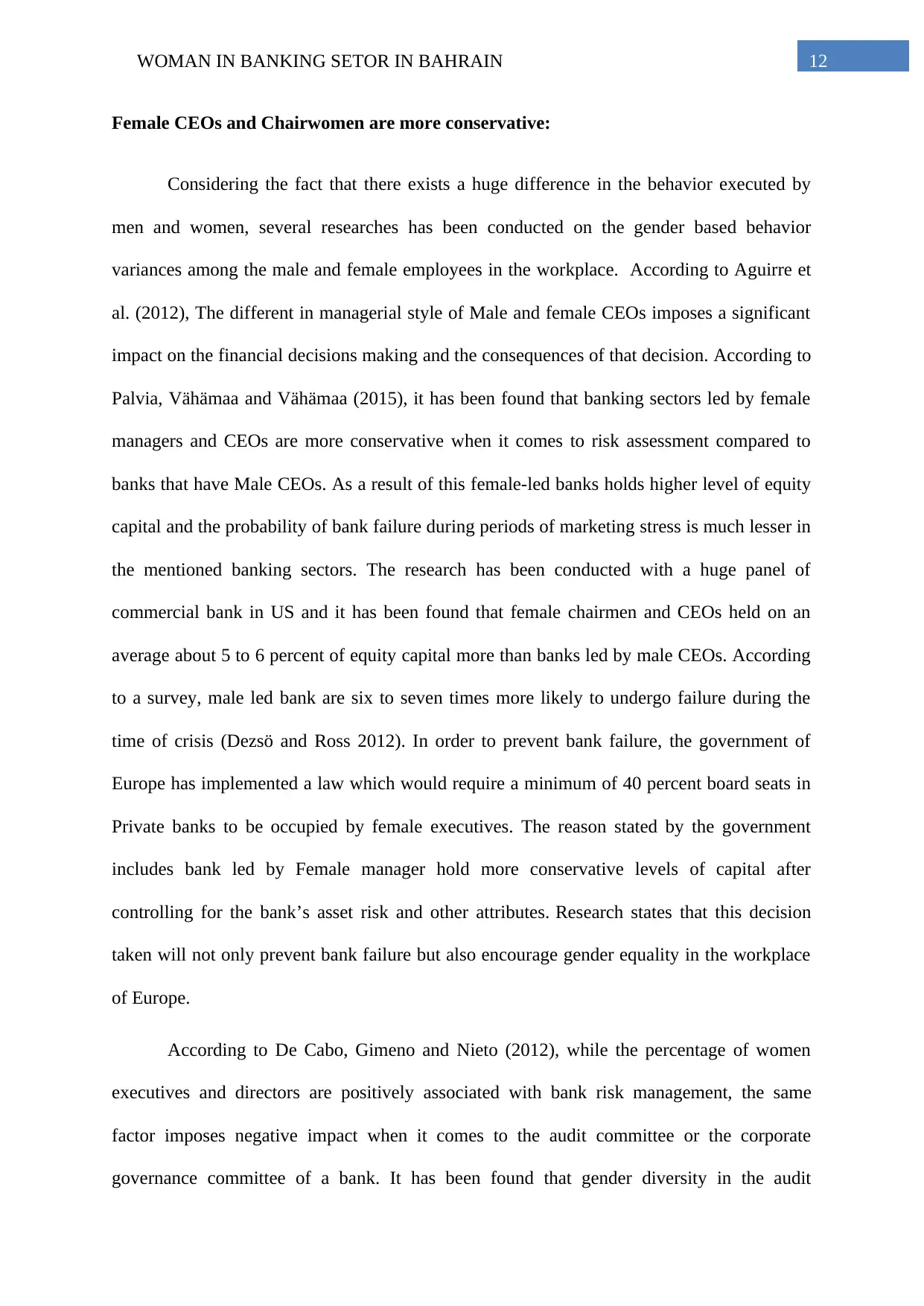
12WOMAN IN BANKING SETOR IN BAHRAIN
Female CEOs and Chairwomen are more conservative:
Considering the fact that there exists a huge difference in the behavior executed by
men and women, several researches has been conducted on the gender based behavior
variances among the male and female employees in the workplace. According to Aguirre et
al. (2012), The different in managerial style of Male and female CEOs imposes a significant
impact on the financial decisions making and the consequences of that decision. According to
Palvia, Vähämaa and Vähämaa (2015), it has been found that banking sectors led by female
managers and CEOs are more conservative when it comes to risk assessment compared to
banks that have Male CEOs. As a result of this female-led banks holds higher level of equity
capital and the probability of bank failure during periods of marketing stress is much lesser in
the mentioned banking sectors. The research has been conducted with a huge panel of
commercial bank in US and it has been found that female chairmen and CEOs held on an
average about 5 to 6 percent of equity capital more than banks led by male CEOs. According
to a survey, male led bank are six to seven times more likely to undergo failure during the
time of crisis (Dezsö and Ross 2012). In order to prevent bank failure, the government of
Europe has implemented a law which would require a minimum of 40 percent board seats in
Private banks to be occupied by female executives. The reason stated by the government
includes bank led by Female manager hold more conservative levels of capital after
controlling for the bank’s asset risk and other attributes. Research states that this decision
taken will not only prevent bank failure but also encourage gender equality in the workplace
of Europe.
According to De Cabo, Gimeno and Nieto (2012), while the percentage of women
executives and directors are positively associated with bank risk management, the same
factor imposes negative impact when it comes to the audit committee or the corporate
governance committee of a bank. It has been found that gender diversity in the audit
Female CEOs and Chairwomen are more conservative:
Considering the fact that there exists a huge difference in the behavior executed by
men and women, several researches has been conducted on the gender based behavior
variances among the male and female employees in the workplace. According to Aguirre et
al. (2012), The different in managerial style of Male and female CEOs imposes a significant
impact on the financial decisions making and the consequences of that decision. According to
Palvia, Vähämaa and Vähämaa (2015), it has been found that banking sectors led by female
managers and CEOs are more conservative when it comes to risk assessment compared to
banks that have Male CEOs. As a result of this female-led banks holds higher level of equity
capital and the probability of bank failure during periods of marketing stress is much lesser in
the mentioned banking sectors. The research has been conducted with a huge panel of
commercial bank in US and it has been found that female chairmen and CEOs held on an
average about 5 to 6 percent of equity capital more than banks led by male CEOs. According
to a survey, male led bank are six to seven times more likely to undergo failure during the
time of crisis (Dezsö and Ross 2012). In order to prevent bank failure, the government of
Europe has implemented a law which would require a minimum of 40 percent board seats in
Private banks to be occupied by female executives. The reason stated by the government
includes bank led by Female manager hold more conservative levels of capital after
controlling for the bank’s asset risk and other attributes. Research states that this decision
taken will not only prevent bank failure but also encourage gender equality in the workplace
of Europe.
According to De Cabo, Gimeno and Nieto (2012), while the percentage of women
executives and directors are positively associated with bank risk management, the same
factor imposes negative impact when it comes to the audit committee or the corporate
governance committee of a bank. It has been found that gender diversity in the audit
Paraphrase This Document
Need a fresh take? Get an instant paraphrase of this document with our AI Paraphraser

13WOMAN IN BANKING SETOR IN BAHRAIN
committee impose impact on the earning management of banking sectors. Presence of female
directors in the audit committee decreases earning management by enhancing negative
discretionary accruals. Lesser number of attendances of the female directors of Auditing
committee in bank compared to that of the male director is considered to be one of the major
reason behind the mentioned issue. It has been found that outsiders are given more preference
for the breadth of their experience in the audit committee of banking sectors in spite of the
fact that the risk preferences of both outsiders and insiders are similar. However, () opined
that the limited amount of risk tolerance in women directors in the audit committee is another
reason behind this preference. According to the researcher the more diverse is a audit team,
more is the diligence of the executives towards their duty (Al-Manasra 2013). On the
contrary, it has been found that women directors and managers prefer to join monitoring
committee and hence more is the number of female executives in the monitoring committee,
better is the performance of the bank.
Aguirre et al. (2012), argued that the performance of the bank increases with the
increment in the number of female employees in the organization. Along with that for female
employees in all positions, the risk of bank failure decreases during the period of financial
crisis. However, when the percentage of female executives increases in the audit committee
of a bank, the variability of the bank performance decreases.
Female Leaders and Glass Cliff and Glass Ceiling theoretical aspects
The glass cliff theory suggests that it is the tendency of the political parties,
organizations and groups to put women in power during the time of crisis when there are high
chances of the occurrence of a failure. There is a very little amount of doubt that women
continue to face a disadvantaged position in the workplace and are found to be
committee impose impact on the earning management of banking sectors. Presence of female
directors in the audit committee decreases earning management by enhancing negative
discretionary accruals. Lesser number of attendances of the female directors of Auditing
committee in bank compared to that of the male director is considered to be one of the major
reason behind the mentioned issue. It has been found that outsiders are given more preference
for the breadth of their experience in the audit committee of banking sectors in spite of the
fact that the risk preferences of both outsiders and insiders are similar. However, () opined
that the limited amount of risk tolerance in women directors in the audit committee is another
reason behind this preference. According to the researcher the more diverse is a audit team,
more is the diligence of the executives towards their duty (Al-Manasra 2013). On the
contrary, it has been found that women directors and managers prefer to join monitoring
committee and hence more is the number of female executives in the monitoring committee,
better is the performance of the bank.
Aguirre et al. (2012), argued that the performance of the bank increases with the
increment in the number of female employees in the organization. Along with that for female
employees in all positions, the risk of bank failure decreases during the period of financial
crisis. However, when the percentage of female executives increases in the audit committee
of a bank, the variability of the bank performance decreases.
Female Leaders and Glass Cliff and Glass Ceiling theoretical aspects
The glass cliff theory suggests that it is the tendency of the political parties,
organizations and groups to put women in power during the time of crisis when there are high
chances of the occurrence of a failure. There is a very little amount of doubt that women
continue to face a disadvantaged position in the workplace and are found to be
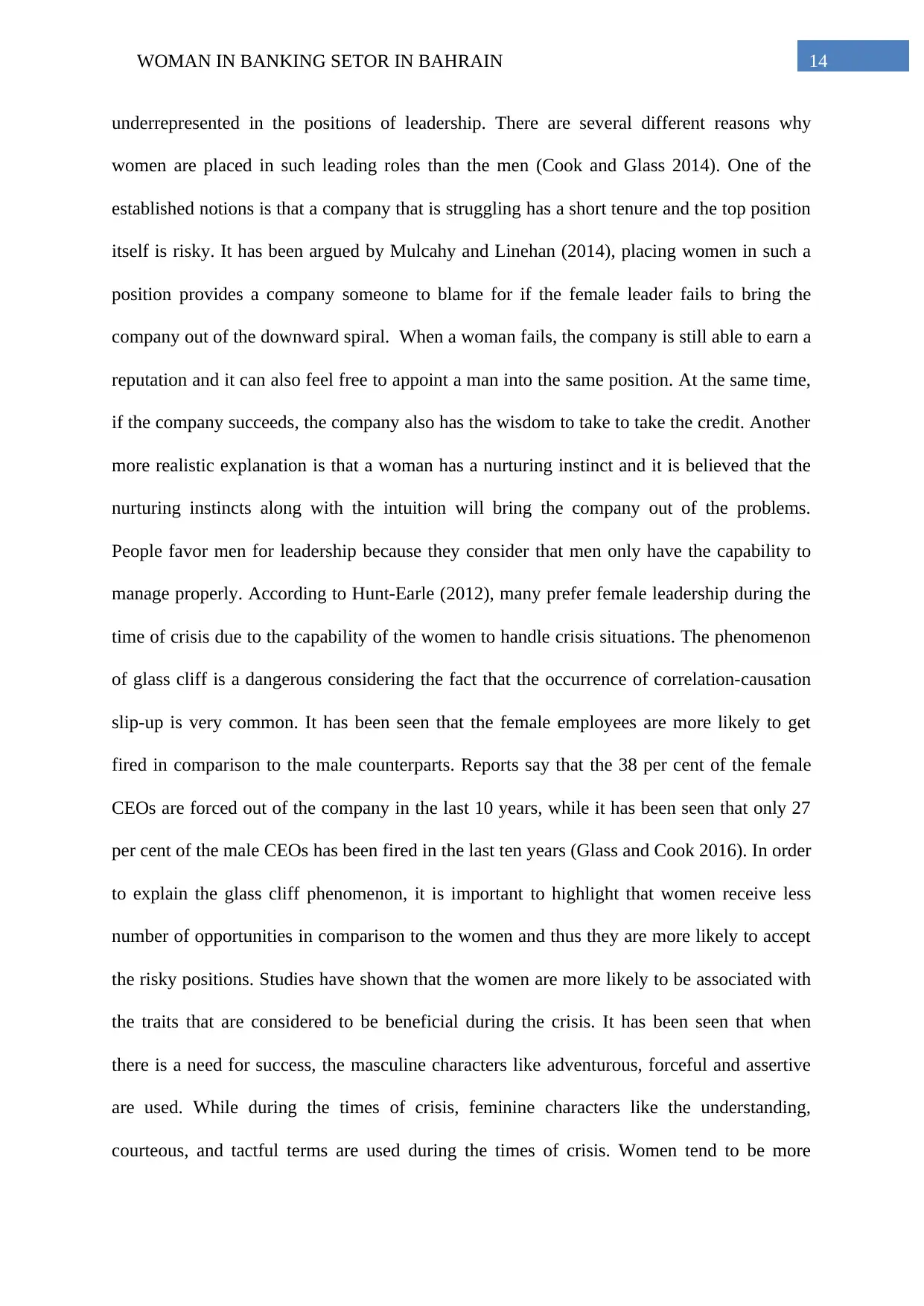
14WOMAN IN BANKING SETOR IN BAHRAIN
underrepresented in the positions of leadership. There are several different reasons why
women are placed in such leading roles than the men (Cook and Glass 2014). One of the
established notions is that a company that is struggling has a short tenure and the top position
itself is risky. It has been argued by Mulcahy and Linehan (2014), placing women in such a
position provides a company someone to blame for if the female leader fails to bring the
company out of the downward spiral. When a woman fails, the company is still able to earn a
reputation and it can also feel free to appoint a man into the same position. At the same time,
if the company succeeds, the company also has the wisdom to take to take the credit. Another
more realistic explanation is that a woman has a nurturing instinct and it is believed that the
nurturing instincts along with the intuition will bring the company out of the problems.
People favor men for leadership because they consider that men only have the capability to
manage properly. According to Hunt‐Earle (2012), many prefer female leadership during the
time of crisis due to the capability of the women to handle crisis situations. The phenomenon
of glass cliff is a dangerous considering the fact that the occurrence of correlation-causation
slip-up is very common. It has been seen that the female employees are more likely to get
fired in comparison to the male counterparts. Reports say that the 38 per cent of the female
CEOs are forced out of the company in the last 10 years, while it has been seen that only 27
per cent of the male CEOs has been fired in the last ten years (Glass and Cook 2016). In order
to explain the glass cliff phenomenon, it is important to highlight that women receive less
number of opportunities in comparison to the women and thus they are more likely to accept
the risky positions. Studies have shown that the women are more likely to be associated with
the traits that are considered to be beneficial during the crisis. It has been seen that when
there is a need for success, the masculine characters like adventurous, forceful and assertive
are used. While during the times of crisis, feminine characters like the understanding,
courteous, and tactful terms are used during the times of crisis. Women tend to be more
underrepresented in the positions of leadership. There are several different reasons why
women are placed in such leading roles than the men (Cook and Glass 2014). One of the
established notions is that a company that is struggling has a short tenure and the top position
itself is risky. It has been argued by Mulcahy and Linehan (2014), placing women in such a
position provides a company someone to blame for if the female leader fails to bring the
company out of the downward spiral. When a woman fails, the company is still able to earn a
reputation and it can also feel free to appoint a man into the same position. At the same time,
if the company succeeds, the company also has the wisdom to take to take the credit. Another
more realistic explanation is that a woman has a nurturing instinct and it is believed that the
nurturing instincts along with the intuition will bring the company out of the problems.
People favor men for leadership because they consider that men only have the capability to
manage properly. According to Hunt‐Earle (2012), many prefer female leadership during the
time of crisis due to the capability of the women to handle crisis situations. The phenomenon
of glass cliff is a dangerous considering the fact that the occurrence of correlation-causation
slip-up is very common. It has been seen that the female employees are more likely to get
fired in comparison to the male counterparts. Reports say that the 38 per cent of the female
CEOs are forced out of the company in the last 10 years, while it has been seen that only 27
per cent of the male CEOs has been fired in the last ten years (Glass and Cook 2016). In order
to explain the glass cliff phenomenon, it is important to highlight that women receive less
number of opportunities in comparison to the women and thus they are more likely to accept
the risky positions. Studies have shown that the women are more likely to be associated with
the traits that are considered to be beneficial during the crisis. It has been seen that when
there is a need for success, the masculine characters like adventurous, forceful and assertive
are used. While during the times of crisis, feminine characters like the understanding,
courteous, and tactful terms are used during the times of crisis. Women tend to be more
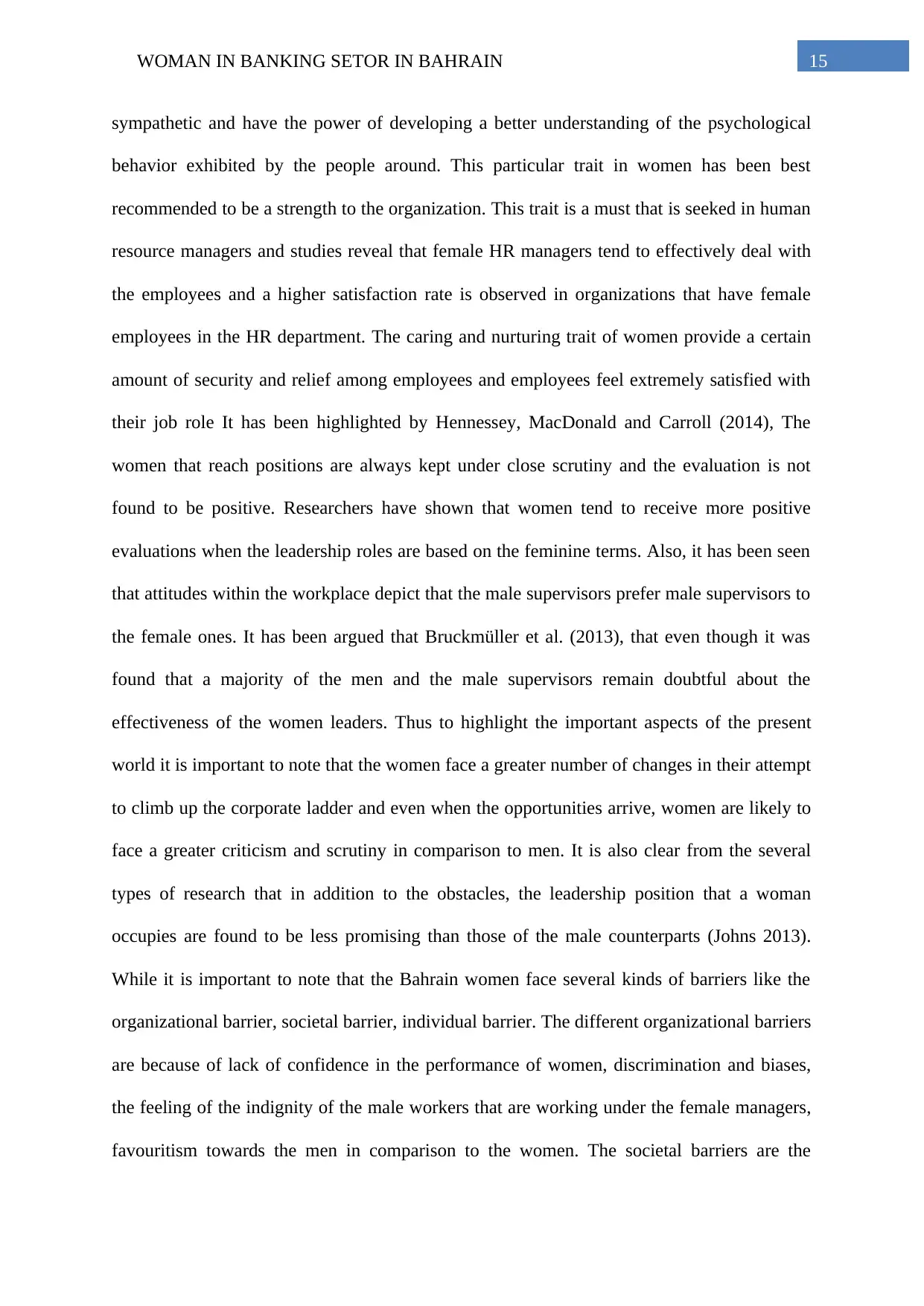
15WOMAN IN BANKING SETOR IN BAHRAIN
sympathetic and have the power of developing a better understanding of the psychological
behavior exhibited by the people around. This particular trait in women has been best
recommended to be a strength to the organization. This trait is a must that is seeked in human
resource managers and studies reveal that female HR managers tend to effectively deal with
the employees and a higher satisfaction rate is observed in organizations that have female
employees in the HR department. The caring and nurturing trait of women provide a certain
amount of security and relief among employees and employees feel extremely satisfied with
their job role It has been highlighted by Hennessey, MacDonald and Carroll (2014), The
women that reach positions are always kept under close scrutiny and the evaluation is not
found to be positive. Researchers have shown that women tend to receive more positive
evaluations when the leadership roles are based on the feminine terms. Also, it has been seen
that attitudes within the workplace depict that the male supervisors prefer male supervisors to
the female ones. It has been argued that Bruckmüller et al. (2013), that even though it was
found that a majority of the men and the male supervisors remain doubtful about the
effectiveness of the women leaders. Thus to highlight the important aspects of the present
world it is important to note that the women face a greater number of changes in their attempt
to climb up the corporate ladder and even when the opportunities arrive, women are likely to
face a greater criticism and scrutiny in comparison to men. It is also clear from the several
types of research that in addition to the obstacles, the leadership position that a woman
occupies are found to be less promising than those of the male counterparts (Johns 2013).
While it is important to note that the Bahrain women face several kinds of barriers like the
organizational barrier, societal barrier, individual barrier. The different organizational barriers
are because of lack of confidence in the performance of women, discrimination and biases,
the feeling of the indignity of the male workers that are working under the female managers,
favouritism towards the men in comparison to the women. The societal barriers are the
sympathetic and have the power of developing a better understanding of the psychological
behavior exhibited by the people around. This particular trait in women has been best
recommended to be a strength to the organization. This trait is a must that is seeked in human
resource managers and studies reveal that female HR managers tend to effectively deal with
the employees and a higher satisfaction rate is observed in organizations that have female
employees in the HR department. The caring and nurturing trait of women provide a certain
amount of security and relief among employees and employees feel extremely satisfied with
their job role It has been highlighted by Hennessey, MacDonald and Carroll (2014), The
women that reach positions are always kept under close scrutiny and the evaluation is not
found to be positive. Researchers have shown that women tend to receive more positive
evaluations when the leadership roles are based on the feminine terms. Also, it has been seen
that attitudes within the workplace depict that the male supervisors prefer male supervisors to
the female ones. It has been argued that Bruckmüller et al. (2013), that even though it was
found that a majority of the men and the male supervisors remain doubtful about the
effectiveness of the women leaders. Thus to highlight the important aspects of the present
world it is important to note that the women face a greater number of changes in their attempt
to climb up the corporate ladder and even when the opportunities arrive, women are likely to
face a greater criticism and scrutiny in comparison to men. It is also clear from the several
types of research that in addition to the obstacles, the leadership position that a woman
occupies are found to be less promising than those of the male counterparts (Johns 2013).
While it is important to note that the Bahrain women face several kinds of barriers like the
organizational barrier, societal barrier, individual barrier. The different organizational barriers
are because of lack of confidence in the performance of women, discrimination and biases,
the feeling of the indignity of the male workers that are working under the female managers,
favouritism towards the men in comparison to the women. The societal barriers are the
Secure Best Marks with AI Grader
Need help grading? Try our AI Grader for instant feedback on your assignments.
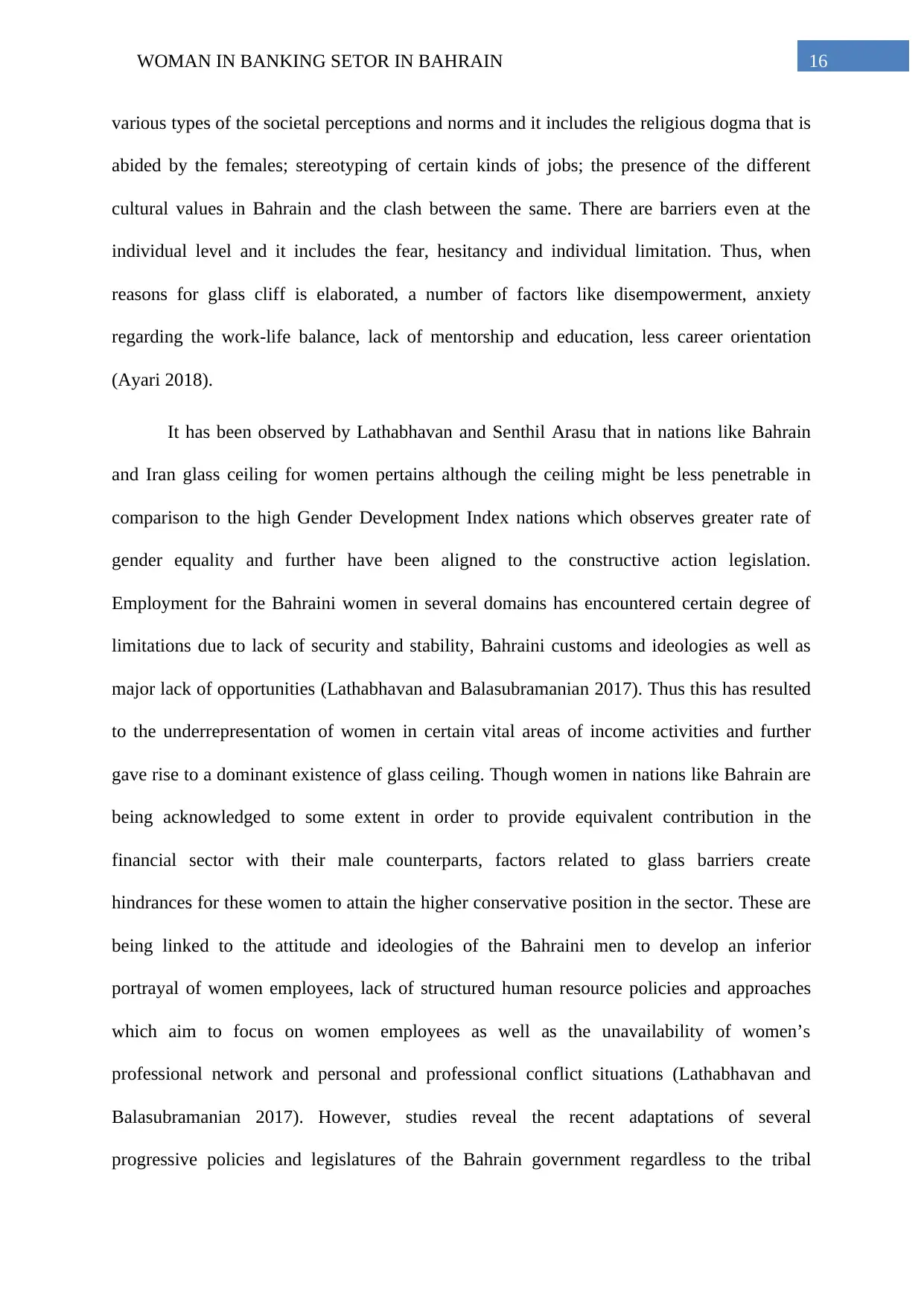
16WOMAN IN BANKING SETOR IN BAHRAIN
various types of the societal perceptions and norms and it includes the religious dogma that is
abided by the females; stereotyping of certain kinds of jobs; the presence of the different
cultural values in Bahrain and the clash between the same. There are barriers even at the
individual level and it includes the fear, hesitancy and individual limitation. Thus, when
reasons for glass cliff is elaborated, a number of factors like disempowerment, anxiety
regarding the work-life balance, lack of mentorship and education, less career orientation
(Ayari 2018).
It has been observed by Lathabhavan and Senthil Arasu that in nations like Bahrain
and Iran glass ceiling for women pertains although the ceiling might be less penetrable in
comparison to the high Gender Development Index nations which observes greater rate of
gender equality and further have been aligned to the constructive action legislation.
Employment for the Bahraini women in several domains has encountered certain degree of
limitations due to lack of security and stability, Bahraini customs and ideologies as well as
major lack of opportunities (Lathabhavan and Balasubramanian 2017). Thus this has resulted
to the underrepresentation of women in certain vital areas of income activities and further
gave rise to a dominant existence of glass ceiling. Though women in nations like Bahrain are
being acknowledged to some extent in order to provide equivalent contribution in the
financial sector with their male counterparts, factors related to glass barriers create
hindrances for these women to attain the higher conservative position in the sector. These are
being linked to the attitude and ideologies of the Bahraini men to develop an inferior
portrayal of women employees, lack of structured human resource policies and approaches
which aim to focus on women employees as well as the unavailability of women’s
professional network and personal and professional conflict situations (Lathabhavan and
Balasubramanian 2017). However, studies reveal the recent adaptations of several
progressive policies and legislatures of the Bahrain government regardless to the tribal
various types of the societal perceptions and norms and it includes the religious dogma that is
abided by the females; stereotyping of certain kinds of jobs; the presence of the different
cultural values in Bahrain and the clash between the same. There are barriers even at the
individual level and it includes the fear, hesitancy and individual limitation. Thus, when
reasons for glass cliff is elaborated, a number of factors like disempowerment, anxiety
regarding the work-life balance, lack of mentorship and education, less career orientation
(Ayari 2018).
It has been observed by Lathabhavan and Senthil Arasu that in nations like Bahrain
and Iran glass ceiling for women pertains although the ceiling might be less penetrable in
comparison to the high Gender Development Index nations which observes greater rate of
gender equality and further have been aligned to the constructive action legislation.
Employment for the Bahraini women in several domains has encountered certain degree of
limitations due to lack of security and stability, Bahraini customs and ideologies as well as
major lack of opportunities (Lathabhavan and Balasubramanian 2017). Thus this has resulted
to the underrepresentation of women in certain vital areas of income activities and further
gave rise to a dominant existence of glass ceiling. Though women in nations like Bahrain are
being acknowledged to some extent in order to provide equivalent contribution in the
financial sector with their male counterparts, factors related to glass barriers create
hindrances for these women to attain the higher conservative position in the sector. These are
being linked to the attitude and ideologies of the Bahraini men to develop an inferior
portrayal of women employees, lack of structured human resource policies and approaches
which aim to focus on women employees as well as the unavailability of women’s
professional network and personal and professional conflict situations (Lathabhavan and
Balasubramanian 2017). However, studies reveal the recent adaptations of several
progressive policies and legislatures of the Bahrain government regardless to the tribal
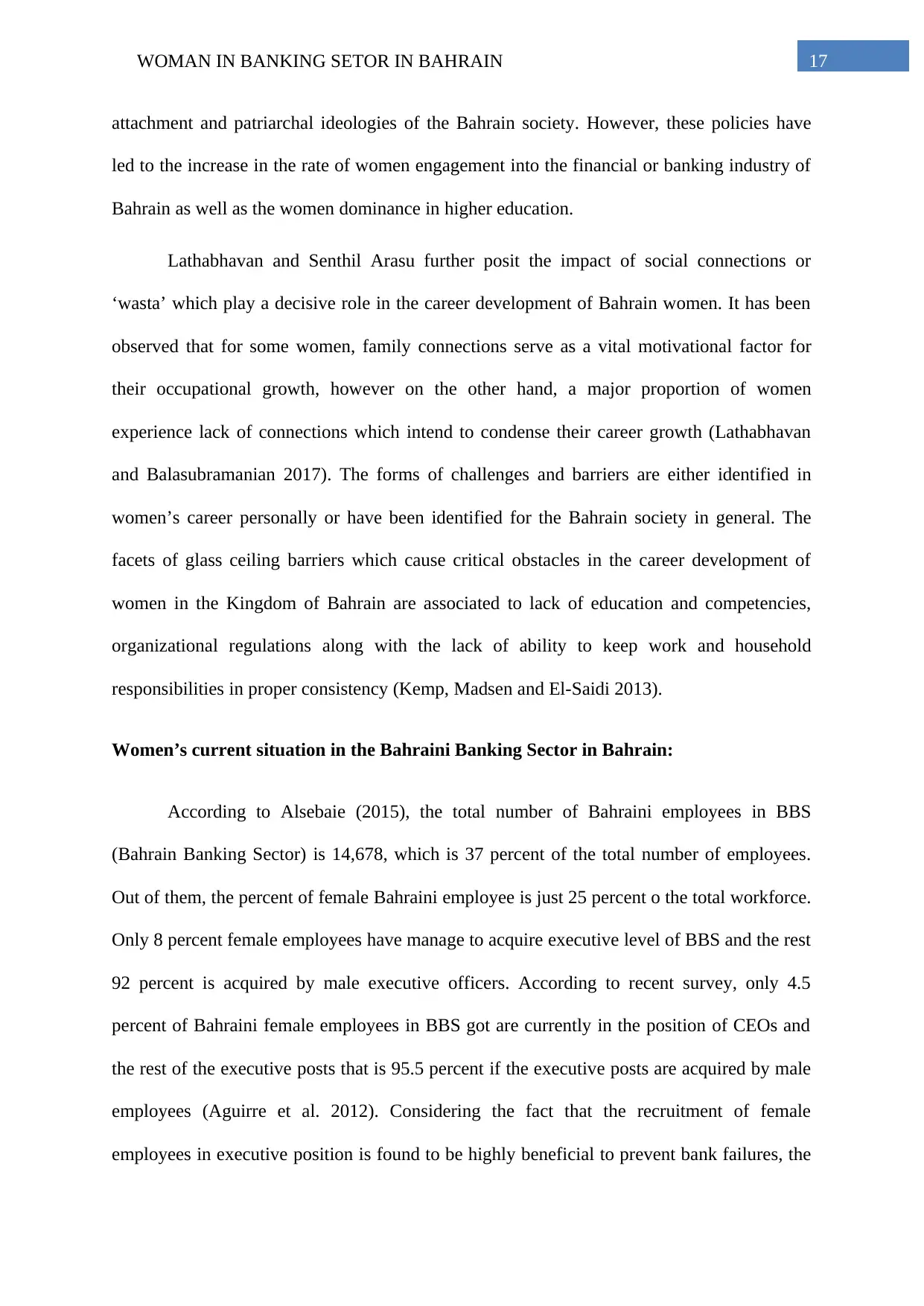
17WOMAN IN BANKING SETOR IN BAHRAIN
attachment and patriarchal ideologies of the Bahrain society. However, these policies have
led to the increase in the rate of women engagement into the financial or banking industry of
Bahrain as well as the women dominance in higher education.
Lathabhavan and Senthil Arasu further posit the impact of social connections or
‘wasta’ which play a decisive role in the career development of Bahrain women. It has been
observed that for some women, family connections serve as a vital motivational factor for
their occupational growth, however on the other hand, a major proportion of women
experience lack of connections which intend to condense their career growth (Lathabhavan
and Balasubramanian 2017). The forms of challenges and barriers are either identified in
women’s career personally or have been identified for the Bahrain society in general. The
facets of glass ceiling barriers which cause critical obstacles in the career development of
women in the Kingdom of Bahrain are associated to lack of education and competencies,
organizational regulations along with the lack of ability to keep work and household
responsibilities in proper consistency (Kemp, Madsen and El-Saidi 2013).
Women’s current situation in the Bahraini Banking Sector in Bahrain:
According to Alsebaie (2015), the total number of Bahraini employees in BBS
(Bahrain Banking Sector) is 14,678, which is 37 percent of the total number of employees.
Out of them, the percent of female Bahraini employee is just 25 percent o the total workforce.
Only 8 percent female employees have manage to acquire executive level of BBS and the rest
92 percent is acquired by male executive officers. According to recent survey, only 4.5
percent of Bahraini female employees in BBS got are currently in the position of CEOs and
the rest of the executive posts that is 95.5 percent if the executive posts are acquired by male
employees (Aguirre et al. 2012). Considering the fact that the recruitment of female
employees in executive position is found to be highly beneficial to prevent bank failures, the
attachment and patriarchal ideologies of the Bahrain society. However, these policies have
led to the increase in the rate of women engagement into the financial or banking industry of
Bahrain as well as the women dominance in higher education.
Lathabhavan and Senthil Arasu further posit the impact of social connections or
‘wasta’ which play a decisive role in the career development of Bahrain women. It has been
observed that for some women, family connections serve as a vital motivational factor for
their occupational growth, however on the other hand, a major proportion of women
experience lack of connections which intend to condense their career growth (Lathabhavan
and Balasubramanian 2017). The forms of challenges and barriers are either identified in
women’s career personally or have been identified for the Bahrain society in general. The
facets of glass ceiling barriers which cause critical obstacles in the career development of
women in the Kingdom of Bahrain are associated to lack of education and competencies,
organizational regulations along with the lack of ability to keep work and household
responsibilities in proper consistency (Kemp, Madsen and El-Saidi 2013).
Women’s current situation in the Bahraini Banking Sector in Bahrain:
According to Alsebaie (2015), the total number of Bahraini employees in BBS
(Bahrain Banking Sector) is 14,678, which is 37 percent of the total number of employees.
Out of them, the percent of female Bahraini employee is just 25 percent o the total workforce.
Only 8 percent female employees have manage to acquire executive level of BBS and the rest
92 percent is acquired by male executive officers. According to recent survey, only 4.5
percent of Bahraini female employees in BBS got are currently in the position of CEOs and
the rest of the executive posts that is 95.5 percent if the executive posts are acquired by male
employees (Aguirre et al. 2012). Considering the fact that the recruitment of female
employees in executive position is found to be highly beneficial to prevent bank failures, the
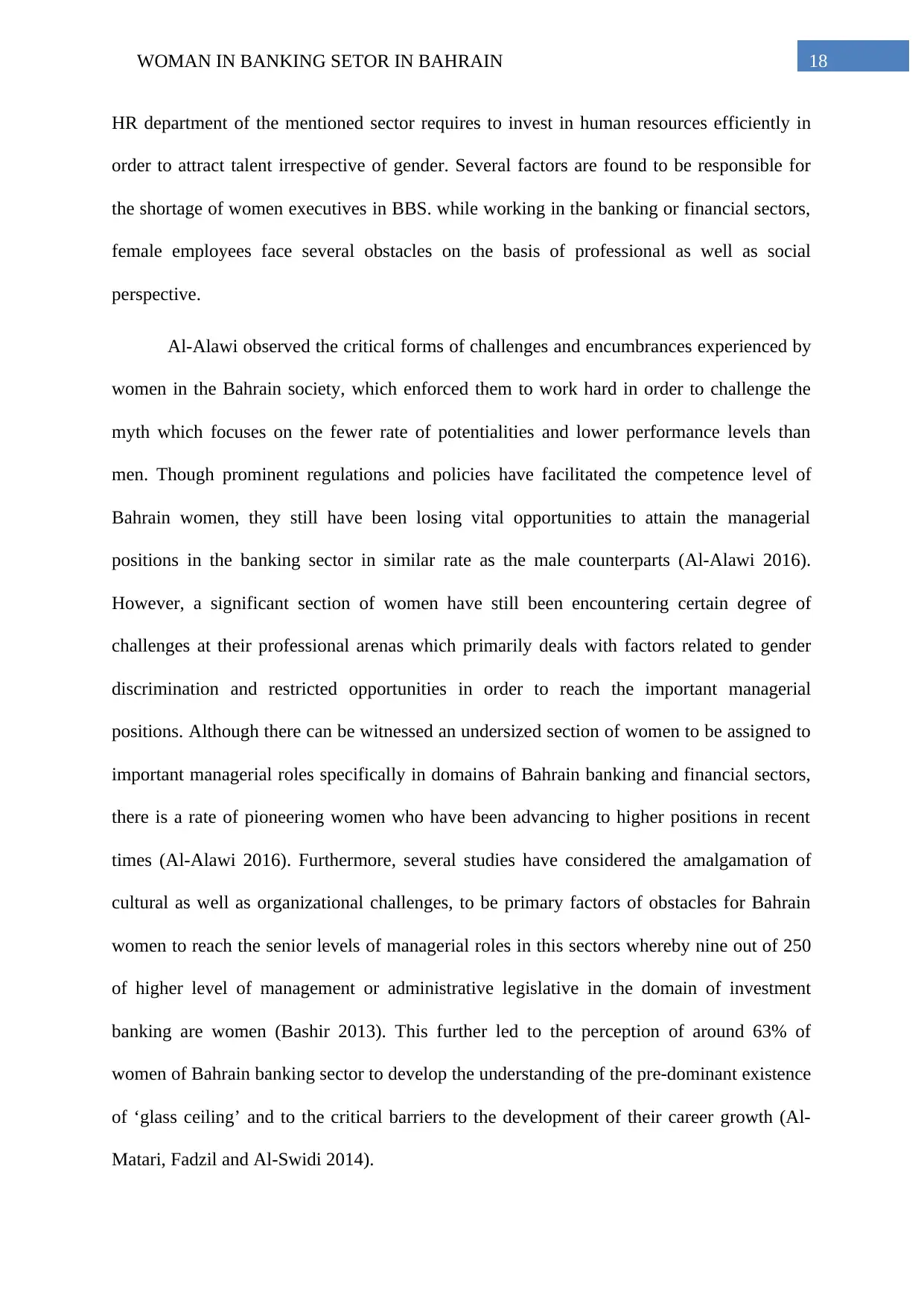
18WOMAN IN BANKING SETOR IN BAHRAIN
HR department of the mentioned sector requires to invest in human resources efficiently in
order to attract talent irrespective of gender. Several factors are found to be responsible for
the shortage of women executives in BBS. while working in the banking or financial sectors,
female employees face several obstacles on the basis of professional as well as social
perspective.
Al-Alawi observed the critical forms of challenges and encumbrances experienced by
women in the Bahrain society, which enforced them to work hard in order to challenge the
myth which focuses on the fewer rate of potentialities and lower performance levels than
men. Though prominent regulations and policies have facilitated the competence level of
Bahrain women, they still have been losing vital opportunities to attain the managerial
positions in the banking sector in similar rate as the male counterparts (Al-Alawi 2016).
However, a significant section of women have still been encountering certain degree of
challenges at their professional arenas which primarily deals with factors related to gender
discrimination and restricted opportunities in order to reach the important managerial
positions. Although there can be witnessed an undersized section of women to be assigned to
important managerial roles specifically in domains of Bahrain banking and financial sectors,
there is a rate of pioneering women who have been advancing to higher positions in recent
times (Al-Alawi 2016). Furthermore, several studies have considered the amalgamation of
cultural as well as organizational challenges, to be primary factors of obstacles for Bahrain
women to reach the senior levels of managerial roles in this sectors whereby nine out of 250
of higher level of management or administrative legislative in the domain of investment
banking are women (Bashir 2013). This further led to the perception of around 63% of
women of Bahrain banking sector to develop the understanding of the pre-dominant existence
of ‘glass ceiling’ and to the critical barriers to the development of their career growth (Al-
Matari, Fadzil and Al-Swidi 2014).
HR department of the mentioned sector requires to invest in human resources efficiently in
order to attract talent irrespective of gender. Several factors are found to be responsible for
the shortage of women executives in BBS. while working in the banking or financial sectors,
female employees face several obstacles on the basis of professional as well as social
perspective.
Al-Alawi observed the critical forms of challenges and encumbrances experienced by
women in the Bahrain society, which enforced them to work hard in order to challenge the
myth which focuses on the fewer rate of potentialities and lower performance levels than
men. Though prominent regulations and policies have facilitated the competence level of
Bahrain women, they still have been losing vital opportunities to attain the managerial
positions in the banking sector in similar rate as the male counterparts (Al-Alawi 2016).
However, a significant section of women have still been encountering certain degree of
challenges at their professional arenas which primarily deals with factors related to gender
discrimination and restricted opportunities in order to reach the important managerial
positions. Although there can be witnessed an undersized section of women to be assigned to
important managerial roles specifically in domains of Bahrain banking and financial sectors,
there is a rate of pioneering women who have been advancing to higher positions in recent
times (Al-Alawi 2016). Furthermore, several studies have considered the amalgamation of
cultural as well as organizational challenges, to be primary factors of obstacles for Bahrain
women to reach the senior levels of managerial roles in this sectors whereby nine out of 250
of higher level of management or administrative legislative in the domain of investment
banking are women (Bashir 2013). This further led to the perception of around 63% of
women of Bahrain banking sector to develop the understanding of the pre-dominant existence
of ‘glass ceiling’ and to the critical barriers to the development of their career growth (Al-
Matari, Fadzil and Al-Swidi 2014).
Paraphrase This Document
Need a fresh take? Get an instant paraphrase of this document with our AI Paraphraser
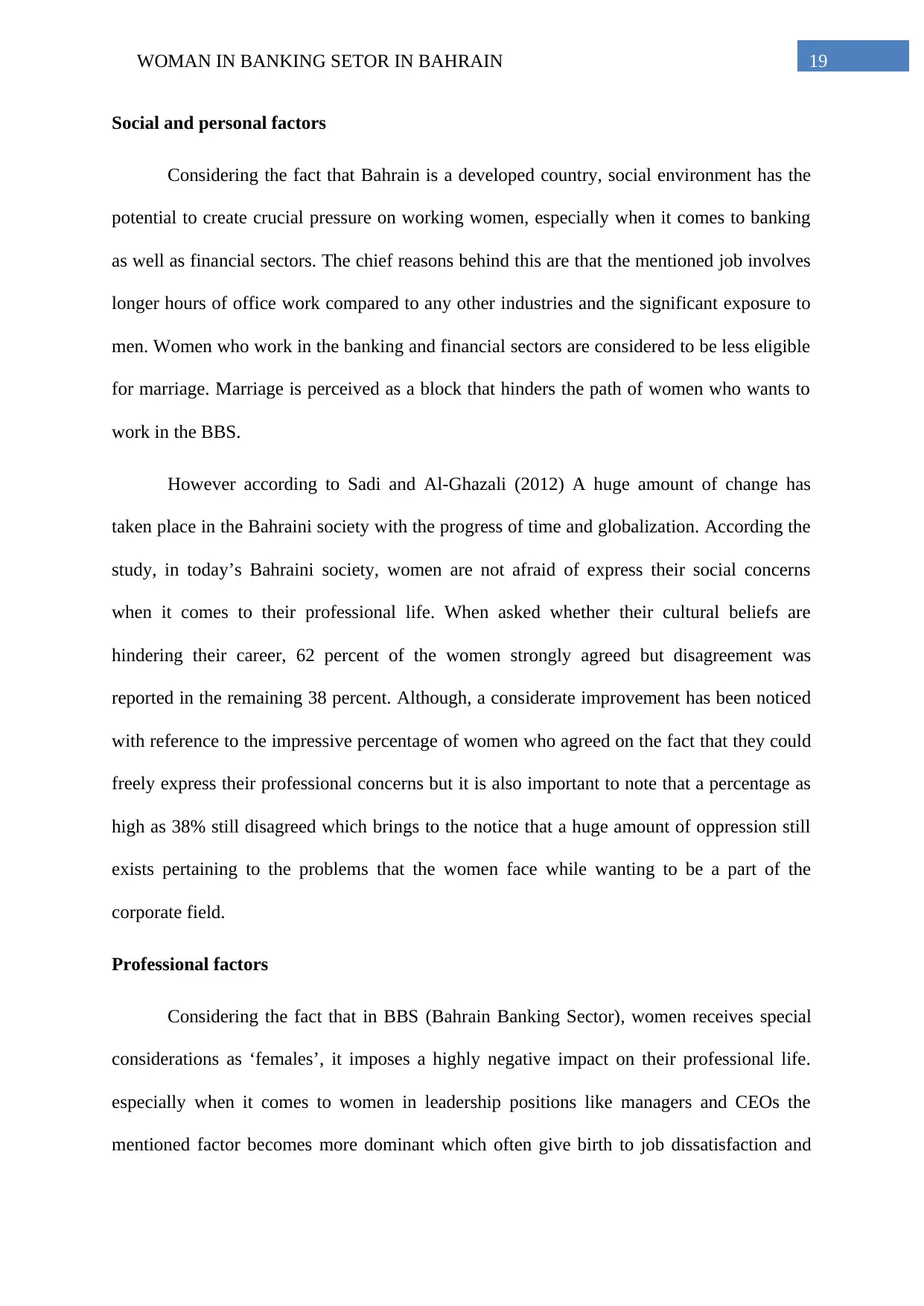
19WOMAN IN BANKING SETOR IN BAHRAIN
Social and personal factors
Considering the fact that Bahrain is a developed country, social environment has the
potential to create crucial pressure on working women, especially when it comes to banking
as well as financial sectors. The chief reasons behind this are that the mentioned job involves
longer hours of office work compared to any other industries and the significant exposure to
men. Women who work in the banking and financial sectors are considered to be less eligible
for marriage. Marriage is perceived as a block that hinders the path of women who wants to
work in the BBS.
However according to Sadi and Al-Ghazali (2012) A huge amount of change has
taken place in the Bahraini society with the progress of time and globalization. According the
study, in today’s Bahraini society, women are not afraid of express their social concerns
when it comes to their professional life. When asked whether their cultural beliefs are
hindering their career, 62 percent of the women strongly agreed but disagreement was
reported in the remaining 38 percent. Although, a considerate improvement has been noticed
with reference to the impressive percentage of women who agreed on the fact that they could
freely express their professional concerns but it is also important to note that a percentage as
high as 38% still disagreed which brings to the notice that a huge amount of oppression still
exists pertaining to the problems that the women face while wanting to be a part of the
corporate field.
Professional factors
Considering the fact that in BBS (Bahrain Banking Sector), women receives special
considerations as ‘females’, it imposes a highly negative impact on their professional life.
especially when it comes to women in leadership positions like managers and CEOs the
mentioned factor becomes more dominant which often give birth to job dissatisfaction and
Social and personal factors
Considering the fact that Bahrain is a developed country, social environment has the
potential to create crucial pressure on working women, especially when it comes to banking
as well as financial sectors. The chief reasons behind this are that the mentioned job involves
longer hours of office work compared to any other industries and the significant exposure to
men. Women who work in the banking and financial sectors are considered to be less eligible
for marriage. Marriage is perceived as a block that hinders the path of women who wants to
work in the BBS.
However according to Sadi and Al-Ghazali (2012) A huge amount of change has
taken place in the Bahraini society with the progress of time and globalization. According the
study, in today’s Bahraini society, women are not afraid of express their social concerns
when it comes to their professional life. When asked whether their cultural beliefs are
hindering their career, 62 percent of the women strongly agreed but disagreement was
reported in the remaining 38 percent. Although, a considerate improvement has been noticed
with reference to the impressive percentage of women who agreed on the fact that they could
freely express their professional concerns but it is also important to note that a percentage as
high as 38% still disagreed which brings to the notice that a huge amount of oppression still
exists pertaining to the problems that the women face while wanting to be a part of the
corporate field.
Professional factors
Considering the fact that in BBS (Bahrain Banking Sector), women receives special
considerations as ‘females’, it imposes a highly negative impact on their professional life.
especially when it comes to women in leadership positions like managers and CEOs the
mentioned factor becomes more dominant which often give birth to job dissatisfaction and
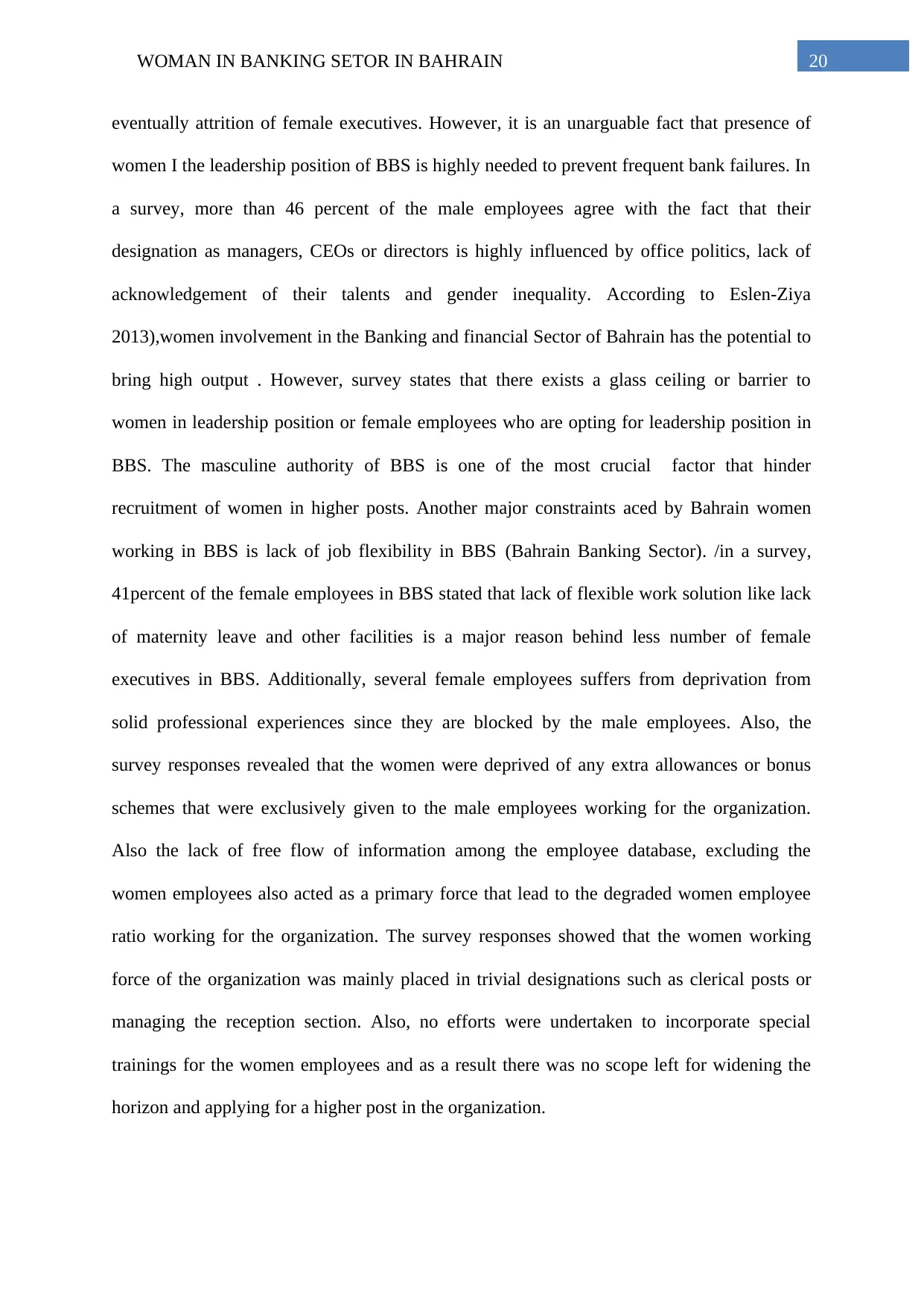
20WOMAN IN BANKING SETOR IN BAHRAIN
eventually attrition of female executives. However, it is an unarguable fact that presence of
women I the leadership position of BBS is highly needed to prevent frequent bank failures. In
a survey, more than 46 percent of the male employees agree with the fact that their
designation as managers, CEOs or directors is highly influenced by office politics, lack of
acknowledgement of their talents and gender inequality. According to Eslen-Ziya
2013),women involvement in the Banking and financial Sector of Bahrain has the potential to
bring high output . However, survey states that there exists a glass ceiling or barrier to
women in leadership position or female employees who are opting for leadership position in
BBS. The masculine authority of BBS is one of the most crucial factor that hinder
recruitment of women in higher posts. Another major constraints aced by Bahrain women
working in BBS is lack of job flexibility in BBS (Bahrain Banking Sector). /in a survey,
41percent of the female employees in BBS stated that lack of flexible work solution like lack
of maternity leave and other facilities is a major reason behind less number of female
executives in BBS. Additionally, several female employees suffers from deprivation from
solid professional experiences since they are blocked by the male employees. Also, the
survey responses revealed that the women were deprived of any extra allowances or bonus
schemes that were exclusively given to the male employees working for the organization.
Also the lack of free flow of information among the employee database, excluding the
women employees also acted as a primary force that lead to the degraded women employee
ratio working for the organization. The survey responses showed that the women working
force of the organization was mainly placed in trivial designations such as clerical posts or
managing the reception section. Also, no efforts were undertaken to incorporate special
trainings for the women employees and as a result there was no scope left for widening the
horizon and applying for a higher post in the organization.
eventually attrition of female executives. However, it is an unarguable fact that presence of
women I the leadership position of BBS is highly needed to prevent frequent bank failures. In
a survey, more than 46 percent of the male employees agree with the fact that their
designation as managers, CEOs or directors is highly influenced by office politics, lack of
acknowledgement of their talents and gender inequality. According to Eslen-Ziya
2013),women involvement in the Banking and financial Sector of Bahrain has the potential to
bring high output . However, survey states that there exists a glass ceiling or barrier to
women in leadership position or female employees who are opting for leadership position in
BBS. The masculine authority of BBS is one of the most crucial factor that hinder
recruitment of women in higher posts. Another major constraints aced by Bahrain women
working in BBS is lack of job flexibility in BBS (Bahrain Banking Sector). /in a survey,
41percent of the female employees in BBS stated that lack of flexible work solution like lack
of maternity leave and other facilities is a major reason behind less number of female
executives in BBS. Additionally, several female employees suffers from deprivation from
solid professional experiences since they are blocked by the male employees. Also, the
survey responses revealed that the women were deprived of any extra allowances or bonus
schemes that were exclusively given to the male employees working for the organization.
Also the lack of free flow of information among the employee database, excluding the
women employees also acted as a primary force that lead to the degraded women employee
ratio working for the organization. The survey responses showed that the women working
force of the organization was mainly placed in trivial designations such as clerical posts or
managing the reception section. Also, no efforts were undertaken to incorporate special
trainings for the women employees and as a result there was no scope left for widening the
horizon and applying for a higher post in the organization.
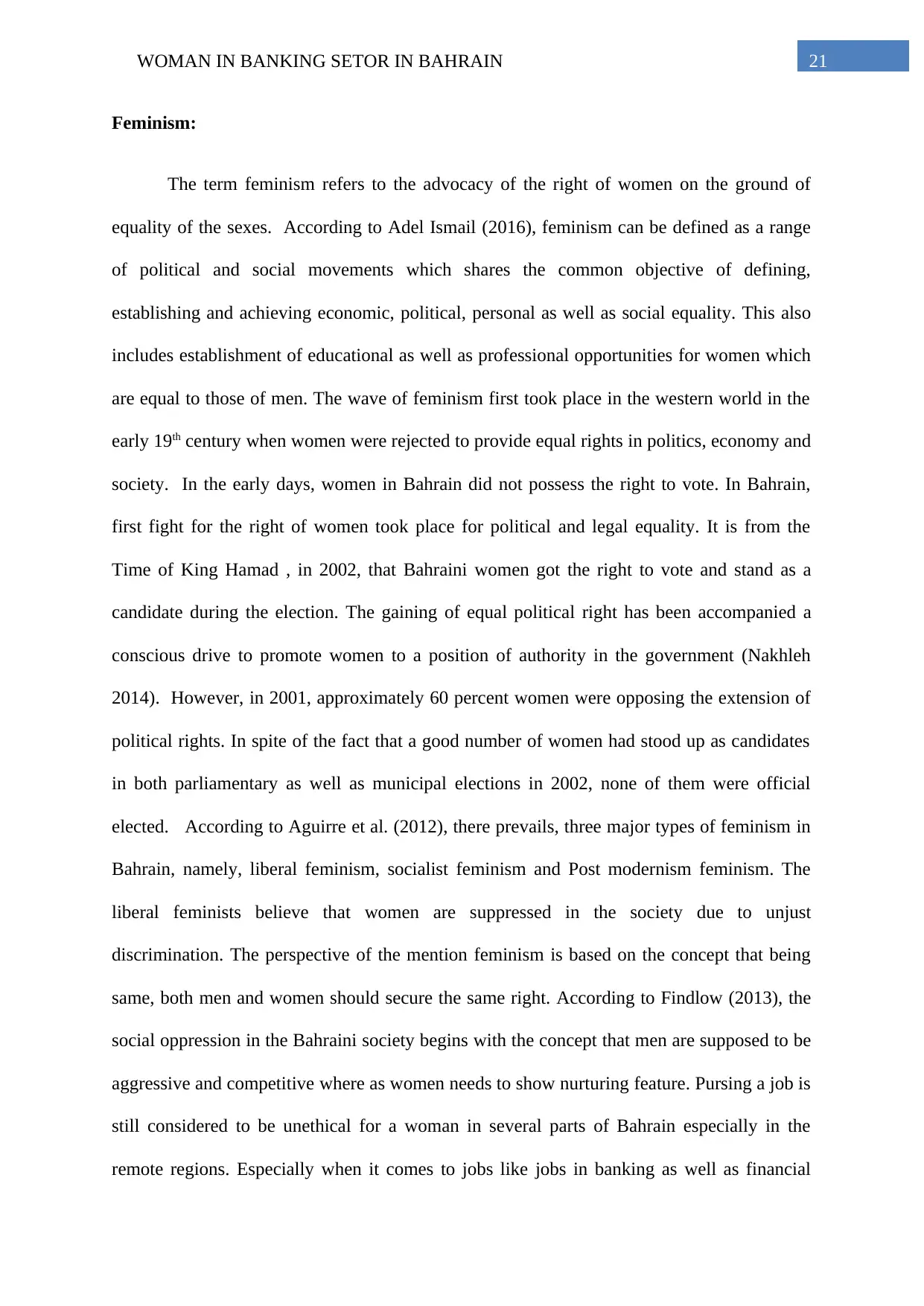
21WOMAN IN BANKING SETOR IN BAHRAIN
Feminism:
The term feminism refers to the advocacy of the right of women on the ground of
equality of the sexes. According to Adel Ismail (2016), feminism can be defined as a range
of political and social movements which shares the common objective of defining,
establishing and achieving economic, political, personal as well as social equality. This also
includes establishment of educational as well as professional opportunities for women which
are equal to those of men. The wave of feminism first took place in the western world in the
early 19th century when women were rejected to provide equal rights in politics, economy and
society. In the early days, women in Bahrain did not possess the right to vote. In Bahrain,
first fight for the right of women took place for political and legal equality. It is from the
Time of King Hamad , in 2002, that Bahraini women got the right to vote and stand as a
candidate during the election. The gaining of equal political right has been accompanied a
conscious drive to promote women to a position of authority in the government (Nakhleh
2014). However, in 2001, approximately 60 percent women were opposing the extension of
political rights. In spite of the fact that a good number of women had stood up as candidates
in both parliamentary as well as municipal elections in 2002, none of them were official
elected. According to Aguirre et al. (2012), there prevails, three major types of feminism in
Bahrain, namely, liberal feminism, socialist feminism and Post modernism feminism. The
liberal feminists believe that women are suppressed in the society due to unjust
discrimination. The perspective of the mention feminism is based on the concept that being
same, both men and women should secure the same right. According to Findlow (2013), the
social oppression in the Bahraini society begins with the concept that men are supposed to be
aggressive and competitive where as women needs to show nurturing feature. Pursing a job is
still considered to be unethical for a woman in several parts of Bahrain especially in the
remote regions. Especially when it comes to jobs like jobs in banking as well as financial
Feminism:
The term feminism refers to the advocacy of the right of women on the ground of
equality of the sexes. According to Adel Ismail (2016), feminism can be defined as a range
of political and social movements which shares the common objective of defining,
establishing and achieving economic, political, personal as well as social equality. This also
includes establishment of educational as well as professional opportunities for women which
are equal to those of men. The wave of feminism first took place in the western world in the
early 19th century when women were rejected to provide equal rights in politics, economy and
society. In the early days, women in Bahrain did not possess the right to vote. In Bahrain,
first fight for the right of women took place for political and legal equality. It is from the
Time of King Hamad , in 2002, that Bahraini women got the right to vote and stand as a
candidate during the election. The gaining of equal political right has been accompanied a
conscious drive to promote women to a position of authority in the government (Nakhleh
2014). However, in 2001, approximately 60 percent women were opposing the extension of
political rights. In spite of the fact that a good number of women had stood up as candidates
in both parliamentary as well as municipal elections in 2002, none of them were official
elected. According to Aguirre et al. (2012), there prevails, three major types of feminism in
Bahrain, namely, liberal feminism, socialist feminism and Post modernism feminism. The
liberal feminists believe that women are suppressed in the society due to unjust
discrimination. The perspective of the mention feminism is based on the concept that being
same, both men and women should secure the same right. According to Findlow (2013), the
social oppression in the Bahraini society begins with the concept that men are supposed to be
aggressive and competitive where as women needs to show nurturing feature. Pursing a job is
still considered to be unethical for a woman in several parts of Bahrain especially in the
remote regions. Especially when it comes to jobs like jobs in banking as well as financial
Secure Best Marks with AI Grader
Need help grading? Try our AI Grader for instant feedback on your assignments.
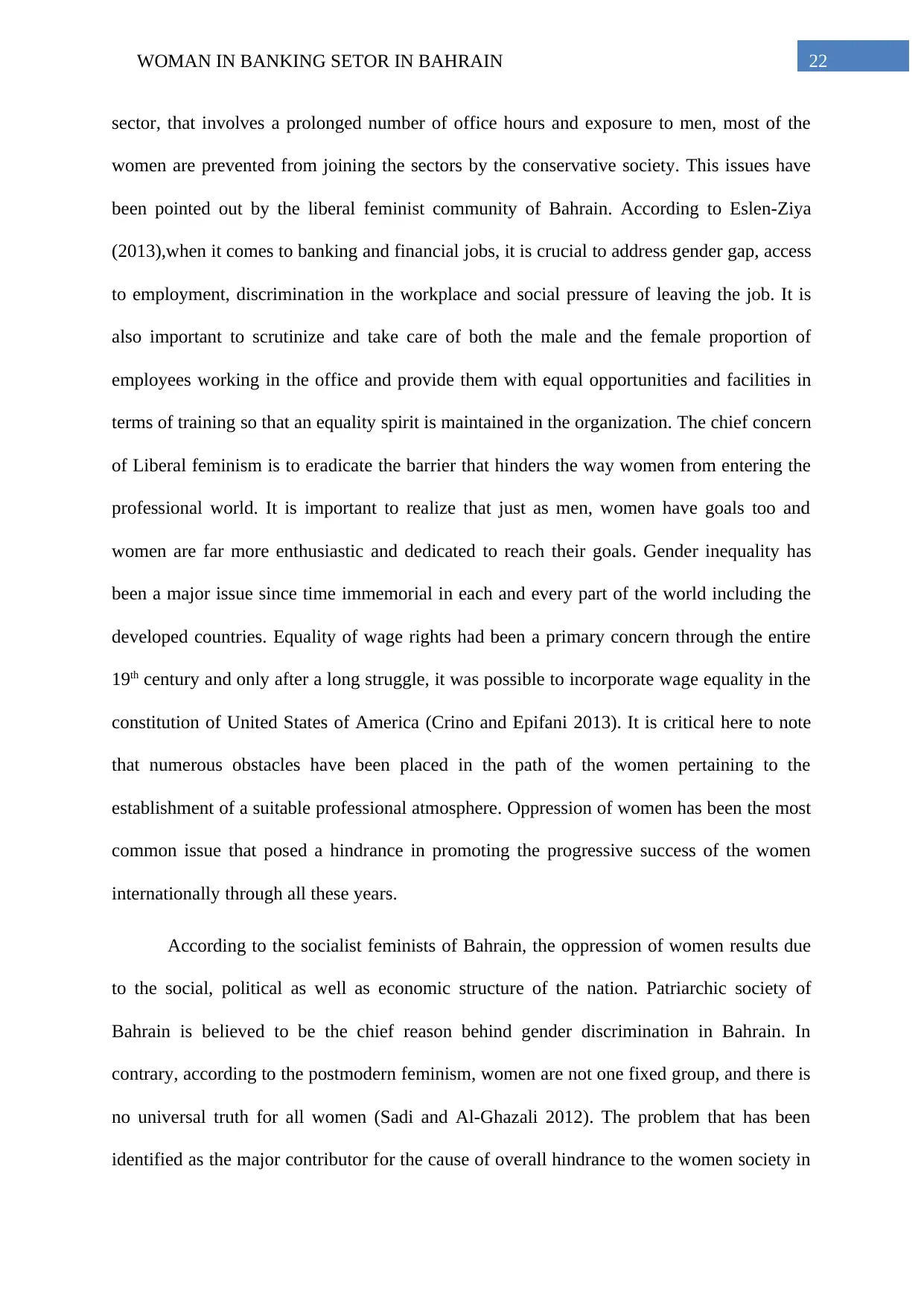
22WOMAN IN BANKING SETOR IN BAHRAIN
sector, that involves a prolonged number of office hours and exposure to men, most of the
women are prevented from joining the sectors by the conservative society. This issues have
been pointed out by the liberal feminist community of Bahrain. According to Eslen-Ziya
(2013),when it comes to banking and financial jobs, it is crucial to address gender gap, access
to employment, discrimination in the workplace and social pressure of leaving the job. It is
also important to scrutinize and take care of both the male and the female proportion of
employees working in the office and provide them with equal opportunities and facilities in
terms of training so that an equality spirit is maintained in the organization. The chief concern
of Liberal feminism is to eradicate the barrier that hinders the way women from entering the
professional world. It is important to realize that just as men, women have goals too and
women are far more enthusiastic and dedicated to reach their goals. Gender inequality has
been a major issue since time immemorial in each and every part of the world including the
developed countries. Equality of wage rights had been a primary concern through the entire
19th century and only after a long struggle, it was possible to incorporate wage equality in the
constitution of United States of America (Crino and Epifani 2013). It is critical here to note
that numerous obstacles have been placed in the path of the women pertaining to the
establishment of a suitable professional atmosphere. Oppression of women has been the most
common issue that posed a hindrance in promoting the progressive success of the women
internationally through all these years.
According to the socialist feminists of Bahrain, the oppression of women results due
to the social, political as well as economic structure of the nation. Patriarchic society of
Bahrain is believed to be the chief reason behind gender discrimination in Bahrain. In
contrary, according to the postmodern feminism, women are not one fixed group, and there is
no universal truth for all women (Sadi and Al-Ghazali 2012). The problem that has been
identified as the major contributor for the cause of overall hindrance to the women society in
sector, that involves a prolonged number of office hours and exposure to men, most of the
women are prevented from joining the sectors by the conservative society. This issues have
been pointed out by the liberal feminist community of Bahrain. According to Eslen-Ziya
(2013),when it comes to banking and financial jobs, it is crucial to address gender gap, access
to employment, discrimination in the workplace and social pressure of leaving the job. It is
also important to scrutinize and take care of both the male and the female proportion of
employees working in the office and provide them with equal opportunities and facilities in
terms of training so that an equality spirit is maintained in the organization. The chief concern
of Liberal feminism is to eradicate the barrier that hinders the way women from entering the
professional world. It is important to realize that just as men, women have goals too and
women are far more enthusiastic and dedicated to reach their goals. Gender inequality has
been a major issue since time immemorial in each and every part of the world including the
developed countries. Equality of wage rights had been a primary concern through the entire
19th century and only after a long struggle, it was possible to incorporate wage equality in the
constitution of United States of America (Crino and Epifani 2013). It is critical here to note
that numerous obstacles have been placed in the path of the women pertaining to the
establishment of a suitable professional atmosphere. Oppression of women has been the most
common issue that posed a hindrance in promoting the progressive success of the women
internationally through all these years.
According to the socialist feminists of Bahrain, the oppression of women results due
to the social, political as well as economic structure of the nation. Patriarchic society of
Bahrain is believed to be the chief reason behind gender discrimination in Bahrain. In
contrary, according to the postmodern feminism, women are not one fixed group, and there is
no universal truth for all women (Sadi and Al-Ghazali 2012). The problem that has been
identified as the major contributor for the cause of overall hindrance to the women society in
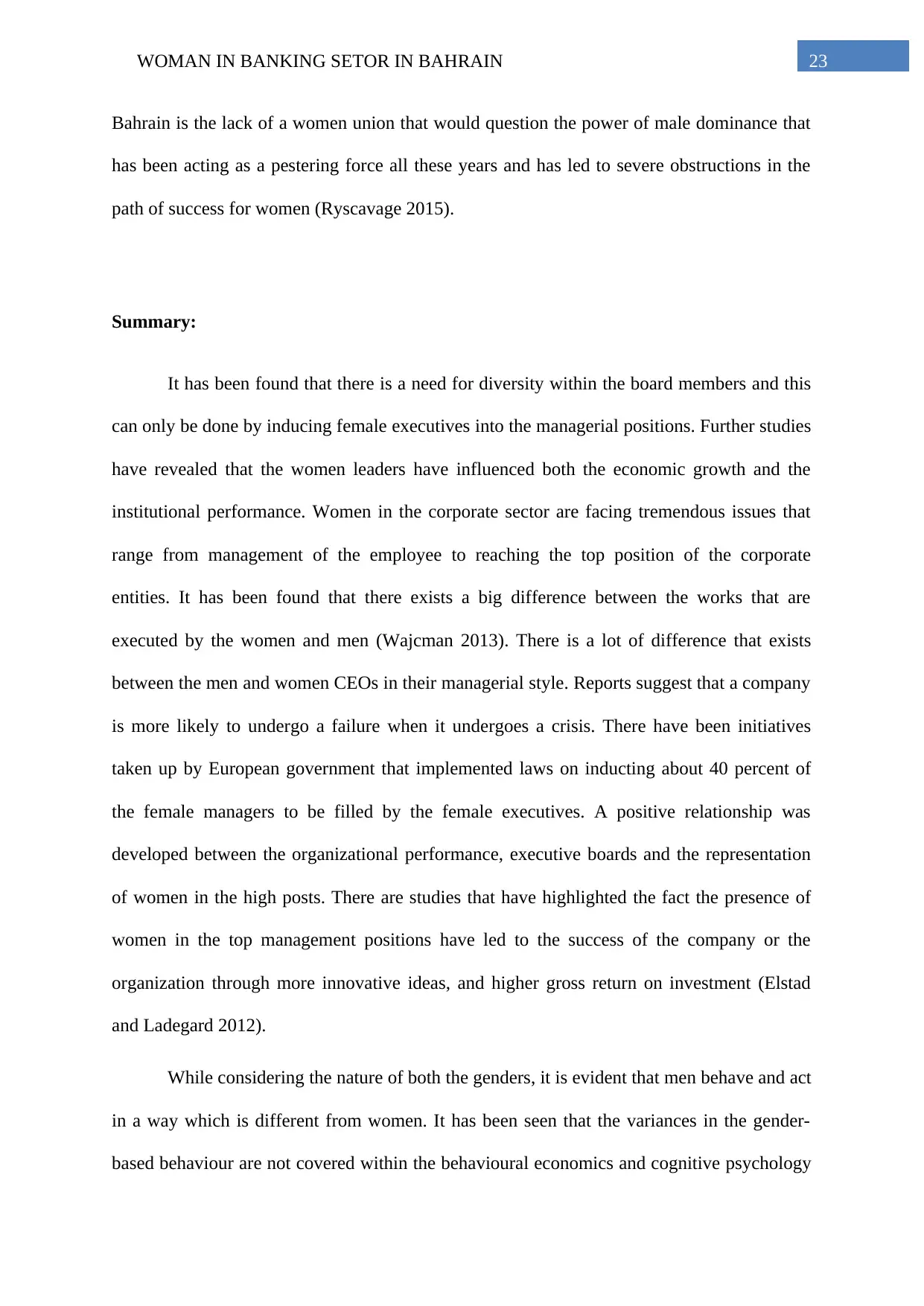
23WOMAN IN BANKING SETOR IN BAHRAIN
Bahrain is the lack of a women union that would question the power of male dominance that
has been acting as a pestering force all these years and has led to severe obstructions in the
path of success for women (Ryscavage 2015).
Summary:
It has been found that there is a need for diversity within the board members and this
can only be done by inducing female executives into the managerial positions. Further studies
have revealed that the women leaders have influenced both the economic growth and the
institutional performance. Women in the corporate sector are facing tremendous issues that
range from management of the employee to reaching the top position of the corporate
entities. It has been found that there exists a big difference between the works that are
executed by the women and men (Wajcman 2013). There is a lot of difference that exists
between the men and women CEOs in their managerial style. Reports suggest that a company
is more likely to undergo a failure when it undergoes a crisis. There have been initiatives
taken up by European government that implemented laws on inducting about 40 percent of
the female managers to be filled by the female executives. A positive relationship was
developed between the organizational performance, executive boards and the representation
of women in the high posts. There are studies that have highlighted the fact the presence of
women in the top management positions have led to the success of the company or the
organization through more innovative ideas, and higher gross return on investment (Elstad
and Ladegard 2012).
While considering the nature of both the genders, it is evident that men behave and act
in a way which is different from women. It has been seen that the variances in the gender-
based behaviour are not covered within the behavioural economics and cognitive psychology
Bahrain is the lack of a women union that would question the power of male dominance that
has been acting as a pestering force all these years and has led to severe obstructions in the
path of success for women (Ryscavage 2015).
Summary:
It has been found that there is a need for diversity within the board members and this
can only be done by inducing female executives into the managerial positions. Further studies
have revealed that the women leaders have influenced both the economic growth and the
institutional performance. Women in the corporate sector are facing tremendous issues that
range from management of the employee to reaching the top position of the corporate
entities. It has been found that there exists a big difference between the works that are
executed by the women and men (Wajcman 2013). There is a lot of difference that exists
between the men and women CEOs in their managerial style. Reports suggest that a company
is more likely to undergo a failure when it undergoes a crisis. There have been initiatives
taken up by European government that implemented laws on inducting about 40 percent of
the female managers to be filled by the female executives. A positive relationship was
developed between the organizational performance, executive boards and the representation
of women in the high posts. There are studies that have highlighted the fact the presence of
women in the top management positions have led to the success of the company or the
organization through more innovative ideas, and higher gross return on investment (Elstad
and Ladegard 2012).
While considering the nature of both the genders, it is evident that men behave and act
in a way which is different from women. It has been seen that the variances in the gender-
based behaviour are not covered within the behavioural economics and cognitive psychology
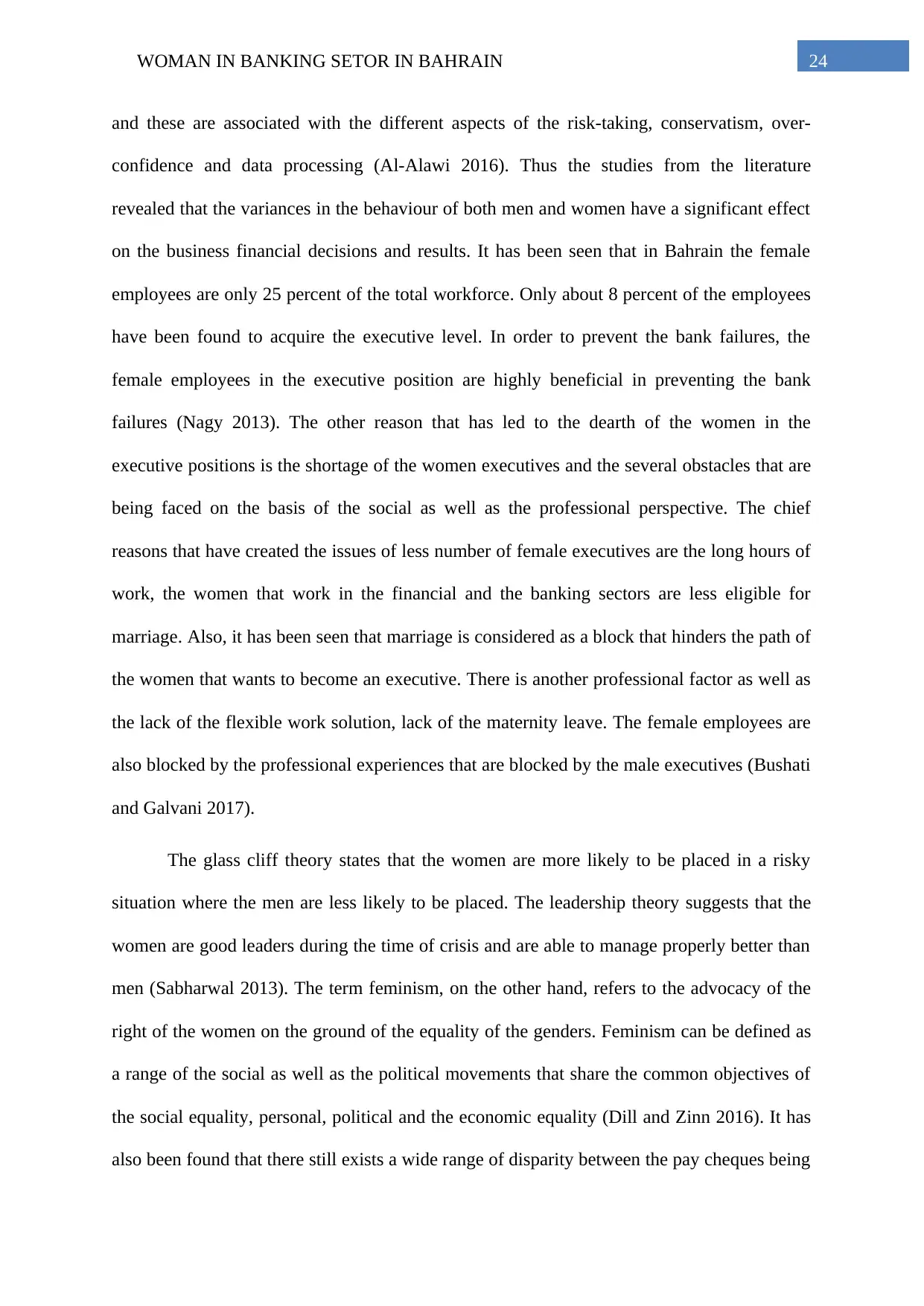
24WOMAN IN BANKING SETOR IN BAHRAIN
and these are associated with the different aspects of the risk-taking, conservatism, over-
confidence and data processing (Al-Alawi 2016). Thus the studies from the literature
revealed that the variances in the behaviour of both men and women have a significant effect
on the business financial decisions and results. It has been seen that in Bahrain the female
employees are only 25 percent of the total workforce. Only about 8 percent of the employees
have been found to acquire the executive level. In order to prevent the bank failures, the
female employees in the executive position are highly beneficial in preventing the bank
failures (Nagy 2013). The other reason that has led to the dearth of the women in the
executive positions is the shortage of the women executives and the several obstacles that are
being faced on the basis of the social as well as the professional perspective. The chief
reasons that have created the issues of less number of female executives are the long hours of
work, the women that work in the financial and the banking sectors are less eligible for
marriage. Also, it has been seen that marriage is considered as a block that hinders the path of
the women that wants to become an executive. There is another professional factor as well as
the lack of the flexible work solution, lack of the maternity leave. The female employees are
also blocked by the professional experiences that are blocked by the male executives (Bushati
and Galvani 2017).
The glass cliff theory states that the women are more likely to be placed in a risky
situation where the men are less likely to be placed. The leadership theory suggests that the
women are good leaders during the time of crisis and are able to manage properly better than
men (Sabharwal 2013). The term feminism, on the other hand, refers to the advocacy of the
right of the women on the ground of the equality of the genders. Feminism can be defined as
a range of the social as well as the political movements that share the common objectives of
the social equality, personal, political and the economic equality (Dill and Zinn 2016). It has
also been found that there still exists a wide range of disparity between the pay cheques being
and these are associated with the different aspects of the risk-taking, conservatism, over-
confidence and data processing (Al-Alawi 2016). Thus the studies from the literature
revealed that the variances in the behaviour of both men and women have a significant effect
on the business financial decisions and results. It has been seen that in Bahrain the female
employees are only 25 percent of the total workforce. Only about 8 percent of the employees
have been found to acquire the executive level. In order to prevent the bank failures, the
female employees in the executive position are highly beneficial in preventing the bank
failures (Nagy 2013). The other reason that has led to the dearth of the women in the
executive positions is the shortage of the women executives and the several obstacles that are
being faced on the basis of the social as well as the professional perspective. The chief
reasons that have created the issues of less number of female executives are the long hours of
work, the women that work in the financial and the banking sectors are less eligible for
marriage. Also, it has been seen that marriage is considered as a block that hinders the path of
the women that wants to become an executive. There is another professional factor as well as
the lack of the flexible work solution, lack of the maternity leave. The female employees are
also blocked by the professional experiences that are blocked by the male executives (Bushati
and Galvani 2017).
The glass cliff theory states that the women are more likely to be placed in a risky
situation where the men are less likely to be placed. The leadership theory suggests that the
women are good leaders during the time of crisis and are able to manage properly better than
men (Sabharwal 2013). The term feminism, on the other hand, refers to the advocacy of the
right of the women on the ground of the equality of the genders. Feminism can be defined as
a range of the social as well as the political movements that share the common objectives of
the social equality, personal, political and the economic equality (Dill and Zinn 2016). It has
also been found that there still exists a wide range of disparity between the pay cheques being
Paraphrase This Document
Need a fresh take? Get an instant paraphrase of this document with our AI Paraphraser
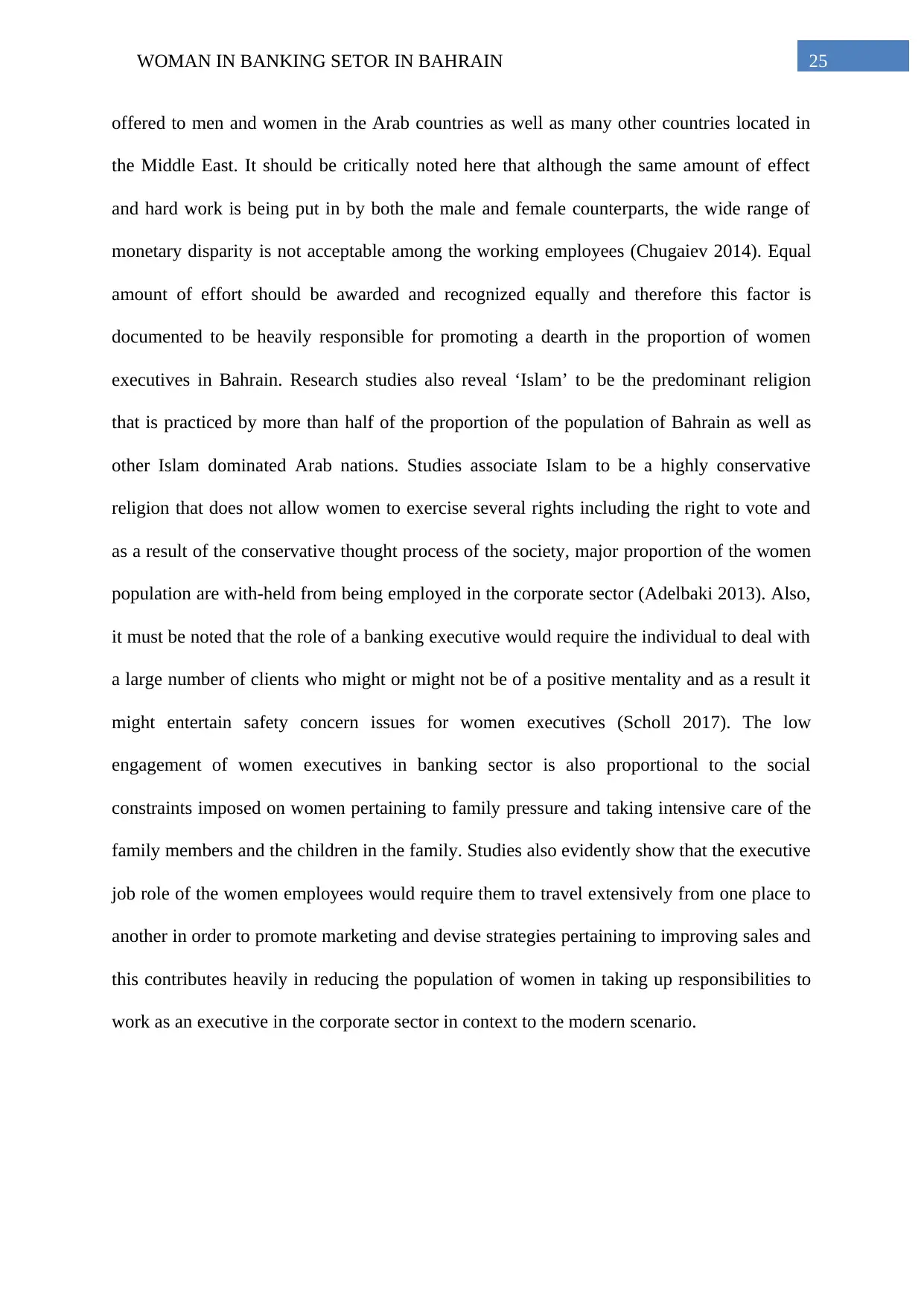
25WOMAN IN BANKING SETOR IN BAHRAIN
offered to men and women in the Arab countries as well as many other countries located in
the Middle East. It should be critically noted here that although the same amount of effect
and hard work is being put in by both the male and female counterparts, the wide range of
monetary disparity is not acceptable among the working employees (Chugaiev 2014). Equal
amount of effort should be awarded and recognized equally and therefore this factor is
documented to be heavily responsible for promoting a dearth in the proportion of women
executives in Bahrain. Research studies also reveal ‘Islam’ to be the predominant religion
that is practiced by more than half of the proportion of the population of Bahrain as well as
other Islam dominated Arab nations. Studies associate Islam to be a highly conservative
religion that does not allow women to exercise several rights including the right to vote and
as a result of the conservative thought process of the society, major proportion of the women
population are with-held from being employed in the corporate sector (Adelbaki 2013). Also,
it must be noted that the role of a banking executive would require the individual to deal with
a large number of clients who might or might not be of a positive mentality and as a result it
might entertain safety concern issues for women executives (Scholl 2017). The low
engagement of women executives in banking sector is also proportional to the social
constraints imposed on women pertaining to family pressure and taking intensive care of the
family members and the children in the family. Studies also evidently show that the executive
job role of the women employees would require them to travel extensively from one place to
another in order to promote marketing and devise strategies pertaining to improving sales and
this contributes heavily in reducing the population of women in taking up responsibilities to
work as an executive in the corporate sector in context to the modern scenario.
offered to men and women in the Arab countries as well as many other countries located in
the Middle East. It should be critically noted here that although the same amount of effect
and hard work is being put in by both the male and female counterparts, the wide range of
monetary disparity is not acceptable among the working employees (Chugaiev 2014). Equal
amount of effort should be awarded and recognized equally and therefore this factor is
documented to be heavily responsible for promoting a dearth in the proportion of women
executives in Bahrain. Research studies also reveal ‘Islam’ to be the predominant religion
that is practiced by more than half of the proportion of the population of Bahrain as well as
other Islam dominated Arab nations. Studies associate Islam to be a highly conservative
religion that does not allow women to exercise several rights including the right to vote and
as a result of the conservative thought process of the society, major proportion of the women
population are with-held from being employed in the corporate sector (Adelbaki 2013). Also,
it must be noted that the role of a banking executive would require the individual to deal with
a large number of clients who might or might not be of a positive mentality and as a result it
might entertain safety concern issues for women executives (Scholl 2017). The low
engagement of women executives in banking sector is also proportional to the social
constraints imposed on women pertaining to family pressure and taking intensive care of the
family members and the children in the family. Studies also evidently show that the executive
job role of the women employees would require them to travel extensively from one place to
another in order to promote marketing and devise strategies pertaining to improving sales and
this contributes heavily in reducing the population of women in taking up responsibilities to
work as an executive in the corporate sector in context to the modern scenario.
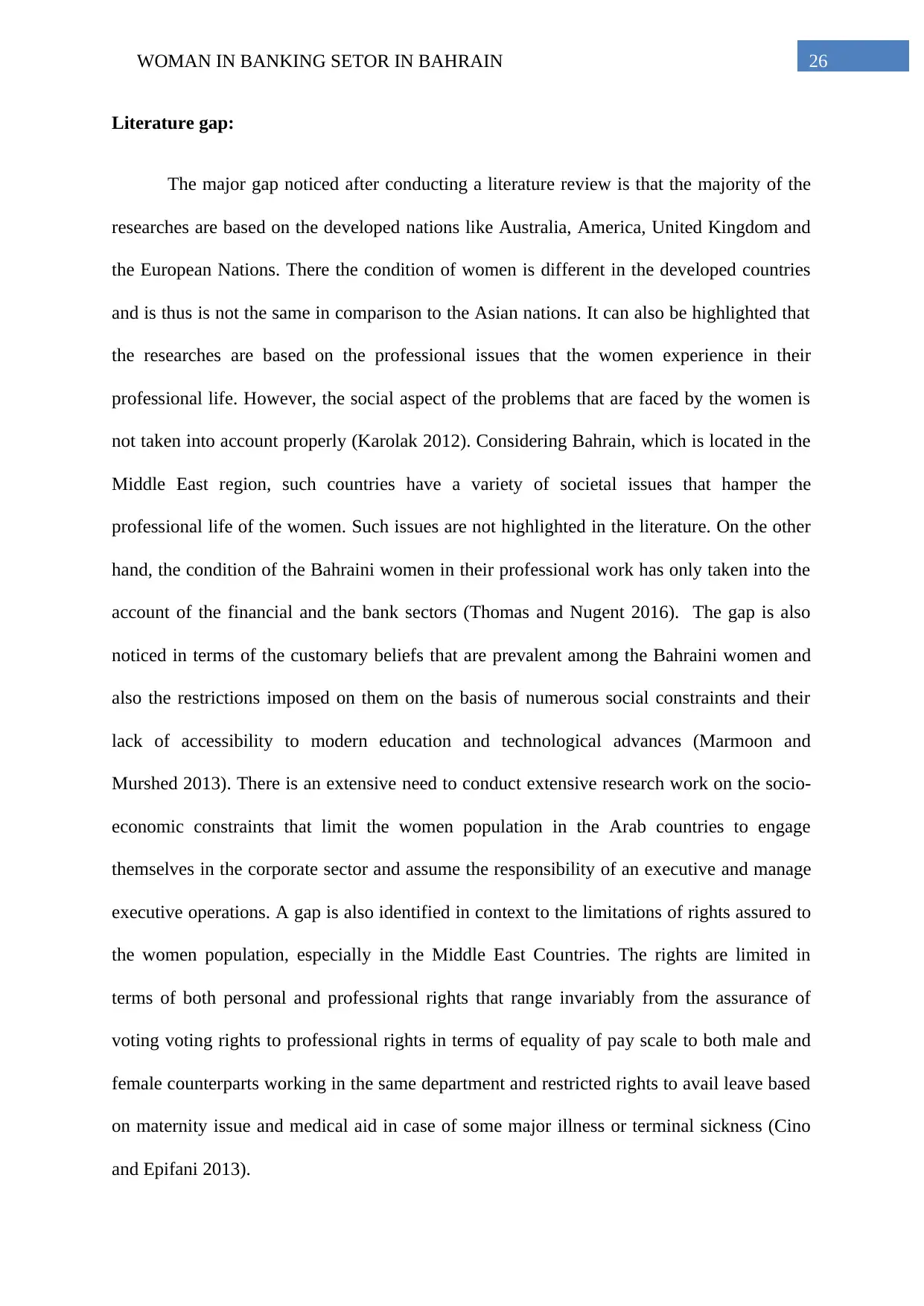
26WOMAN IN BANKING SETOR IN BAHRAIN
Literature gap:
The major gap noticed after conducting a literature review is that the majority of the
researches are based on the developed nations like Australia, America, United Kingdom and
the European Nations. There the condition of women is different in the developed countries
and is thus is not the same in comparison to the Asian nations. It can also be highlighted that
the researches are based on the professional issues that the women experience in their
professional life. However, the social aspect of the problems that are faced by the women is
not taken into account properly (Karolak 2012). Considering Bahrain, which is located in the
Middle East region, such countries have a variety of societal issues that hamper the
professional life of the women. Such issues are not highlighted in the literature. On the other
hand, the condition of the Bahraini women in their professional work has only taken into the
account of the financial and the bank sectors (Thomas and Nugent 2016). The gap is also
noticed in terms of the customary beliefs that are prevalent among the Bahraini women and
also the restrictions imposed on them on the basis of numerous social constraints and their
lack of accessibility to modern education and technological advances (Marmoon and
Murshed 2013). There is an extensive need to conduct extensive research work on the socio-
economic constraints that limit the women population in the Arab countries to engage
themselves in the corporate sector and assume the responsibility of an executive and manage
executive operations. A gap is also identified in context to the limitations of rights assured to
the women population, especially in the Middle East Countries. The rights are limited in
terms of both personal and professional rights that range invariably from the assurance of
voting voting rights to professional rights in terms of equality of pay scale to both male and
female counterparts working in the same department and restricted rights to avail leave based
on maternity issue and medical aid in case of some major illness or terminal sickness (Cino
and Epifani 2013).
Literature gap:
The major gap noticed after conducting a literature review is that the majority of the
researches are based on the developed nations like Australia, America, United Kingdom and
the European Nations. There the condition of women is different in the developed countries
and is thus is not the same in comparison to the Asian nations. It can also be highlighted that
the researches are based on the professional issues that the women experience in their
professional life. However, the social aspect of the problems that are faced by the women is
not taken into account properly (Karolak 2012). Considering Bahrain, which is located in the
Middle East region, such countries have a variety of societal issues that hamper the
professional life of the women. Such issues are not highlighted in the literature. On the other
hand, the condition of the Bahraini women in their professional work has only taken into the
account of the financial and the bank sectors (Thomas and Nugent 2016). The gap is also
noticed in terms of the customary beliefs that are prevalent among the Bahraini women and
also the restrictions imposed on them on the basis of numerous social constraints and their
lack of accessibility to modern education and technological advances (Marmoon and
Murshed 2013). There is an extensive need to conduct extensive research work on the socio-
economic constraints that limit the women population in the Arab countries to engage
themselves in the corporate sector and assume the responsibility of an executive and manage
executive operations. A gap is also identified in context to the limitations of rights assured to
the women population, especially in the Middle East Countries. The rights are limited in
terms of both personal and professional rights that range invariably from the assurance of
voting voting rights to professional rights in terms of equality of pay scale to both male and
female counterparts working in the same department and restricted rights to avail leave based
on maternity issue and medical aid in case of some major illness or terminal sickness (Cino
and Epifani 2013).
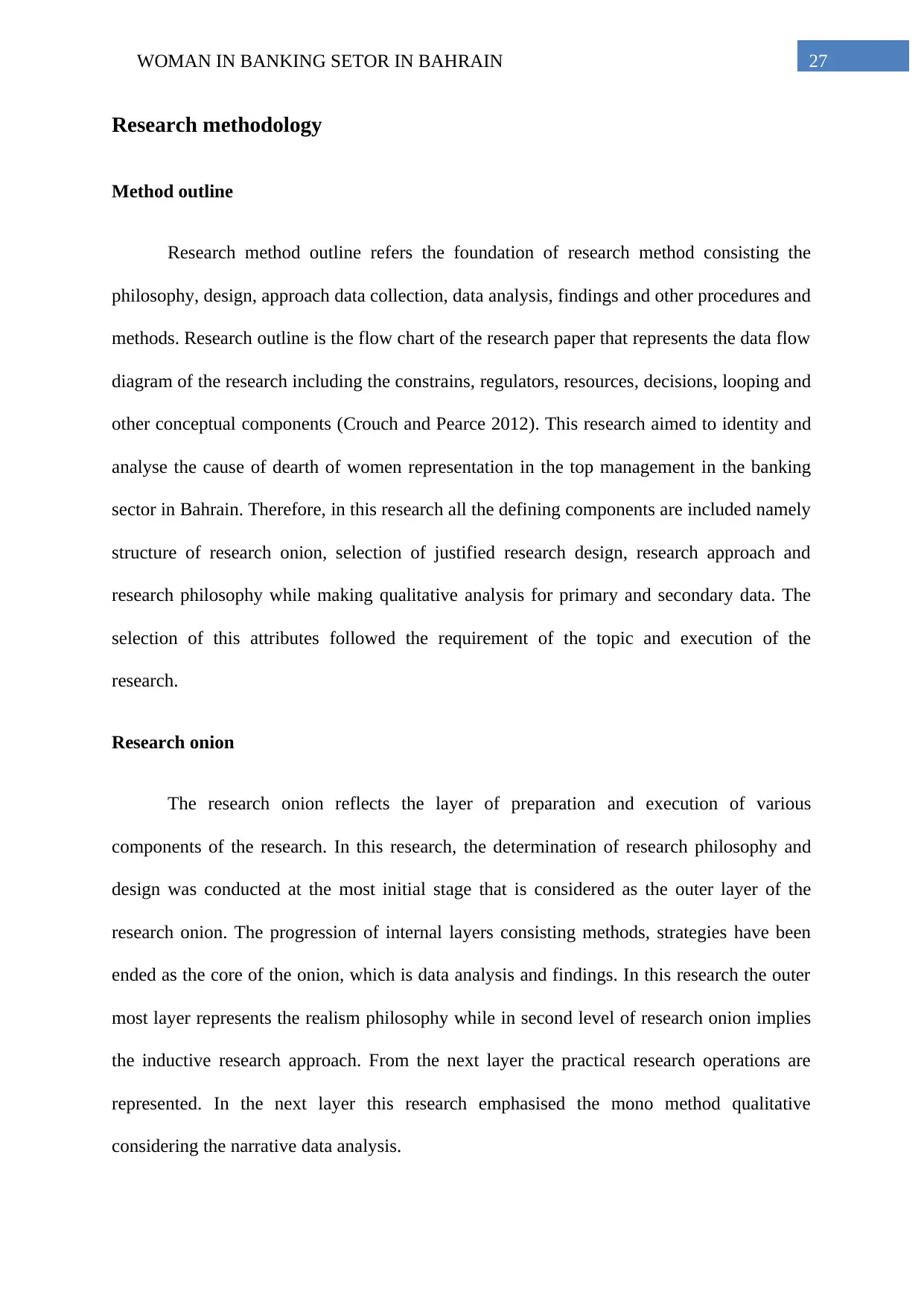
27WOMAN IN BANKING SETOR IN BAHRAIN
Research methodology
Method outline
Research method outline refers the foundation of research method consisting the
philosophy, design, approach data collection, data analysis, findings and other procedures and
methods. Research outline is the flow chart of the research paper that represents the data flow
diagram of the research including the constrains, regulators, resources, decisions, looping and
other conceptual components (Crouch and Pearce 2012). This research aimed to identity and
analyse the cause of dearth of women representation in the top management in the banking
sector in Bahrain. Therefore, in this research all the defining components are included namely
structure of research onion, selection of justified research design, research approach and
research philosophy while making qualitative analysis for primary and secondary data. The
selection of this attributes followed the requirement of the topic and execution of the
research.
Research onion
The research onion reflects the layer of preparation and execution of various
components of the research. In this research, the determination of research philosophy and
design was conducted at the most initial stage that is considered as the outer layer of the
research onion. The progression of internal layers consisting methods, strategies have been
ended as the core of the onion, which is data analysis and findings. In this research the outer
most layer represents the realism philosophy while in second level of research onion implies
the inductive research approach. From the next layer the practical research operations are
represented. In the next layer this research emphasised the mono method qualitative
considering the narrative data analysis.
Research methodology
Method outline
Research method outline refers the foundation of research method consisting the
philosophy, design, approach data collection, data analysis, findings and other procedures and
methods. Research outline is the flow chart of the research paper that represents the data flow
diagram of the research including the constrains, regulators, resources, decisions, looping and
other conceptual components (Crouch and Pearce 2012). This research aimed to identity and
analyse the cause of dearth of women representation in the top management in the banking
sector in Bahrain. Therefore, in this research all the defining components are included namely
structure of research onion, selection of justified research design, research approach and
research philosophy while making qualitative analysis for primary and secondary data. The
selection of this attributes followed the requirement of the topic and execution of the
research.
Research onion
The research onion reflects the layer of preparation and execution of various
components of the research. In this research, the determination of research philosophy and
design was conducted at the most initial stage that is considered as the outer layer of the
research onion. The progression of internal layers consisting methods, strategies have been
ended as the core of the onion, which is data analysis and findings. In this research the outer
most layer represents the realism philosophy while in second level of research onion implies
the inductive research approach. From the next layer the practical research operations are
represented. In the next layer this research emphasised the mono method qualitative
considering the narrative data analysis.
Secure Best Marks with AI Grader
Need help grading? Try our AI Grader for instant feedback on your assignments.

28WOMAN IN BANKING SETOR IN BAHRAIN
Figure: Research onion
Source: (Saunders et al. 2011)
Research philosophy and justification
At the initial sage of the research, the researchers need to select a particular
philosophy that would hold the perception of the execution of the research method. The
research philosophy defines the exceptional technique of the research throughout the
conduction of the processes. Mainly three types of research philosophies are used in modern
research process namely Positivism, Realism and Interpretivism (Crowther and Lancaster
2012). The positivism philosophy allows the researcher to find the cause and regulatory
attributes behind a specific outcomes. On the other hand, the Interpretivism philosophy helps
to interpret the research components and strategies while prioritising the affectedness and
perceptive interpretation of facts. For this research the chosen research philosophy was
realism philosophy. The cause of choosing realism as the philosophy of this Realism is a
perfect mix of Positivism and Interpretivism philosophy through which this research can
Figure: Research onion
Source: (Saunders et al. 2011)
Research philosophy and justification
At the initial sage of the research, the researchers need to select a particular
philosophy that would hold the perception of the execution of the research method. The
research philosophy defines the exceptional technique of the research throughout the
conduction of the processes. Mainly three types of research philosophies are used in modern
research process namely Positivism, Realism and Interpretivism (Crowther and Lancaster
2012). The positivism philosophy allows the researcher to find the cause and regulatory
attributes behind a specific outcomes. On the other hand, the Interpretivism philosophy helps
to interpret the research components and strategies while prioritising the affectedness and
perceptive interpretation of facts. For this research the chosen research philosophy was
realism philosophy. The cause of choosing realism as the philosophy of this Realism is a
perfect mix of Positivism and Interpretivism philosophy through which this research can
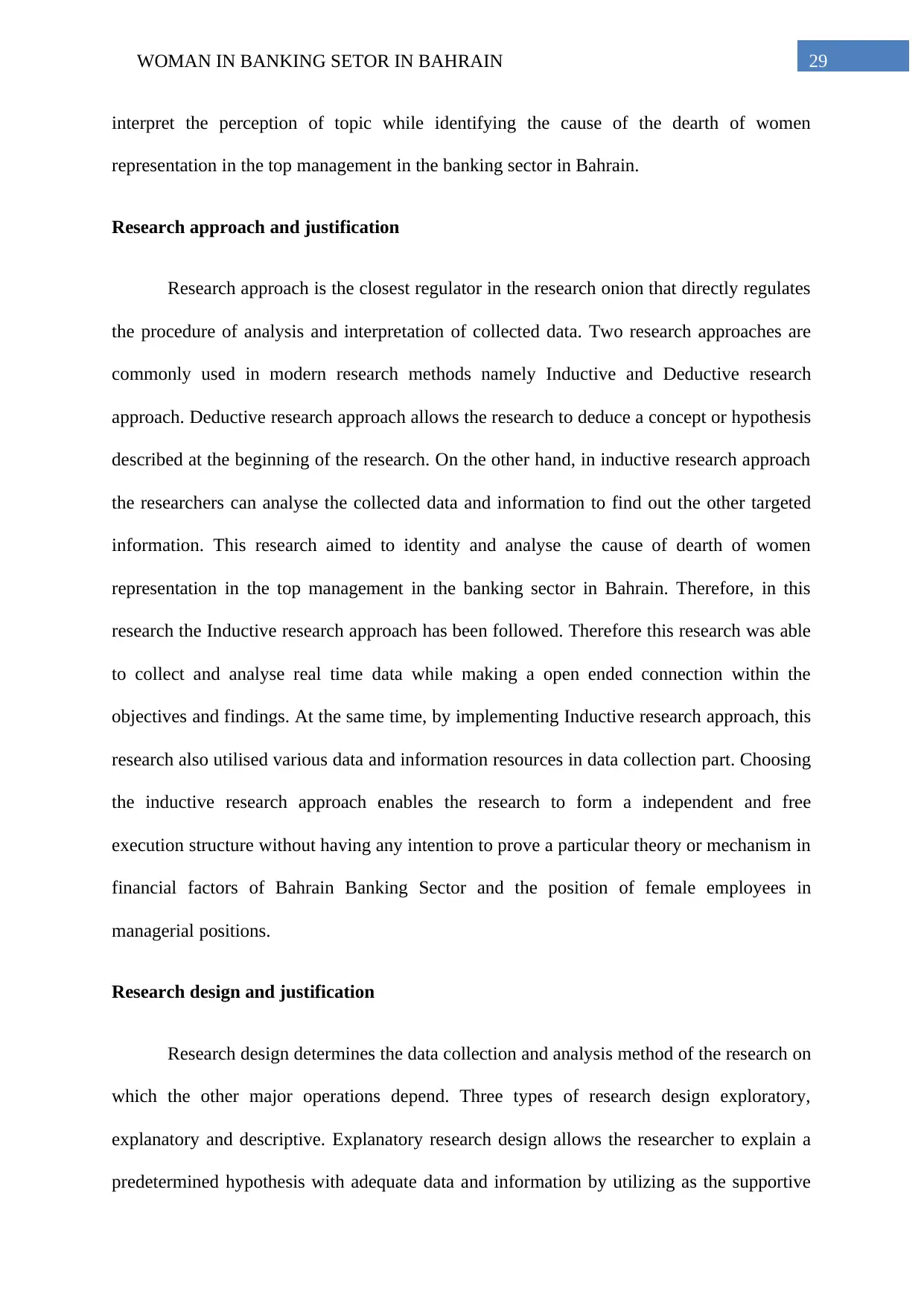
29WOMAN IN BANKING SETOR IN BAHRAIN
interpret the perception of topic while identifying the cause of the dearth of women
representation in the top management in the banking sector in Bahrain.
Research approach and justification
Research approach is the closest regulator in the research onion that directly regulates
the procedure of analysis and interpretation of collected data. Two research approaches are
commonly used in modern research methods namely Inductive and Deductive research
approach. Deductive research approach allows the research to deduce a concept or hypothesis
described at the beginning of the research. On the other hand, in inductive research approach
the researchers can analyse the collected data and information to find out the other targeted
information. This research aimed to identity and analyse the cause of dearth of women
representation in the top management in the banking sector in Bahrain. Therefore, in this
research the Inductive research approach has been followed. Therefore this research was able
to collect and analyse real time data while making a open ended connection within the
objectives and findings. At the same time, by implementing Inductive research approach, this
research also utilised various data and information resources in data collection part. Choosing
the inductive research approach enables the research to form a independent and free
execution structure without having any intention to prove a particular theory or mechanism in
financial factors of Bahrain Banking Sector and the position of female employees in
managerial positions.
Research design and justification
Research design determines the data collection and analysis method of the research on
which the other major operations depend. Three types of research design exploratory,
explanatory and descriptive. Explanatory research design allows the researcher to explain a
predetermined hypothesis with adequate data and information by utilizing as the supportive
interpret the perception of topic while identifying the cause of the dearth of women
representation in the top management in the banking sector in Bahrain.
Research approach and justification
Research approach is the closest regulator in the research onion that directly regulates
the procedure of analysis and interpretation of collected data. Two research approaches are
commonly used in modern research methods namely Inductive and Deductive research
approach. Deductive research approach allows the research to deduce a concept or hypothesis
described at the beginning of the research. On the other hand, in inductive research approach
the researchers can analyse the collected data and information to find out the other targeted
information. This research aimed to identity and analyse the cause of dearth of women
representation in the top management in the banking sector in Bahrain. Therefore, in this
research the Inductive research approach has been followed. Therefore this research was able
to collect and analyse real time data while making a open ended connection within the
objectives and findings. At the same time, by implementing Inductive research approach, this
research also utilised various data and information resources in data collection part. Choosing
the inductive research approach enables the research to form a independent and free
execution structure without having any intention to prove a particular theory or mechanism in
financial factors of Bahrain Banking Sector and the position of female employees in
managerial positions.
Research design and justification
Research design determines the data collection and analysis method of the research on
which the other major operations depend. Three types of research design exploratory,
explanatory and descriptive. Explanatory research design allows the researcher to explain a
predetermined hypothesis with adequate data and information by utilizing as the supportive
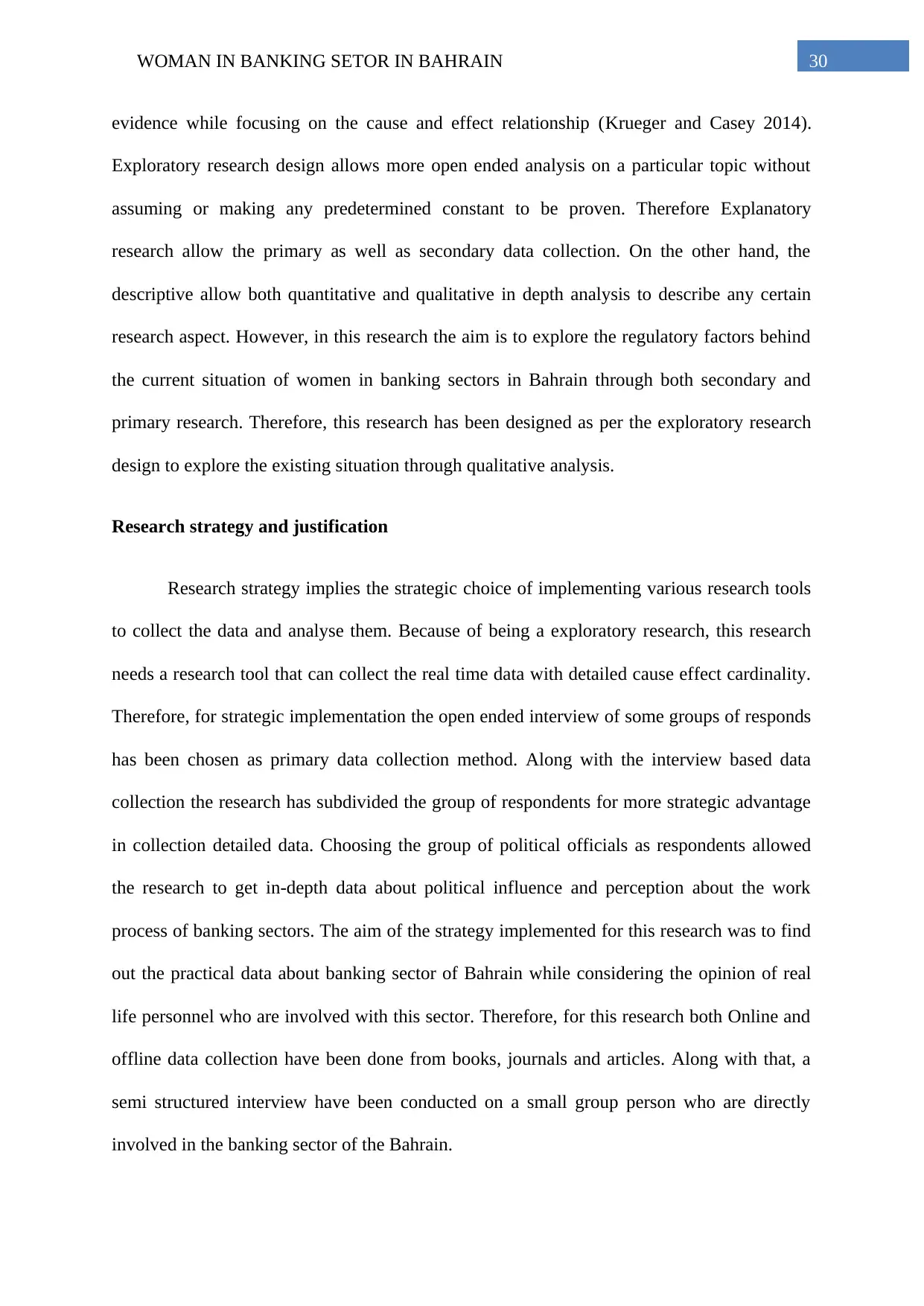
30WOMAN IN BANKING SETOR IN BAHRAIN
evidence while focusing on the cause and effect relationship (Krueger and Casey 2014).
Exploratory research design allows more open ended analysis on a particular topic without
assuming or making any predetermined constant to be proven. Therefore Explanatory
research allow the primary as well as secondary data collection. On the other hand, the
descriptive allow both quantitative and qualitative in depth analysis to describe any certain
research aspect. However, in this research the aim is to explore the regulatory factors behind
the current situation of women in banking sectors in Bahrain through both secondary and
primary research. Therefore, this research has been designed as per the exploratory research
design to explore the existing situation through qualitative analysis.
Research strategy and justification
Research strategy implies the strategic choice of implementing various research tools
to collect the data and analyse them. Because of being a exploratory research, this research
needs a research tool that can collect the real time data with detailed cause effect cardinality.
Therefore, for strategic implementation the open ended interview of some groups of responds
has been chosen as primary data collection method. Along with the interview based data
collection the research has subdivided the group of respondents for more strategic advantage
in collection detailed data. Choosing the group of political officials as respondents allowed
the research to get in-depth data about political influence and perception about the work
process of banking sectors. The aim of the strategy implemented for this research was to find
out the practical data about banking sector of Bahrain while considering the opinion of real
life personnel who are involved with this sector. Therefore, for this research both Online and
offline data collection have been done from books, journals and articles. Along with that, a
semi structured interview have been conducted on a small group person who are directly
involved in the banking sector of the Bahrain.
evidence while focusing on the cause and effect relationship (Krueger and Casey 2014).
Exploratory research design allows more open ended analysis on a particular topic without
assuming or making any predetermined constant to be proven. Therefore Explanatory
research allow the primary as well as secondary data collection. On the other hand, the
descriptive allow both quantitative and qualitative in depth analysis to describe any certain
research aspect. However, in this research the aim is to explore the regulatory factors behind
the current situation of women in banking sectors in Bahrain through both secondary and
primary research. Therefore, this research has been designed as per the exploratory research
design to explore the existing situation through qualitative analysis.
Research strategy and justification
Research strategy implies the strategic choice of implementing various research tools
to collect the data and analyse them. Because of being a exploratory research, this research
needs a research tool that can collect the real time data with detailed cause effect cardinality.
Therefore, for strategic implementation the open ended interview of some groups of responds
has been chosen as primary data collection method. Along with the interview based data
collection the research has subdivided the group of respondents for more strategic advantage
in collection detailed data. Choosing the group of political officials as respondents allowed
the research to get in-depth data about political influence and perception about the work
process of banking sectors. The aim of the strategy implemented for this research was to find
out the practical data about banking sector of Bahrain while considering the opinion of real
life personnel who are involved with this sector. Therefore, for this research both Online and
offline data collection have been done from books, journals and articles. Along with that, a
semi structured interview have been conducted on a small group person who are directly
involved in the banking sector of the Bahrain.
Paraphrase This Document
Need a fresh take? Get an instant paraphrase of this document with our AI Paraphraser
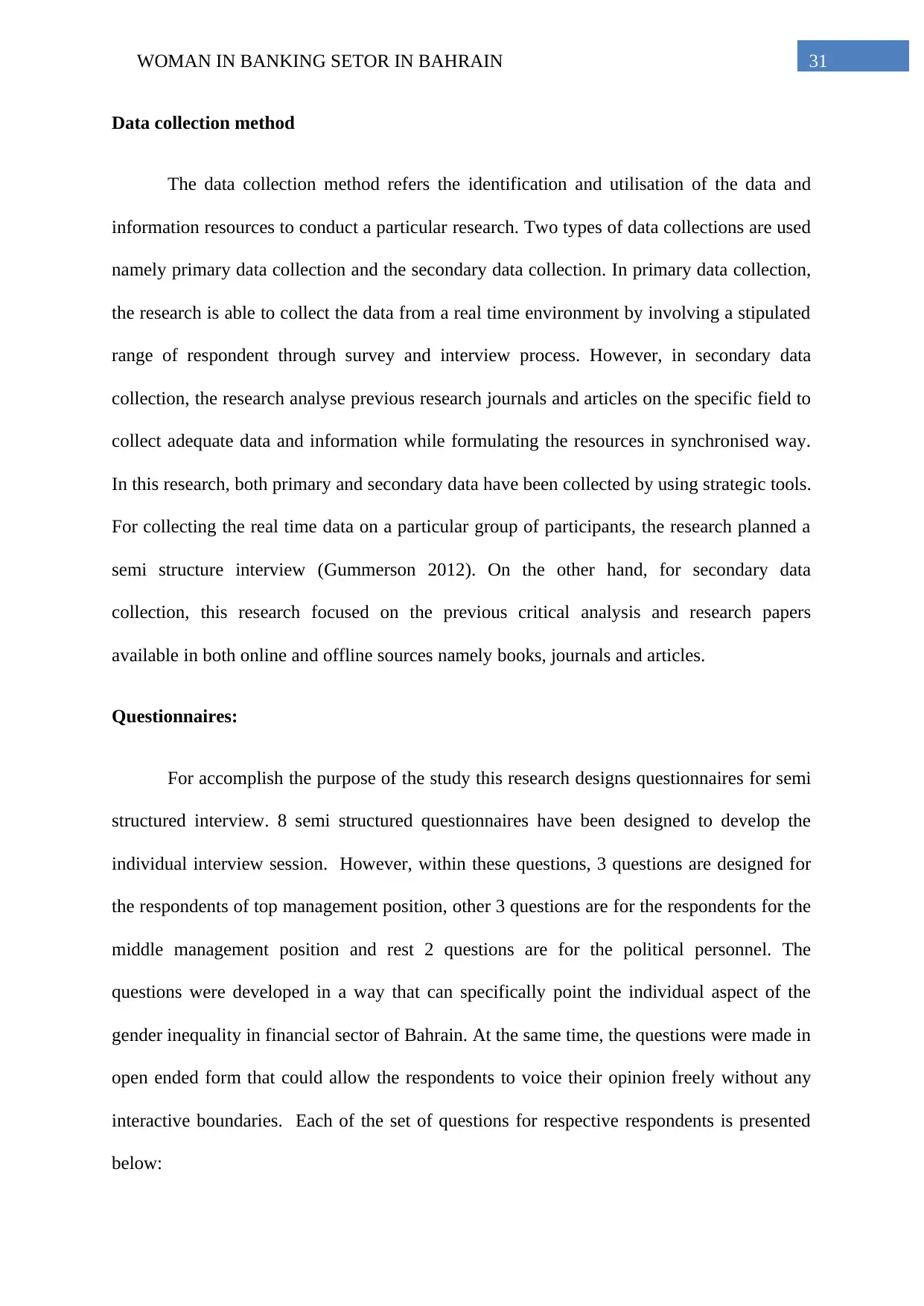
31WOMAN IN BANKING SETOR IN BAHRAIN
Data collection method
The data collection method refers the identification and utilisation of the data and
information resources to conduct a particular research. Two types of data collections are used
namely primary data collection and the secondary data collection. In primary data collection,
the research is able to collect the data from a real time environment by involving a stipulated
range of respondent through survey and interview process. However, in secondary data
collection, the research analyse previous research journals and articles on the specific field to
collect adequate data and information while formulating the resources in synchronised way.
In this research, both primary and secondary data have been collected by using strategic tools.
For collecting the real time data on a particular group of participants, the research planned a
semi structure interview (Gummerson 2012). On the other hand, for secondary data
collection, this research focused on the previous critical analysis and research papers
available in both online and offline sources namely books, journals and articles.
Questionnaires:
For accomplish the purpose of the study this research designs questionnaires for semi
structured interview. 8 semi structured questionnaires have been designed to develop the
individual interview session. However, within these questions, 3 questions are designed for
the respondents of top management position, other 3 questions are for the respondents for the
middle management position and rest 2 questions are for the political personnel. The
questions were developed in a way that can specifically point the individual aspect of the
gender inequality in financial sector of Bahrain. At the same time, the questions were made in
open ended form that could allow the respondents to voice their opinion freely without any
interactive boundaries. Each of the set of questions for respective respondents is presented
below:
Data collection method
The data collection method refers the identification and utilisation of the data and
information resources to conduct a particular research. Two types of data collections are used
namely primary data collection and the secondary data collection. In primary data collection,
the research is able to collect the data from a real time environment by involving a stipulated
range of respondent through survey and interview process. However, in secondary data
collection, the research analyse previous research journals and articles on the specific field to
collect adequate data and information while formulating the resources in synchronised way.
In this research, both primary and secondary data have been collected by using strategic tools.
For collecting the real time data on a particular group of participants, the research planned a
semi structure interview (Gummerson 2012). On the other hand, for secondary data
collection, this research focused on the previous critical analysis and research papers
available in both online and offline sources namely books, journals and articles.
Questionnaires:
For accomplish the purpose of the study this research designs questionnaires for semi
structured interview. 8 semi structured questionnaires have been designed to develop the
individual interview session. However, within these questions, 3 questions are designed for
the respondents of top management position, other 3 questions are for the respondents for the
middle management position and rest 2 questions are for the political personnel. The
questions were developed in a way that can specifically point the individual aspect of the
gender inequality in financial sector of Bahrain. At the same time, the questions were made in
open ended form that could allow the respondents to voice their opinion freely without any
interactive boundaries. Each of the set of questions for respective respondents is presented
below:
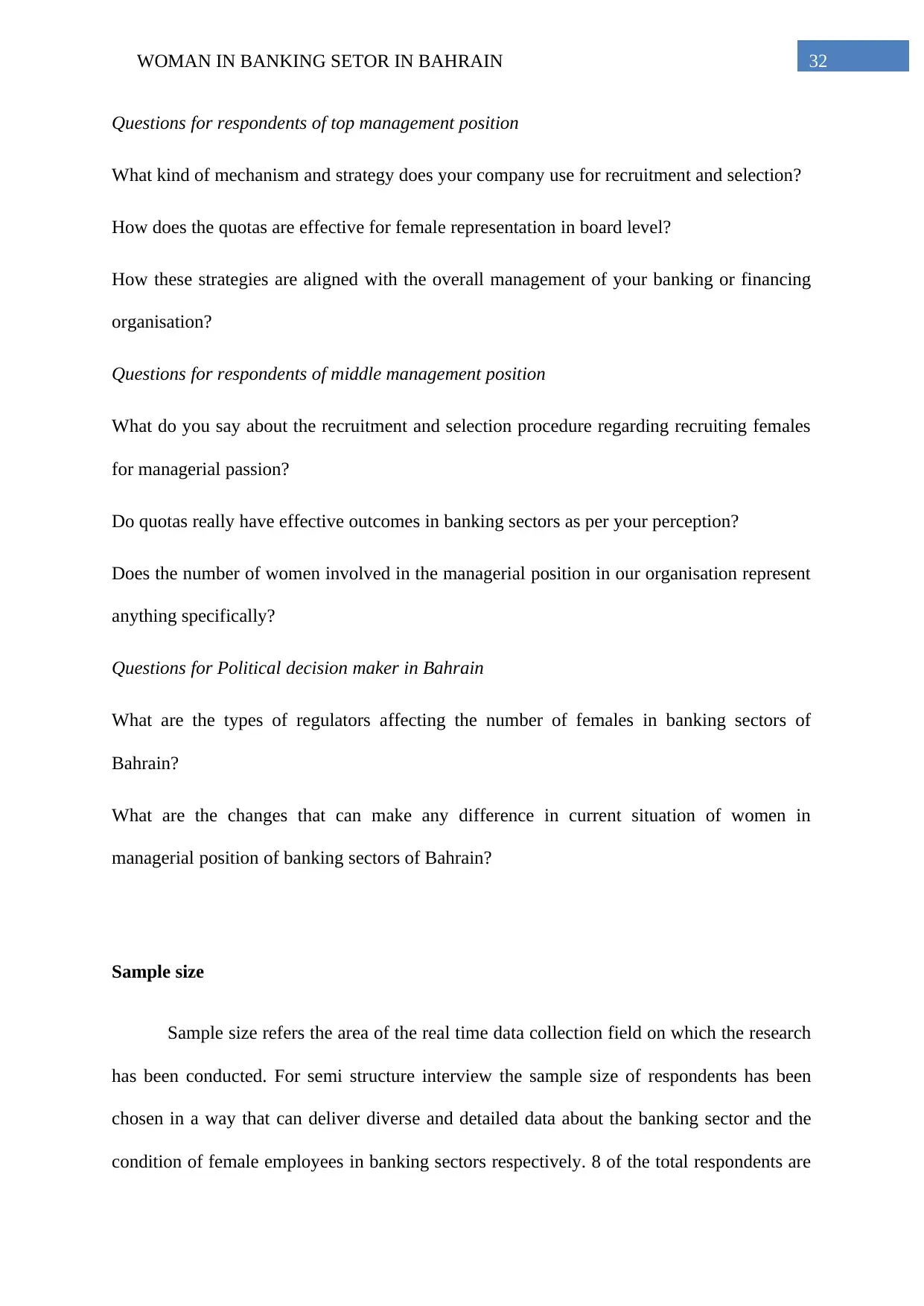
32WOMAN IN BANKING SETOR IN BAHRAIN
Questions for respondents of top management position
What kind of mechanism and strategy does your company use for recruitment and selection?
How does the quotas are effective for female representation in board level?
How these strategies are aligned with the overall management of your banking or financing
organisation?
Questions for respondents of middle management position
What do you say about the recruitment and selection procedure regarding recruiting females
for managerial passion?
Do quotas really have effective outcomes in banking sectors as per your perception?
Does the number of women involved in the managerial position in our organisation represent
anything specifically?
Questions for Political decision maker in Bahrain
What are the types of regulators affecting the number of females in banking sectors of
Bahrain?
What are the changes that can make any difference in current situation of women in
managerial position of banking sectors of Bahrain?
Sample size
Sample size refers the area of the real time data collection field on which the research
has been conducted. For semi structure interview the sample size of respondents has been
chosen in a way that can deliver diverse and detailed data about the banking sector and the
condition of female employees in banking sectors respectively. 8 of the total respondents are
Questions for respondents of top management position
What kind of mechanism and strategy does your company use for recruitment and selection?
How does the quotas are effective for female representation in board level?
How these strategies are aligned with the overall management of your banking or financing
organisation?
Questions for respondents of middle management position
What do you say about the recruitment and selection procedure regarding recruiting females
for managerial passion?
Do quotas really have effective outcomes in banking sectors as per your perception?
Does the number of women involved in the managerial position in our organisation represent
anything specifically?
Questions for Political decision maker in Bahrain
What are the types of regulators affecting the number of females in banking sectors of
Bahrain?
What are the changes that can make any difference in current situation of women in
managerial position of banking sectors of Bahrain?
Sample size
Sample size refers the area of the real time data collection field on which the research
has been conducted. For semi structure interview the sample size of respondents has been
chosen in a way that can deliver diverse and detailed data about the banking sector and the
condition of female employees in banking sectors respectively. 8 of the total respondents are

33WOMAN IN BANKING SETOR IN BAHRAIN
chosen from the discussed sector to gain the in depth perspective about the industry. However
out of the 8 respondents 6 of them are female and 2 of them are male. The male are selected
as respondents to cover wide range of viewpoints. Apart from that, the sample size has been
subdivided into further three subsections namely managerial respondents, leadership level
respondents and Political persons. Choosing two political officials in Bahrain allowed the
research to get in-depth data about political influence and perception about the work process
of banking sectors. The research majorly focused on the aspect of the managerial position
served by women that enabled the research to select women from managerial passion and
lower managerial position as well. For this research, the sample size of semi-structured
interview has been presented below:
4 women who were able to break through the glass ceiling reaching top management
positions in the BBS (Bahrain Banking Sector)
4 women working in the BBS (Bahrain Banking Sector) and stuck in middle
management positions
2 officials and political decision makers in Bahrain
Data analysis method
Data analysis method is one of the major tools that directly interconnected with the
outcomes of the research especially for the exploratory research. Data analysis allows the
researcher to find out the result of the research with logical and rational explanation. Two
types of data analysis process are used in a research namely qualitative data analysis and
quantitative data analysis (Freshwater 2012). The qualitative data analysis allows the
researcher to analyse the rational and non-numeric information while the quantitative data
analysis allows the researcher to analyse the numerical data with various mathematical and
statistical procedure. In this research, the secondary data and the data collected from semi-
chosen from the discussed sector to gain the in depth perspective about the industry. However
out of the 8 respondents 6 of them are female and 2 of them are male. The male are selected
as respondents to cover wide range of viewpoints. Apart from that, the sample size has been
subdivided into further three subsections namely managerial respondents, leadership level
respondents and Political persons. Choosing two political officials in Bahrain allowed the
research to get in-depth data about political influence and perception about the work process
of banking sectors. The research majorly focused on the aspect of the managerial position
served by women that enabled the research to select women from managerial passion and
lower managerial position as well. For this research, the sample size of semi-structured
interview has been presented below:
4 women who were able to break through the glass ceiling reaching top management
positions in the BBS (Bahrain Banking Sector)
4 women working in the BBS (Bahrain Banking Sector) and stuck in middle
management positions
2 officials and political decision makers in Bahrain
Data analysis method
Data analysis method is one of the major tools that directly interconnected with the
outcomes of the research especially for the exploratory research. Data analysis allows the
researcher to find out the result of the research with logical and rational explanation. Two
types of data analysis process are used in a research namely qualitative data analysis and
quantitative data analysis (Freshwater 2012). The qualitative data analysis allows the
researcher to analyse the rational and non-numeric information while the quantitative data
analysis allows the researcher to analyse the numerical data with various mathematical and
statistical procedure. In this research, the secondary data and the data collected from semi-
Secure Best Marks with AI Grader
Need help grading? Try our AI Grader for instant feedback on your assignments.
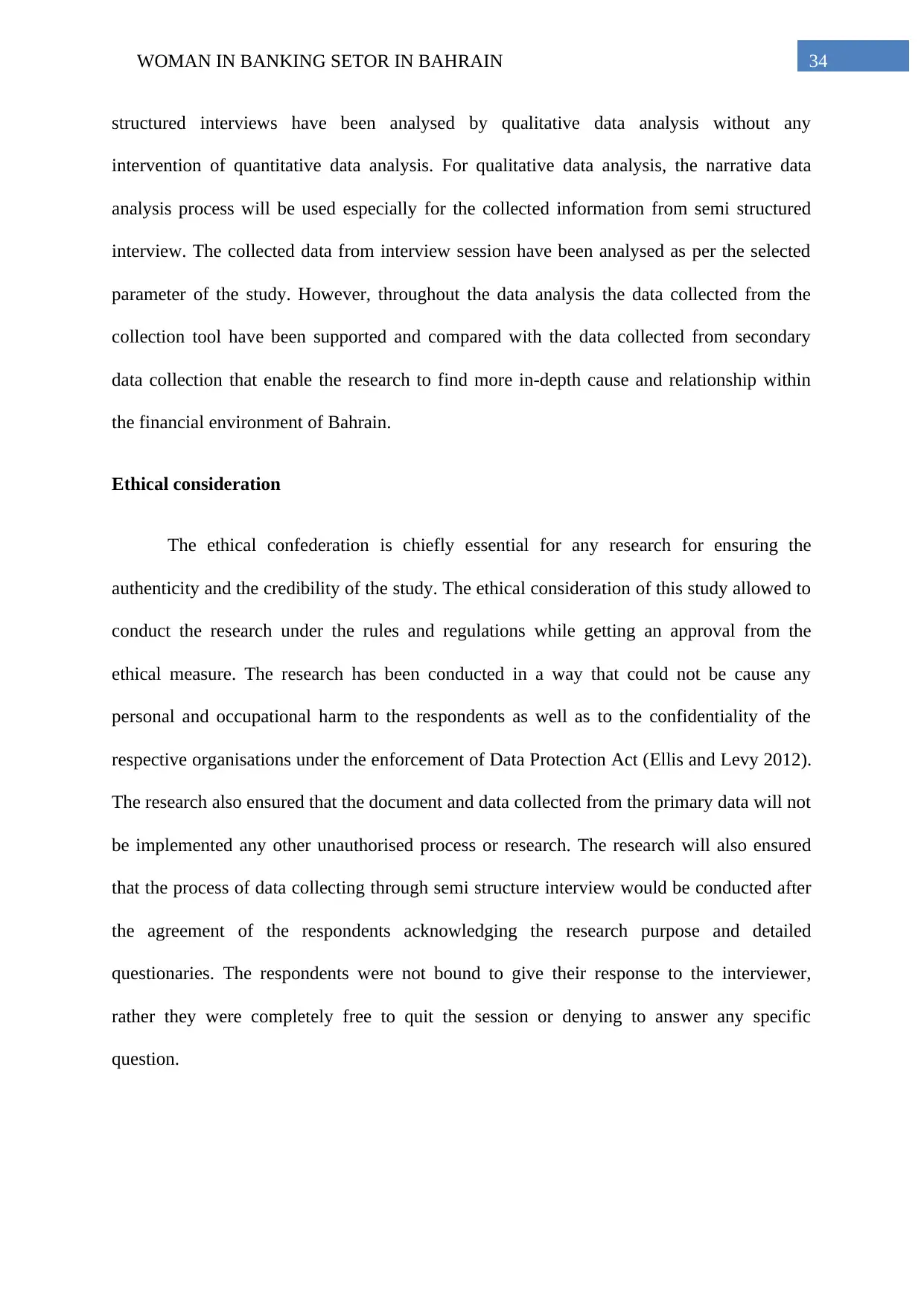
34WOMAN IN BANKING SETOR IN BAHRAIN
structured interviews have been analysed by qualitative data analysis without any
intervention of quantitative data analysis. For qualitative data analysis, the narrative data
analysis process will be used especially for the collected information from semi structured
interview. The collected data from interview session have been analysed as per the selected
parameter of the study. However, throughout the data analysis the data collected from the
collection tool have been supported and compared with the data collected from secondary
data collection that enable the research to find more in-depth cause and relationship within
the financial environment of Bahrain.
Ethical consideration
The ethical confederation is chiefly essential for any research for ensuring the
authenticity and the credibility of the study. The ethical consideration of this study allowed to
conduct the research under the rules and regulations while getting an approval from the
ethical measure. The research has been conducted in a way that could not be cause any
personal and occupational harm to the respondents as well as to the confidentiality of the
respective organisations under the enforcement of Data Protection Act (Ellis and Levy 2012).
The research also ensured that the document and data collected from the primary data will not
be implemented any other unauthorised process or research. The research will also ensured
that the process of data collecting through semi structure interview would be conducted after
the agreement of the respondents acknowledging the research purpose and detailed
questionaries. The respondents were not bound to give their response to the interviewer,
rather they were completely free to quit the session or denying to answer any specific
question.
structured interviews have been analysed by qualitative data analysis without any
intervention of quantitative data analysis. For qualitative data analysis, the narrative data
analysis process will be used especially for the collected information from semi structured
interview. The collected data from interview session have been analysed as per the selected
parameter of the study. However, throughout the data analysis the data collected from the
collection tool have been supported and compared with the data collected from secondary
data collection that enable the research to find more in-depth cause and relationship within
the financial environment of Bahrain.
Ethical consideration
The ethical confederation is chiefly essential for any research for ensuring the
authenticity and the credibility of the study. The ethical consideration of this study allowed to
conduct the research under the rules and regulations while getting an approval from the
ethical measure. The research has been conducted in a way that could not be cause any
personal and occupational harm to the respondents as well as to the confidentiality of the
respective organisations under the enforcement of Data Protection Act (Ellis and Levy 2012).
The research also ensured that the document and data collected from the primary data will not
be implemented any other unauthorised process or research. The research will also ensured
that the process of data collecting through semi structure interview would be conducted after
the agreement of the respondents acknowledging the research purpose and detailed
questionaries. The respondents were not bound to give their response to the interviewer,
rather they were completely free to quit the session or denying to answer any specific
question.
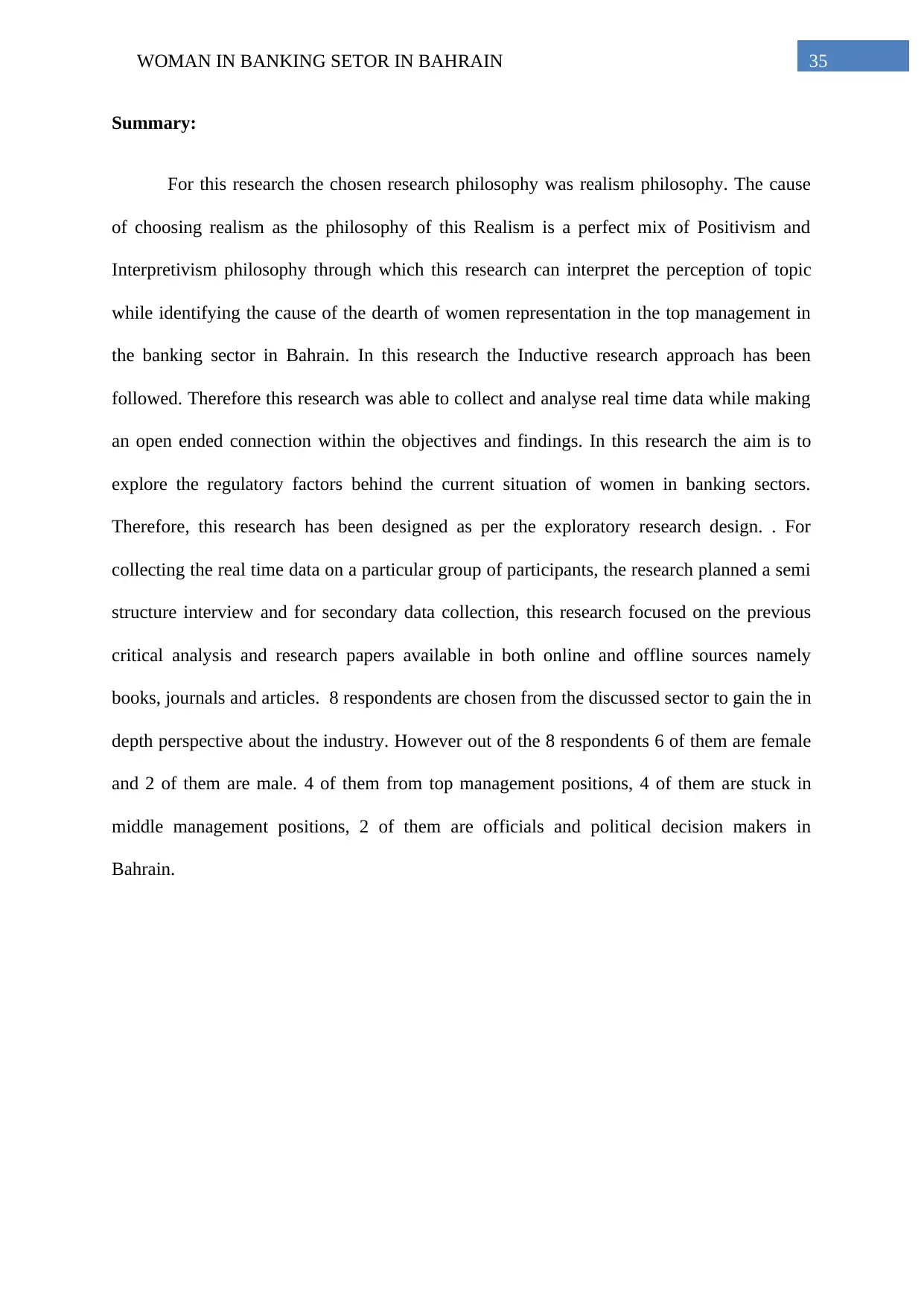
35WOMAN IN BANKING SETOR IN BAHRAIN
Summary:
For this research the chosen research philosophy was realism philosophy. The cause
of choosing realism as the philosophy of this Realism is a perfect mix of Positivism and
Interpretivism philosophy through which this research can interpret the perception of topic
while identifying the cause of the dearth of women representation in the top management in
the banking sector in Bahrain. In this research the Inductive research approach has been
followed. Therefore this research was able to collect and analyse real time data while making
an open ended connection within the objectives and findings. In this research the aim is to
explore the regulatory factors behind the current situation of women in banking sectors.
Therefore, this research has been designed as per the exploratory research design. . For
collecting the real time data on a particular group of participants, the research planned a semi
structure interview and for secondary data collection, this research focused on the previous
critical analysis and research papers available in both online and offline sources namely
books, journals and articles. 8 respondents are chosen from the discussed sector to gain the in
depth perspective about the industry. However out of the 8 respondents 6 of them are female
and 2 of them are male. 4 of them from top management positions, 4 of them are stuck in
middle management positions, 2 of them are officials and political decision makers in
Bahrain.
Summary:
For this research the chosen research philosophy was realism philosophy. The cause
of choosing realism as the philosophy of this Realism is a perfect mix of Positivism and
Interpretivism philosophy through which this research can interpret the perception of topic
while identifying the cause of the dearth of women representation in the top management in
the banking sector in Bahrain. In this research the Inductive research approach has been
followed. Therefore this research was able to collect and analyse real time data while making
an open ended connection within the objectives and findings. In this research the aim is to
explore the regulatory factors behind the current situation of women in banking sectors.
Therefore, this research has been designed as per the exploratory research design. . For
collecting the real time data on a particular group of participants, the research planned a semi
structure interview and for secondary data collection, this research focused on the previous
critical analysis and research papers available in both online and offline sources namely
books, journals and articles. 8 respondents are chosen from the discussed sector to gain the in
depth perspective about the industry. However out of the 8 respondents 6 of them are female
and 2 of them are male. 4 of them from top management positions, 4 of them are stuck in
middle management positions, 2 of them are officials and political decision makers in
Bahrain.
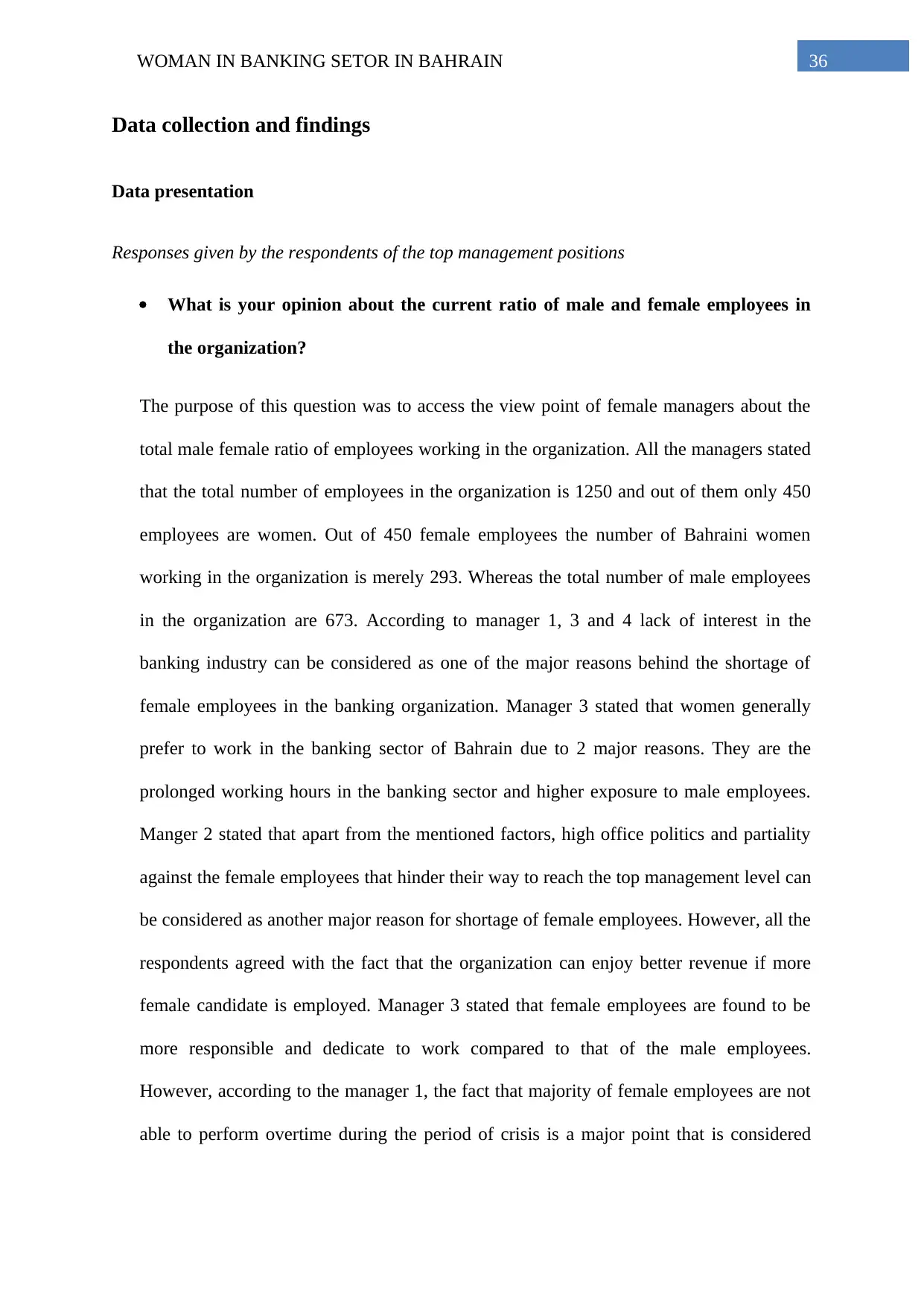
36WOMAN IN BANKING SETOR IN BAHRAIN
Data collection and findings
Data presentation
Responses given by the respondents of the top management positions
What is your opinion about the current ratio of male and female employees in
the organization?
The purpose of this question was to access the view point of female managers about the
total male female ratio of employees working in the organization. All the managers stated
that the total number of employees in the organization is 1250 and out of them only 450
employees are women. Out of 450 female employees the number of Bahraini women
working in the organization is merely 293. Whereas the total number of male employees
in the organization are 673. According to manager 1, 3 and 4 lack of interest in the
banking industry can be considered as one of the major reasons behind the shortage of
female employees in the banking organization. Manager 3 stated that women generally
prefer to work in the banking sector of Bahrain due to 2 major reasons. They are the
prolonged working hours in the banking sector and higher exposure to male employees.
Manger 2 stated that apart from the mentioned factors, high office politics and partiality
against the female employees that hinder their way to reach the top management level can
be considered as another major reason for shortage of female employees. However, all the
respondents agreed with the fact that the organization can enjoy better revenue if more
female candidate is employed. Manager 3 stated that female employees are found to be
more responsible and dedicate to work compared to that of the male employees.
However, according to the manager 1, the fact that majority of female employees are not
able to perform overtime during the period of crisis is a major point that is considered
Data collection and findings
Data presentation
Responses given by the respondents of the top management positions
What is your opinion about the current ratio of male and female employees in
the organization?
The purpose of this question was to access the view point of female managers about the
total male female ratio of employees working in the organization. All the managers stated
that the total number of employees in the organization is 1250 and out of them only 450
employees are women. Out of 450 female employees the number of Bahraini women
working in the organization is merely 293. Whereas the total number of male employees
in the organization are 673. According to manager 1, 3 and 4 lack of interest in the
banking industry can be considered as one of the major reasons behind the shortage of
female employees in the banking organization. Manager 3 stated that women generally
prefer to work in the banking sector of Bahrain due to 2 major reasons. They are the
prolonged working hours in the banking sector and higher exposure to male employees.
Manger 2 stated that apart from the mentioned factors, high office politics and partiality
against the female employees that hinder their way to reach the top management level can
be considered as another major reason for shortage of female employees. However, all the
respondents agreed with the fact that the organization can enjoy better revenue if more
female candidate is employed. Manager 3 stated that female employees are found to be
more responsible and dedicate to work compared to that of the male employees.
However, according to the manager 1, the fact that majority of female employees are not
able to perform overtime during the period of crisis is a major point that is considered
Paraphrase This Document
Need a fresh take? Get an instant paraphrase of this document with our AI Paraphraser
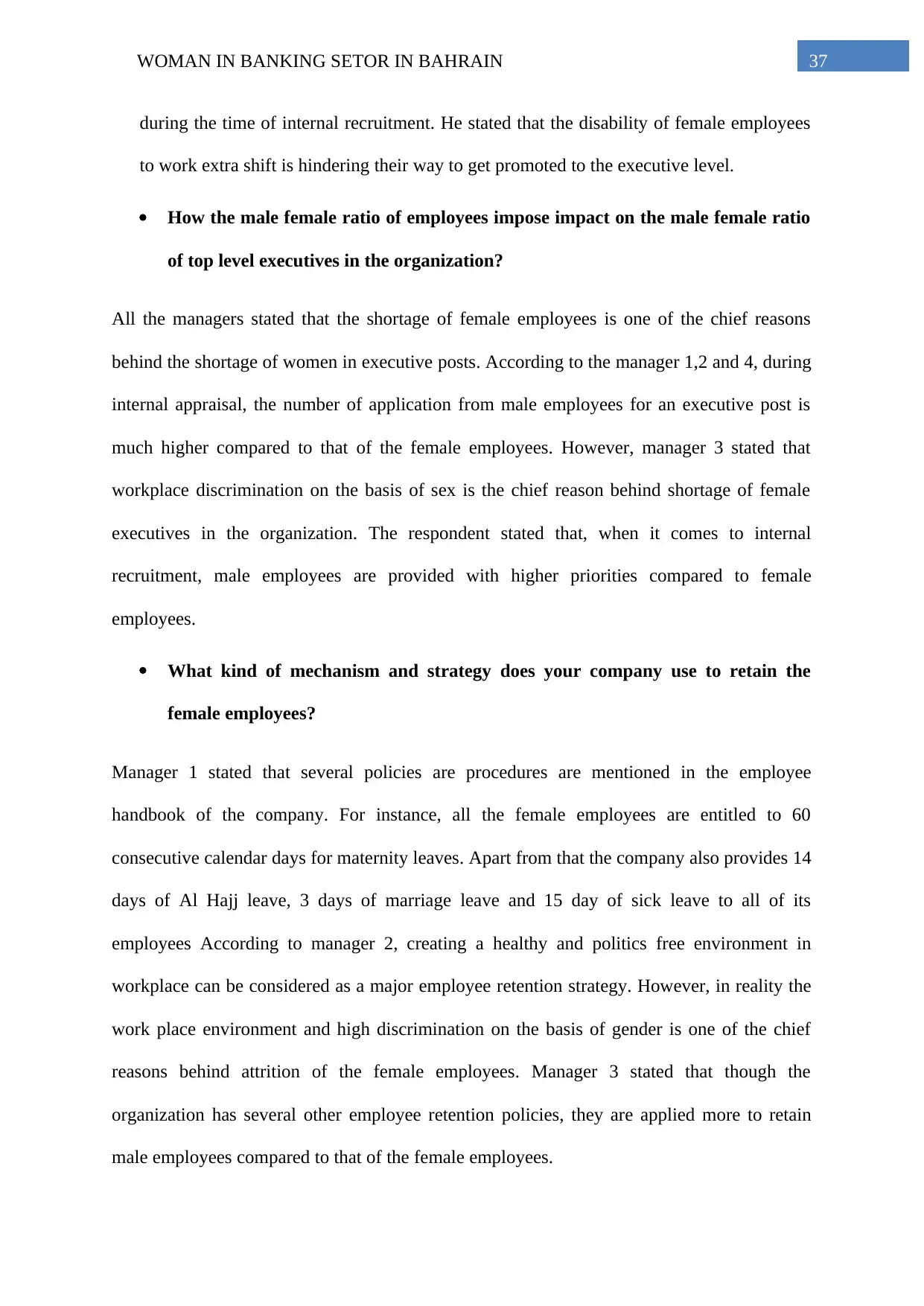
37WOMAN IN BANKING SETOR IN BAHRAIN
during the time of internal recruitment. He stated that the disability of female employees
to work extra shift is hindering their way to get promoted to the executive level.
How the male female ratio of employees impose impact on the male female ratio
of top level executives in the organization?
All the managers stated that the shortage of female employees is one of the chief reasons
behind the shortage of women in executive posts. According to the manager 1,2 and 4, during
internal appraisal, the number of application from male employees for an executive post is
much higher compared to that of the female employees. However, manager 3 stated that
workplace discrimination on the basis of sex is the chief reason behind shortage of female
executives in the organization. The respondent stated that, when it comes to internal
recruitment, male employees are provided with higher priorities compared to female
employees.
What kind of mechanism and strategy does your company use to retain the
female employees?
Manager 1 stated that several policies are procedures are mentioned in the employee
handbook of the company. For instance, all the female employees are entitled to 60
consecutive calendar days for maternity leaves. Apart from that the company also provides 14
days of Al Hajj leave, 3 days of marriage leave and 15 day of sick leave to all of its
employees According to manager 2, creating a healthy and politics free environment in
workplace can be considered as a major employee retention strategy. However, in reality the
work place environment and high discrimination on the basis of gender is one of the chief
reasons behind attrition of the female employees. Manager 3 stated that though the
organization has several other employee retention policies, they are applied more to retain
male employees compared to that of the female employees.
during the time of internal recruitment. He stated that the disability of female employees
to work extra shift is hindering their way to get promoted to the executive level.
How the male female ratio of employees impose impact on the male female ratio
of top level executives in the organization?
All the managers stated that the shortage of female employees is one of the chief reasons
behind the shortage of women in executive posts. According to the manager 1,2 and 4, during
internal appraisal, the number of application from male employees for an executive post is
much higher compared to that of the female employees. However, manager 3 stated that
workplace discrimination on the basis of sex is the chief reason behind shortage of female
executives in the organization. The respondent stated that, when it comes to internal
recruitment, male employees are provided with higher priorities compared to female
employees.
What kind of mechanism and strategy does your company use to retain the
female employees?
Manager 1 stated that several policies are procedures are mentioned in the employee
handbook of the company. For instance, all the female employees are entitled to 60
consecutive calendar days for maternity leaves. Apart from that the company also provides 14
days of Al Hajj leave, 3 days of marriage leave and 15 day of sick leave to all of its
employees According to manager 2, creating a healthy and politics free environment in
workplace can be considered as a major employee retention strategy. However, in reality the
work place environment and high discrimination on the basis of gender is one of the chief
reasons behind attrition of the female employees. Manager 3 stated that though the
organization has several other employee retention policies, they are applied more to retain
male employees compared to that of the female employees.
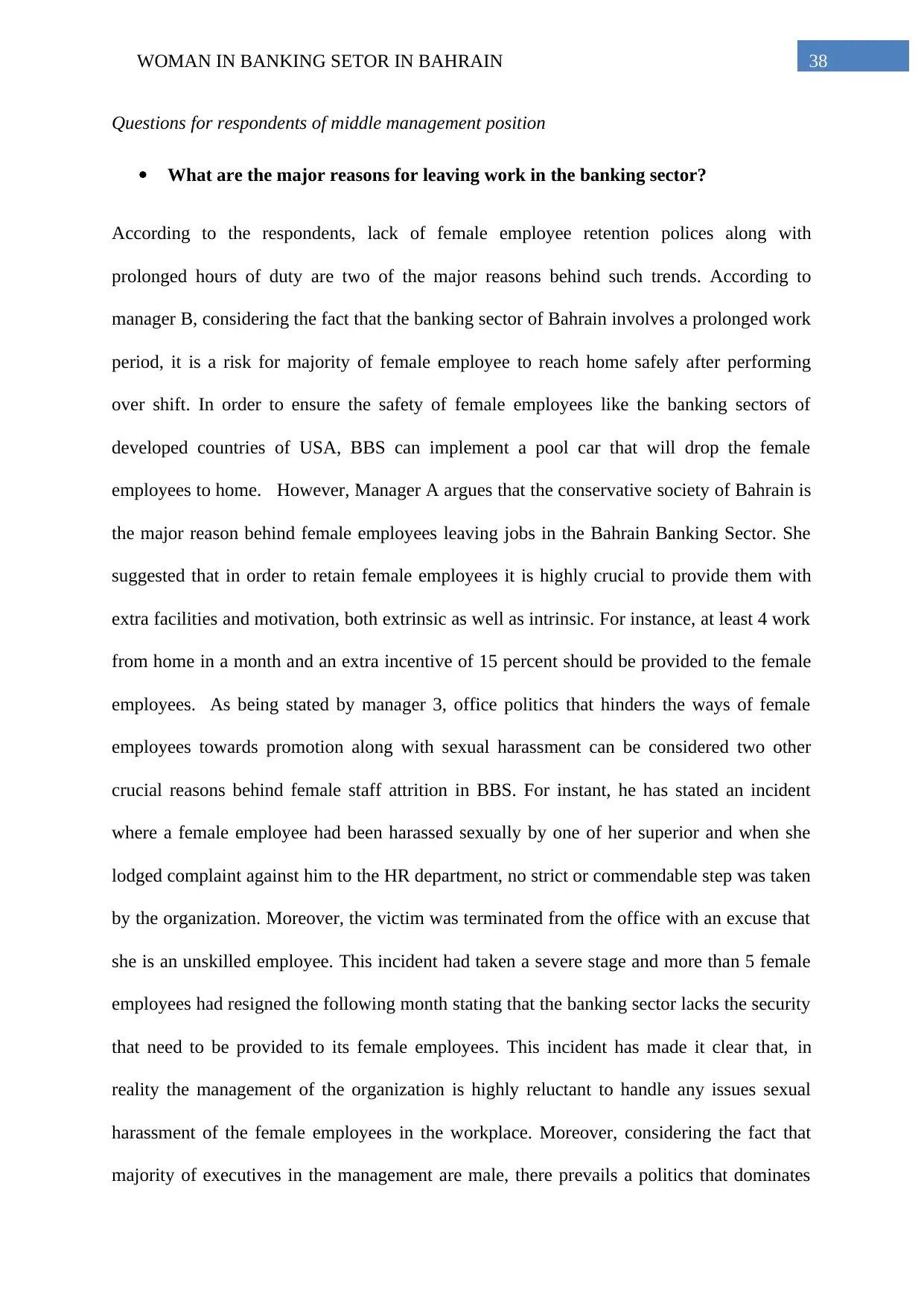
38WOMAN IN BANKING SETOR IN BAHRAIN
Questions for respondents of middle management position
What are the major reasons for leaving work in the banking sector?
According to the respondents, lack of female employee retention polices along with
prolonged hours of duty are two of the major reasons behind such trends. According to
manager B, considering the fact that the banking sector of Bahrain involves a prolonged work
period, it is a risk for majority of female employee to reach home safely after performing
over shift. In order to ensure the safety of female employees like the banking sectors of
developed countries of USA, BBS can implement a pool car that will drop the female
employees to home. However, Manager A argues that the conservative society of Bahrain is
the major reason behind female employees leaving jobs in the Bahrain Banking Sector. She
suggested that in order to retain female employees it is highly crucial to provide them with
extra facilities and motivation, both extrinsic as well as intrinsic. For instance, at least 4 work
from home in a month and an extra incentive of 15 percent should be provided to the female
employees. As being stated by manager 3, office politics that hinders the ways of female
employees towards promotion along with sexual harassment can be considered two other
crucial reasons behind female staff attrition in BBS. For instant, he has stated an incident
where a female employee had been harassed sexually by one of her superior and when she
lodged complaint against him to the HR department, no strict or commendable step was taken
by the organization. Moreover, the victim was terminated from the office with an excuse that
she is an unskilled employee. This incident had taken a severe stage and more than 5 female
employees had resigned the following month stating that the banking sector lacks the security
that need to be provided to its female employees. This incident has made it clear that, in
reality the management of the organization is highly reluctant to handle any issues sexual
harassment of the female employees in the workplace. Moreover, considering the fact that
majority of executives in the management are male, there prevails a politics that dominates
Questions for respondents of middle management position
What are the major reasons for leaving work in the banking sector?
According to the respondents, lack of female employee retention polices along with
prolonged hours of duty are two of the major reasons behind such trends. According to
manager B, considering the fact that the banking sector of Bahrain involves a prolonged work
period, it is a risk for majority of female employee to reach home safely after performing
over shift. In order to ensure the safety of female employees like the banking sectors of
developed countries of USA, BBS can implement a pool car that will drop the female
employees to home. However, Manager A argues that the conservative society of Bahrain is
the major reason behind female employees leaving jobs in the Bahrain Banking Sector. She
suggested that in order to retain female employees it is highly crucial to provide them with
extra facilities and motivation, both extrinsic as well as intrinsic. For instance, at least 4 work
from home in a month and an extra incentive of 15 percent should be provided to the female
employees. As being stated by manager 3, office politics that hinders the ways of female
employees towards promotion along with sexual harassment can be considered two other
crucial reasons behind female staff attrition in BBS. For instant, he has stated an incident
where a female employee had been harassed sexually by one of her superior and when she
lodged complaint against him to the HR department, no strict or commendable step was taken
by the organization. Moreover, the victim was terminated from the office with an excuse that
she is an unskilled employee. This incident had taken a severe stage and more than 5 female
employees had resigned the following month stating that the banking sector lacks the security
that need to be provided to its female employees. This incident has made it clear that, in
reality the management of the organization is highly reluctant to handle any issues sexual
harassment of the female employees in the workplace. Moreover, considering the fact that
majority of executives in the management are male, there prevails a politics that dominates
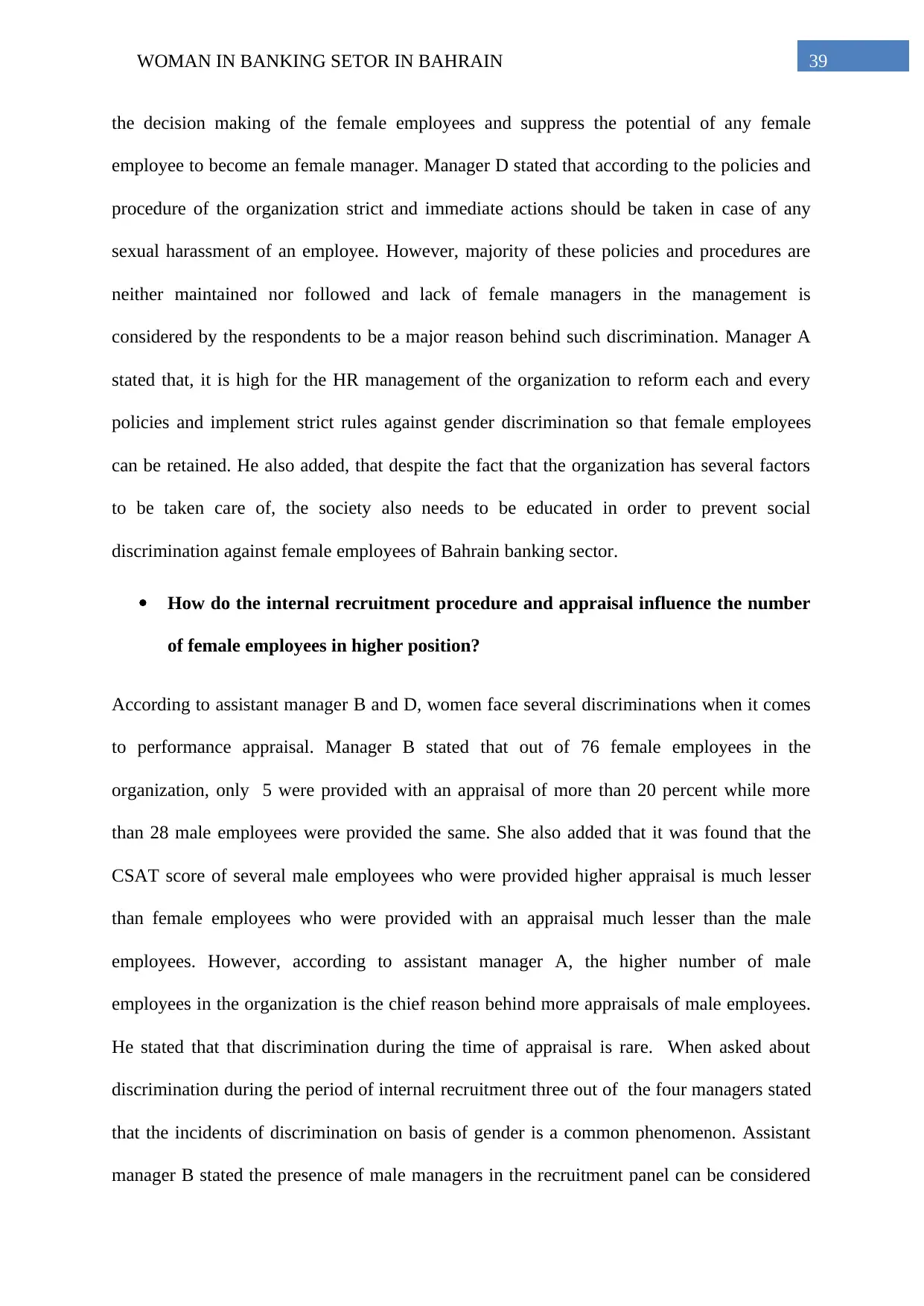
39WOMAN IN BANKING SETOR IN BAHRAIN
the decision making of the female employees and suppress the potential of any female
employee to become an female manager. Manager D stated that according to the policies and
procedure of the organization strict and immediate actions should be taken in case of any
sexual harassment of an employee. However, majority of these policies and procedures are
neither maintained nor followed and lack of female managers in the management is
considered by the respondents to be a major reason behind such discrimination. Manager A
stated that, it is high for the HR management of the organization to reform each and every
policies and implement strict rules against gender discrimination so that female employees
can be retained. He also added, that despite the fact that the organization has several factors
to be taken care of, the society also needs to be educated in order to prevent social
discrimination against female employees of Bahrain banking sector.
How do the internal recruitment procedure and appraisal influence the number
of female employees in higher position?
According to assistant manager B and D, women face several discriminations when it comes
to performance appraisal. Manager B stated that out of 76 female employees in the
organization, only 5 were provided with an appraisal of more than 20 percent while more
than 28 male employees were provided the same. She also added that it was found that the
CSAT score of several male employees who were provided higher appraisal is much lesser
than female employees who were provided with an appraisal much lesser than the male
employees. However, according to assistant manager A, the higher number of male
employees in the organization is the chief reason behind more appraisals of male employees.
He stated that that discrimination during the time of appraisal is rare. When asked about
discrimination during the period of internal recruitment three out of the four managers stated
that the incidents of discrimination on basis of gender is a common phenomenon. Assistant
manager B stated the presence of male managers in the recruitment panel can be considered
the decision making of the female employees and suppress the potential of any female
employee to become an female manager. Manager D stated that according to the policies and
procedure of the organization strict and immediate actions should be taken in case of any
sexual harassment of an employee. However, majority of these policies and procedures are
neither maintained nor followed and lack of female managers in the management is
considered by the respondents to be a major reason behind such discrimination. Manager A
stated that, it is high for the HR management of the organization to reform each and every
policies and implement strict rules against gender discrimination so that female employees
can be retained. He also added, that despite the fact that the organization has several factors
to be taken care of, the society also needs to be educated in order to prevent social
discrimination against female employees of Bahrain banking sector.
How do the internal recruitment procedure and appraisal influence the number
of female employees in higher position?
According to assistant manager B and D, women face several discriminations when it comes
to performance appraisal. Manager B stated that out of 76 female employees in the
organization, only 5 were provided with an appraisal of more than 20 percent while more
than 28 male employees were provided the same. She also added that it was found that the
CSAT score of several male employees who were provided higher appraisal is much lesser
than female employees who were provided with an appraisal much lesser than the male
employees. However, according to assistant manager A, the higher number of male
employees in the organization is the chief reason behind more appraisals of male employees.
He stated that that discrimination during the time of appraisal is rare. When asked about
discrimination during the period of internal recruitment three out of the four managers stated
that the incidents of discrimination on basis of gender is a common phenomenon. Assistant
manager B stated the presence of male managers in the recruitment panel can be considered
Secure Best Marks with AI Grader
Need help grading? Try our AI Grader for instant feedback on your assignments.
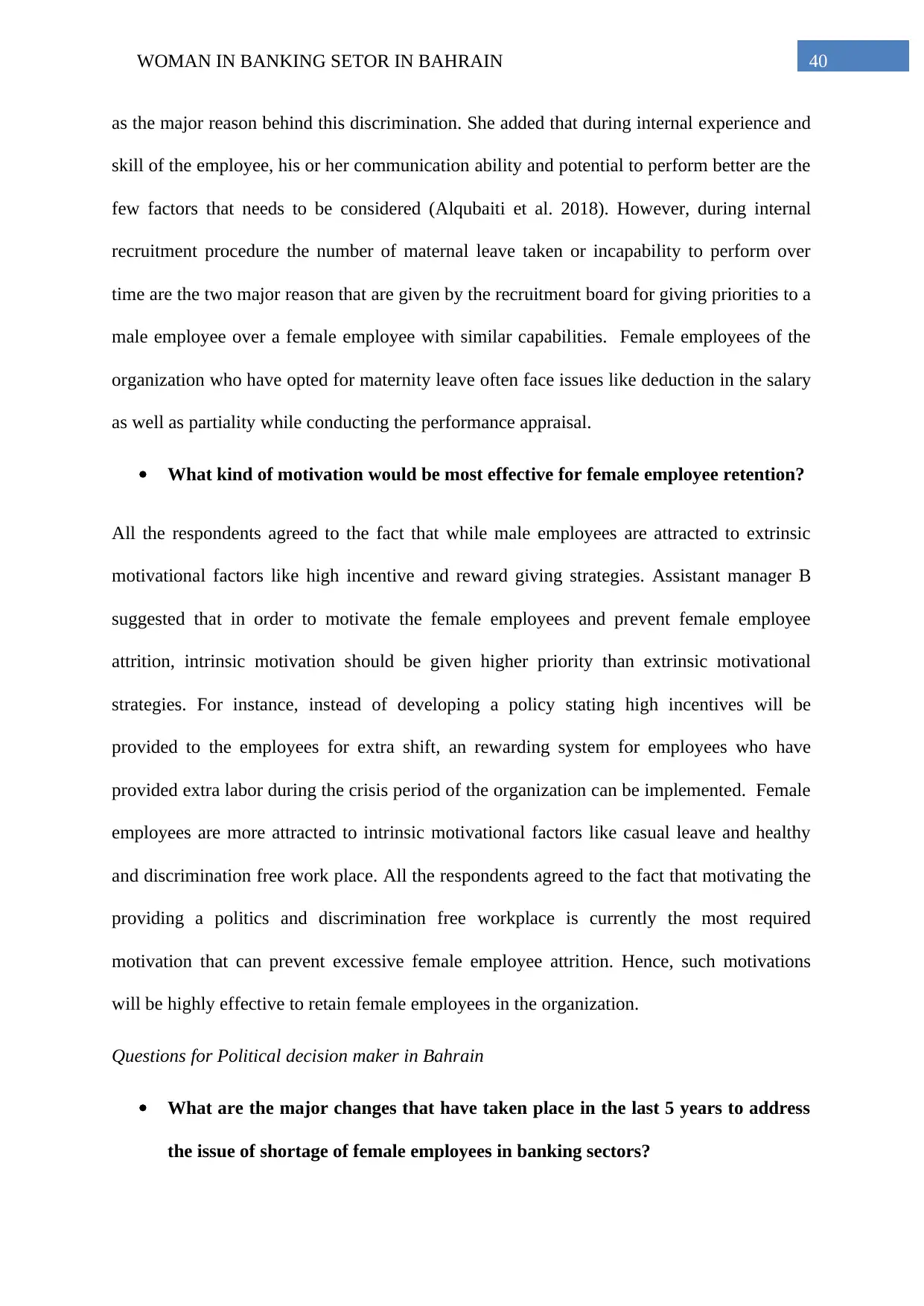
40WOMAN IN BANKING SETOR IN BAHRAIN
as the major reason behind this discrimination. She added that during internal experience and
skill of the employee, his or her communication ability and potential to perform better are the
few factors that needs to be considered (Alqubaiti et al. 2018). However, during internal
recruitment procedure the number of maternal leave taken or incapability to perform over
time are the two major reason that are given by the recruitment board for giving priorities to a
male employee over a female employee with similar capabilities. Female employees of the
organization who have opted for maternity leave often face issues like deduction in the salary
as well as partiality while conducting the performance appraisal.
What kind of motivation would be most effective for female employee retention?
All the respondents agreed to the fact that while male employees are attracted to extrinsic
motivational factors like high incentive and reward giving strategies. Assistant manager B
suggested that in order to motivate the female employees and prevent female employee
attrition, intrinsic motivation should be given higher priority than extrinsic motivational
strategies. For instance, instead of developing a policy stating high incentives will be
provided to the employees for extra shift, an rewarding system for employees who have
provided extra labor during the crisis period of the organization can be implemented. Female
employees are more attracted to intrinsic motivational factors like casual leave and healthy
and discrimination free work place. All the respondents agreed to the fact that motivating the
providing a politics and discrimination free workplace is currently the most required
motivation that can prevent excessive female employee attrition. Hence, such motivations
will be highly effective to retain female employees in the organization.
Questions for Political decision maker in Bahrain
What are the major changes that have taken place in the last 5 years to address
the issue of shortage of female employees in banking sectors?
as the major reason behind this discrimination. She added that during internal experience and
skill of the employee, his or her communication ability and potential to perform better are the
few factors that needs to be considered (Alqubaiti et al. 2018). However, during internal
recruitment procedure the number of maternal leave taken or incapability to perform over
time are the two major reason that are given by the recruitment board for giving priorities to a
male employee over a female employee with similar capabilities. Female employees of the
organization who have opted for maternity leave often face issues like deduction in the salary
as well as partiality while conducting the performance appraisal.
What kind of motivation would be most effective for female employee retention?
All the respondents agreed to the fact that while male employees are attracted to extrinsic
motivational factors like high incentive and reward giving strategies. Assistant manager B
suggested that in order to motivate the female employees and prevent female employee
attrition, intrinsic motivation should be given higher priority than extrinsic motivational
strategies. For instance, instead of developing a policy stating high incentives will be
provided to the employees for extra shift, an rewarding system for employees who have
provided extra labor during the crisis period of the organization can be implemented. Female
employees are more attracted to intrinsic motivational factors like casual leave and healthy
and discrimination free work place. All the respondents agreed to the fact that motivating the
providing a politics and discrimination free workplace is currently the most required
motivation that can prevent excessive female employee attrition. Hence, such motivations
will be highly effective to retain female employees in the organization.
Questions for Political decision maker in Bahrain
What are the major changes that have taken place in the last 5 years to address
the issue of shortage of female employees in banking sectors?
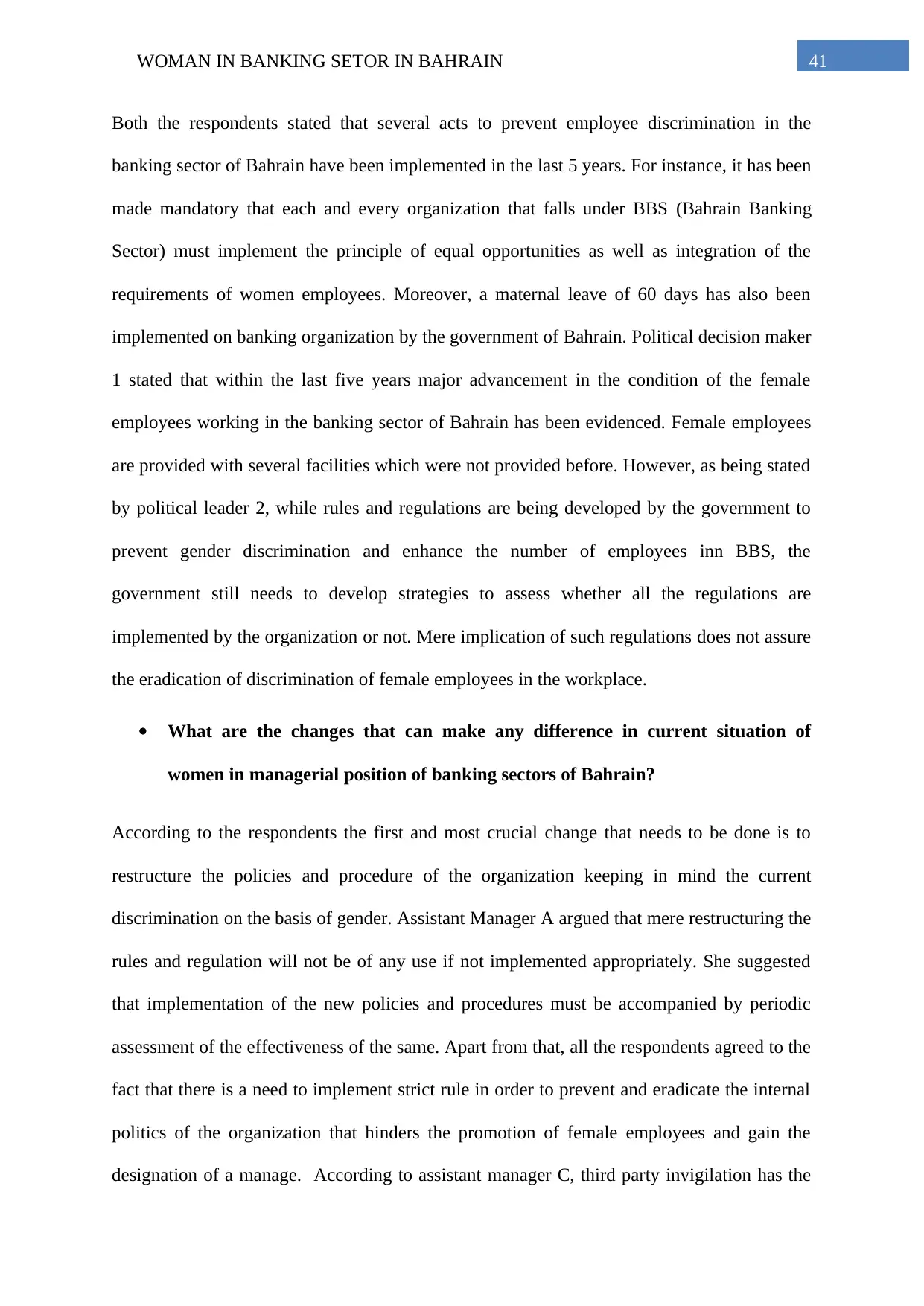
41WOMAN IN BANKING SETOR IN BAHRAIN
Both the respondents stated that several acts to prevent employee discrimination in the
banking sector of Bahrain have been implemented in the last 5 years. For instance, it has been
made mandatory that each and every organization that falls under BBS (Bahrain Banking
Sector) must implement the principle of equal opportunities as well as integration of the
requirements of women employees. Moreover, a maternal leave of 60 days has also been
implemented on banking organization by the government of Bahrain. Political decision maker
1 stated that within the last five years major advancement in the condition of the female
employees working in the banking sector of Bahrain has been evidenced. Female employees
are provided with several facilities which were not provided before. However, as being stated
by political leader 2, while rules and regulations are being developed by the government to
prevent gender discrimination and enhance the number of employees inn BBS, the
government still needs to develop strategies to assess whether all the regulations are
implemented by the organization or not. Mere implication of such regulations does not assure
the eradication of discrimination of female employees in the workplace.
What are the changes that can make any difference in current situation of
women in managerial position of banking sectors of Bahrain?
According to the respondents the first and most crucial change that needs to be done is to
restructure the policies and procedure of the organization keeping in mind the current
discrimination on the basis of gender. Assistant Manager A argued that mere restructuring the
rules and regulation will not be of any use if not implemented appropriately. She suggested
that implementation of the new policies and procedures must be accompanied by periodic
assessment of the effectiveness of the same. Apart from that, all the respondents agreed to the
fact that there is a need to implement strict rule in order to prevent and eradicate the internal
politics of the organization that hinders the promotion of female employees and gain the
designation of a manage. According to assistant manager C, third party invigilation has the
Both the respondents stated that several acts to prevent employee discrimination in the
banking sector of Bahrain have been implemented in the last 5 years. For instance, it has been
made mandatory that each and every organization that falls under BBS (Bahrain Banking
Sector) must implement the principle of equal opportunities as well as integration of the
requirements of women employees. Moreover, a maternal leave of 60 days has also been
implemented on banking organization by the government of Bahrain. Political decision maker
1 stated that within the last five years major advancement in the condition of the female
employees working in the banking sector of Bahrain has been evidenced. Female employees
are provided with several facilities which were not provided before. However, as being stated
by political leader 2, while rules and regulations are being developed by the government to
prevent gender discrimination and enhance the number of employees inn BBS, the
government still needs to develop strategies to assess whether all the regulations are
implemented by the organization or not. Mere implication of such regulations does not assure
the eradication of discrimination of female employees in the workplace.
What are the changes that can make any difference in current situation of
women in managerial position of banking sectors of Bahrain?
According to the respondents the first and most crucial change that needs to be done is to
restructure the policies and procedure of the organization keeping in mind the current
discrimination on the basis of gender. Assistant Manager A argued that mere restructuring the
rules and regulation will not be of any use if not implemented appropriately. She suggested
that implementation of the new policies and procedures must be accompanied by periodic
assessment of the effectiveness of the same. Apart from that, all the respondents agreed to the
fact that there is a need to implement strict rule in order to prevent and eradicate the internal
politics of the organization that hinders the promotion of female employees and gain the
designation of a manage. According to assistant manager C, third party invigilation has the
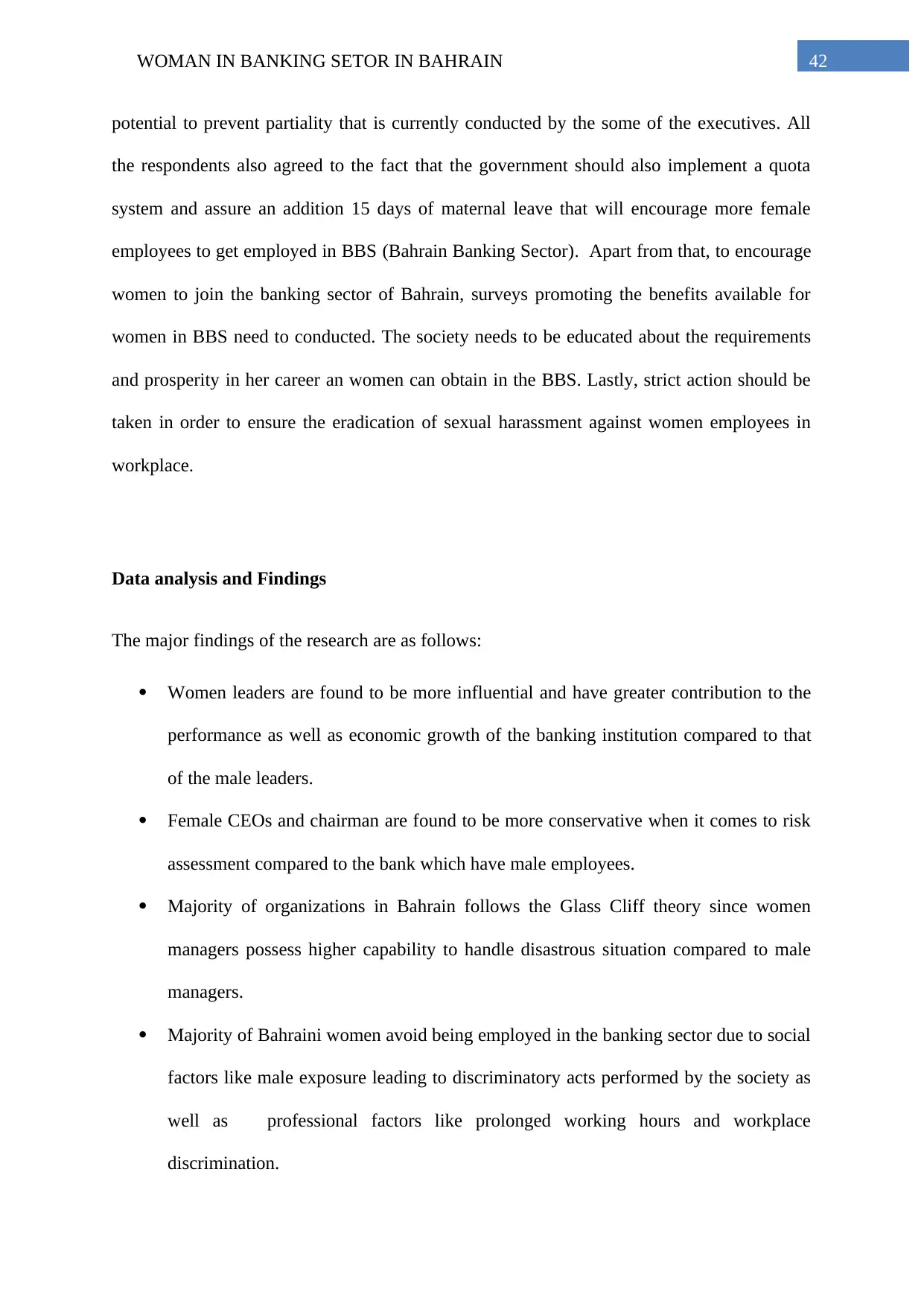
42WOMAN IN BANKING SETOR IN BAHRAIN
potential to prevent partiality that is currently conducted by the some of the executives. All
the respondents also agreed to the fact that the government should also implement a quota
system and assure an addition 15 days of maternal leave that will encourage more female
employees to get employed in BBS (Bahrain Banking Sector). Apart from that, to encourage
women to join the banking sector of Bahrain, surveys promoting the benefits available for
women in BBS need to conducted. The society needs to be educated about the requirements
and prosperity in her career an women can obtain in the BBS. Lastly, strict action should be
taken in order to ensure the eradication of sexual harassment against women employees in
workplace.
Data analysis and Findings
The major findings of the research are as follows:
Women leaders are found to be more influential and have greater contribution to the
performance as well as economic growth of the banking institution compared to that
of the male leaders.
Female CEOs and chairman are found to be more conservative when it comes to risk
assessment compared to the bank which have male employees.
Majority of organizations in Bahrain follows the Glass Cliff theory since women
managers possess higher capability to handle disastrous situation compared to male
managers.
Majority of Bahraini women avoid being employed in the banking sector due to social
factors like male exposure leading to discriminatory acts performed by the society as
well as professional factors like prolonged working hours and workplace
discrimination.
potential to prevent partiality that is currently conducted by the some of the executives. All
the respondents also agreed to the fact that the government should also implement a quota
system and assure an addition 15 days of maternal leave that will encourage more female
employees to get employed in BBS (Bahrain Banking Sector). Apart from that, to encourage
women to join the banking sector of Bahrain, surveys promoting the benefits available for
women in BBS need to conducted. The society needs to be educated about the requirements
and prosperity in her career an women can obtain in the BBS. Lastly, strict action should be
taken in order to ensure the eradication of sexual harassment against women employees in
workplace.
Data analysis and Findings
The major findings of the research are as follows:
Women leaders are found to be more influential and have greater contribution to the
performance as well as economic growth of the banking institution compared to that
of the male leaders.
Female CEOs and chairman are found to be more conservative when it comes to risk
assessment compared to the bank which have male employees.
Majority of organizations in Bahrain follows the Glass Cliff theory since women
managers possess higher capability to handle disastrous situation compared to male
managers.
Majority of Bahraini women avoid being employed in the banking sector due to social
factors like male exposure leading to discriminatory acts performed by the society as
well as professional factors like prolonged working hours and workplace
discrimination.
Paraphrase This Document
Need a fresh take? Get an instant paraphrase of this document with our AI Paraphraser
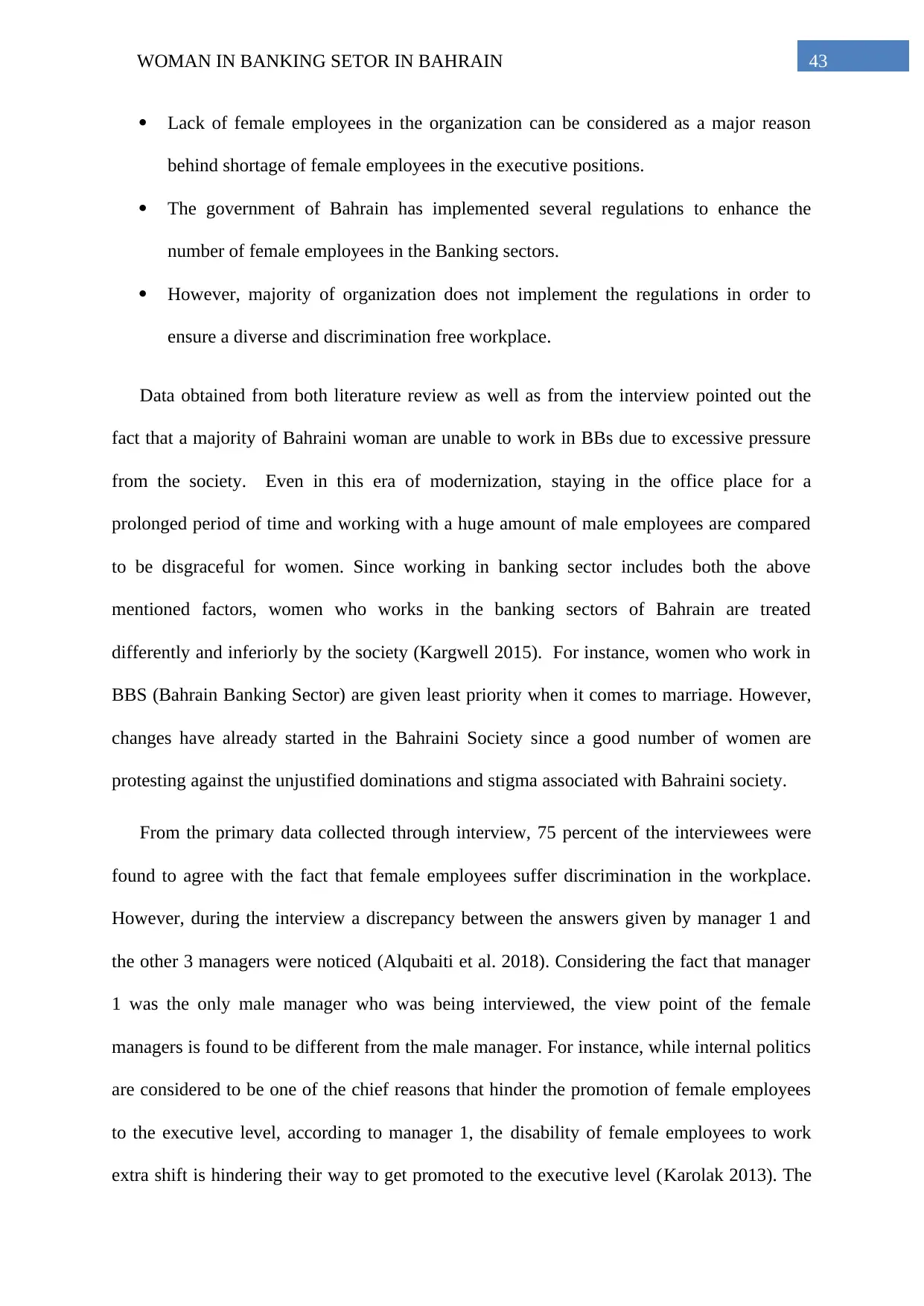
43WOMAN IN BANKING SETOR IN BAHRAIN
Lack of female employees in the organization can be considered as a major reason
behind shortage of female employees in the executive positions.
The government of Bahrain has implemented several regulations to enhance the
number of female employees in the Banking sectors.
However, majority of organization does not implement the regulations in order to
ensure a diverse and discrimination free workplace.
Data obtained from both literature review as well as from the interview pointed out the
fact that a majority of Bahraini woman are unable to work in BBs due to excessive pressure
from the society. Even in this era of modernization, staying in the office place for a
prolonged period of time and working with a huge amount of male employees are compared
to be disgraceful for women. Since working in banking sector includes both the above
mentioned factors, women who works in the banking sectors of Bahrain are treated
differently and inferiorly by the society (Kargwell 2015). For instance, women who work in
BBS (Bahrain Banking Sector) are given least priority when it comes to marriage. However,
changes have already started in the Bahraini Society since a good number of women are
protesting against the unjustified dominations and stigma associated with Bahraini society.
From the primary data collected through interview, 75 percent of the interviewees were
found to agree with the fact that female employees suffer discrimination in the workplace.
However, during the interview a discrepancy between the answers given by manager 1 and
the other 3 managers were noticed (Alqubaiti et al. 2018). Considering the fact that manager
1 was the only male manager who was being interviewed, the view point of the female
managers is found to be different from the male manager. For instance, while internal politics
are considered to be one of the chief reasons that hinder the promotion of female employees
to the executive level, according to manager 1, the disability of female employees to work
extra shift is hindering their way to get promoted to the executive level (Karolak 2013). The
Lack of female employees in the organization can be considered as a major reason
behind shortage of female employees in the executive positions.
The government of Bahrain has implemented several regulations to enhance the
number of female employees in the Banking sectors.
However, majority of organization does not implement the regulations in order to
ensure a diverse and discrimination free workplace.
Data obtained from both literature review as well as from the interview pointed out the
fact that a majority of Bahraini woman are unable to work in BBs due to excessive pressure
from the society. Even in this era of modernization, staying in the office place for a
prolonged period of time and working with a huge amount of male employees are compared
to be disgraceful for women. Since working in banking sector includes both the above
mentioned factors, women who works in the banking sectors of Bahrain are treated
differently and inferiorly by the society (Kargwell 2015). For instance, women who work in
BBS (Bahrain Banking Sector) are given least priority when it comes to marriage. However,
changes have already started in the Bahraini Society since a good number of women are
protesting against the unjustified dominations and stigma associated with Bahraini society.
From the primary data collected through interview, 75 percent of the interviewees were
found to agree with the fact that female employees suffer discrimination in the workplace.
However, during the interview a discrepancy between the answers given by manager 1 and
the other 3 managers were noticed (Alqubaiti et al. 2018). Considering the fact that manager
1 was the only male manager who was being interviewed, the view point of the female
managers is found to be different from the male manager. For instance, while internal politics
are considered to be one of the chief reasons that hinder the promotion of female employees
to the executive level, according to manager 1, the disability of female employees to work
extra shift is hindering their way to get promoted to the executive level (Karolak 2013). The
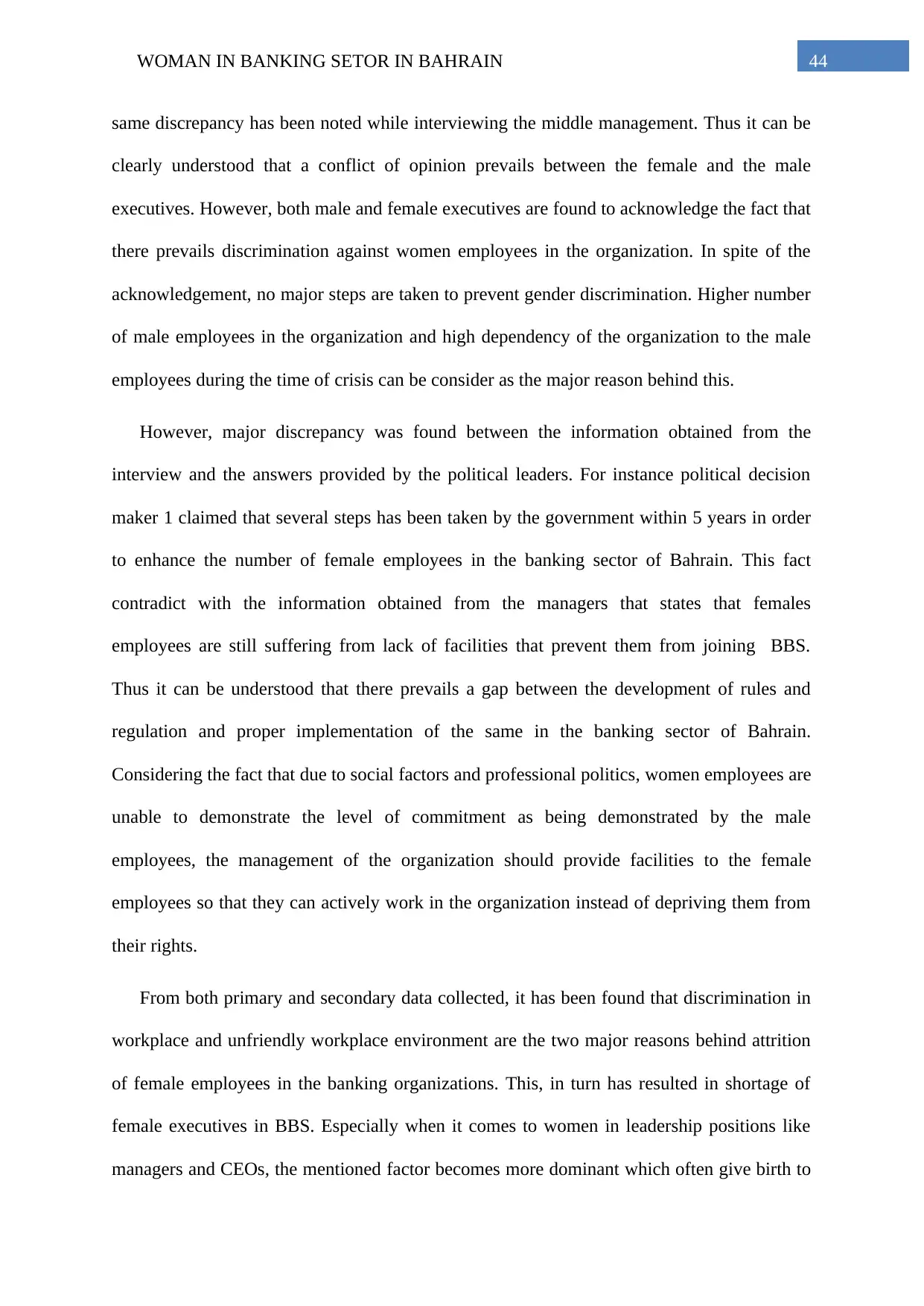
44WOMAN IN BANKING SETOR IN BAHRAIN
same discrepancy has been noted while interviewing the middle management. Thus it can be
clearly understood that a conflict of opinion prevails between the female and the male
executives. However, both male and female executives are found to acknowledge the fact that
there prevails discrimination against women employees in the organization. In spite of the
acknowledgement, no major steps are taken to prevent gender discrimination. Higher number
of male employees in the organization and high dependency of the organization to the male
employees during the time of crisis can be consider as the major reason behind this.
However, major discrepancy was found between the information obtained from the
interview and the answers provided by the political leaders. For instance political decision
maker 1 claimed that several steps has been taken by the government within 5 years in order
to enhance the number of female employees in the banking sector of Bahrain. This fact
contradict with the information obtained from the managers that states that females
employees are still suffering from lack of facilities that prevent them from joining BBS.
Thus it can be understood that there prevails a gap between the development of rules and
regulation and proper implementation of the same in the banking sector of Bahrain.
Considering the fact that due to social factors and professional politics, women employees are
unable to demonstrate the level of commitment as being demonstrated by the male
employees, the management of the organization should provide facilities to the female
employees so that they can actively work in the organization instead of depriving them from
their rights.
From both primary and secondary data collected, it has been found that discrimination in
workplace and unfriendly workplace environment are the two major reasons behind attrition
of female employees in the banking organizations. This, in turn has resulted in shortage of
female executives in BBS. Especially when it comes to women in leadership positions like
managers and CEOs, the mentioned factor becomes more dominant which often give birth to
same discrepancy has been noted while interviewing the middle management. Thus it can be
clearly understood that a conflict of opinion prevails between the female and the male
executives. However, both male and female executives are found to acknowledge the fact that
there prevails discrimination against women employees in the organization. In spite of the
acknowledgement, no major steps are taken to prevent gender discrimination. Higher number
of male employees in the organization and high dependency of the organization to the male
employees during the time of crisis can be consider as the major reason behind this.
However, major discrepancy was found between the information obtained from the
interview and the answers provided by the political leaders. For instance political decision
maker 1 claimed that several steps has been taken by the government within 5 years in order
to enhance the number of female employees in the banking sector of Bahrain. This fact
contradict with the information obtained from the managers that states that females
employees are still suffering from lack of facilities that prevent them from joining BBS.
Thus it can be understood that there prevails a gap between the development of rules and
regulation and proper implementation of the same in the banking sector of Bahrain.
Considering the fact that due to social factors and professional politics, women employees are
unable to demonstrate the level of commitment as being demonstrated by the male
employees, the management of the organization should provide facilities to the female
employees so that they can actively work in the organization instead of depriving them from
their rights.
From both primary and secondary data collected, it has been found that discrimination in
workplace and unfriendly workplace environment are the two major reasons behind attrition
of female employees in the banking organizations. This, in turn has resulted in shortage of
female executives in BBS. Especially when it comes to women in leadership positions like
managers and CEOs, the mentioned factor becomes more dominant which often give birth to
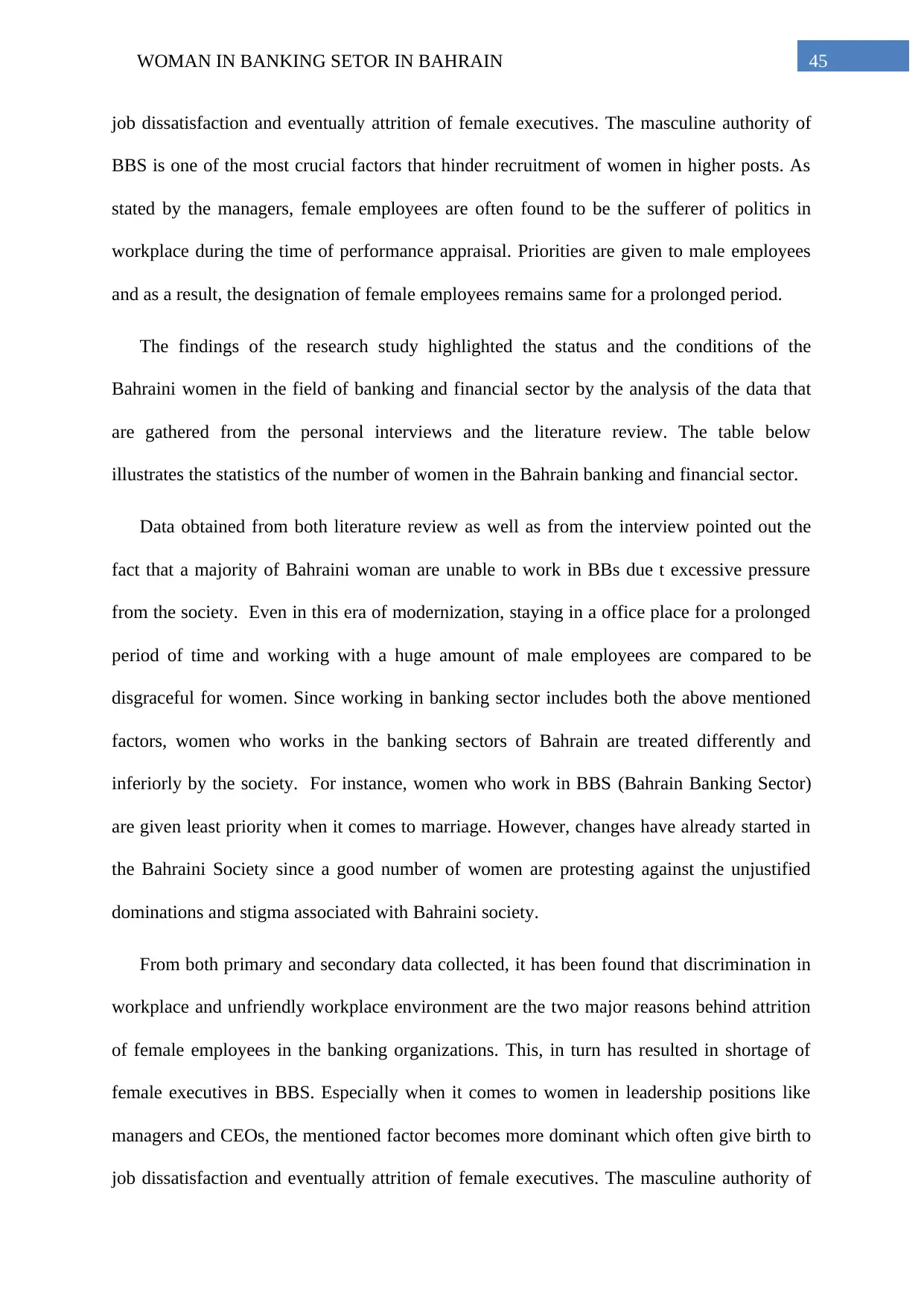
45WOMAN IN BANKING SETOR IN BAHRAIN
job dissatisfaction and eventually attrition of female executives. The masculine authority of
BBS is one of the most crucial factors that hinder recruitment of women in higher posts. As
stated by the managers, female employees are often found to be the sufferer of politics in
workplace during the time of performance appraisal. Priorities are given to male employees
and as a result, the designation of female employees remains same for a prolonged period.
The findings of the research study highlighted the status and the conditions of the
Bahraini women in the field of banking and financial sector by the analysis of the data that
are gathered from the personal interviews and the literature review. The table below
illustrates the statistics of the number of women in the Bahrain banking and financial sector.
Data obtained from both literature review as well as from the interview pointed out the
fact that a majority of Bahraini woman are unable to work in BBs due t excessive pressure
from the society. Even in this era of modernization, staying in a office place for a prolonged
period of time and working with a huge amount of male employees are compared to be
disgraceful for women. Since working in banking sector includes both the above mentioned
factors, women who works in the banking sectors of Bahrain are treated differently and
inferiorly by the society. For instance, women who work in BBS (Bahrain Banking Sector)
are given least priority when it comes to marriage. However, changes have already started in
the Bahraini Society since a good number of women are protesting against the unjustified
dominations and stigma associated with Bahraini society.
From both primary and secondary data collected, it has been found that discrimination in
workplace and unfriendly workplace environment are the two major reasons behind attrition
of female employees in the banking organizations. This, in turn has resulted in shortage of
female executives in BBS. Especially when it comes to women in leadership positions like
managers and CEOs, the mentioned factor becomes more dominant which often give birth to
job dissatisfaction and eventually attrition of female executives. The masculine authority of
job dissatisfaction and eventually attrition of female executives. The masculine authority of
BBS is one of the most crucial factors that hinder recruitment of women in higher posts. As
stated by the managers, female employees are often found to be the sufferer of politics in
workplace during the time of performance appraisal. Priorities are given to male employees
and as a result, the designation of female employees remains same for a prolonged period.
The findings of the research study highlighted the status and the conditions of the
Bahraini women in the field of banking and financial sector by the analysis of the data that
are gathered from the personal interviews and the literature review. The table below
illustrates the statistics of the number of women in the Bahrain banking and financial sector.
Data obtained from both literature review as well as from the interview pointed out the
fact that a majority of Bahraini woman are unable to work in BBs due t excessive pressure
from the society. Even in this era of modernization, staying in a office place for a prolonged
period of time and working with a huge amount of male employees are compared to be
disgraceful for women. Since working in banking sector includes both the above mentioned
factors, women who works in the banking sectors of Bahrain are treated differently and
inferiorly by the society. For instance, women who work in BBS (Bahrain Banking Sector)
are given least priority when it comes to marriage. However, changes have already started in
the Bahraini Society since a good number of women are protesting against the unjustified
dominations and stigma associated with Bahraini society.
From both primary and secondary data collected, it has been found that discrimination in
workplace and unfriendly workplace environment are the two major reasons behind attrition
of female employees in the banking organizations. This, in turn has resulted in shortage of
female executives in BBS. Especially when it comes to women in leadership positions like
managers and CEOs, the mentioned factor becomes more dominant which often give birth to
job dissatisfaction and eventually attrition of female executives. The masculine authority of
Secure Best Marks with AI Grader
Need help grading? Try our AI Grader for instant feedback on your assignments.
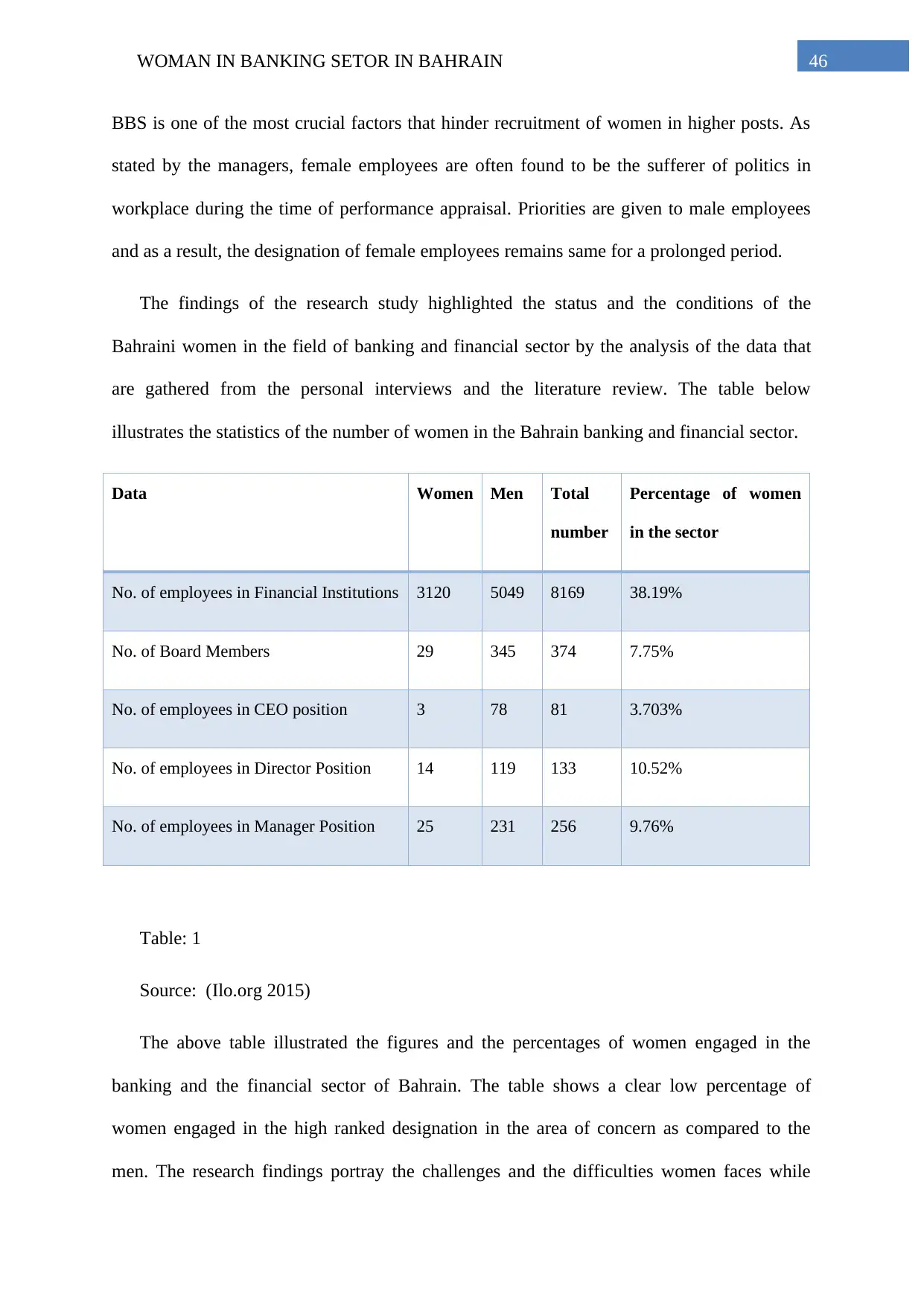
46WOMAN IN BANKING SETOR IN BAHRAIN
BBS is one of the most crucial factors that hinder recruitment of women in higher posts. As
stated by the managers, female employees are often found to be the sufferer of politics in
workplace during the time of performance appraisal. Priorities are given to male employees
and as a result, the designation of female employees remains same for a prolonged period.
The findings of the research study highlighted the status and the conditions of the
Bahraini women in the field of banking and financial sector by the analysis of the data that
are gathered from the personal interviews and the literature review. The table below
illustrates the statistics of the number of women in the Bahrain banking and financial sector.
Data Women Men Total
number
Percentage of women
in the sector
No. of employees in Financial Institutions 3120 5049 8169 38.19%
No. of Board Members 29 345 374 7.75%
No. of employees in CEO position 3 78 81 3.703%
No. of employees in Director Position 14 119 133 10.52%
No. of employees in Manager Position 25 231 256 9.76%
Table: 1
Source: (Ilo.org 2015)
The above table illustrated the figures and the percentages of women engaged in the
banking and the financial sector of Bahrain. The table shows a clear low percentage of
women engaged in the high ranked designation in the area of concern as compared to the
men. The research findings portray the challenges and the difficulties women faces while
BBS is one of the most crucial factors that hinder recruitment of women in higher posts. As
stated by the managers, female employees are often found to be the sufferer of politics in
workplace during the time of performance appraisal. Priorities are given to male employees
and as a result, the designation of female employees remains same for a prolonged period.
The findings of the research study highlighted the status and the conditions of the
Bahraini women in the field of banking and financial sector by the analysis of the data that
are gathered from the personal interviews and the literature review. The table below
illustrates the statistics of the number of women in the Bahrain banking and financial sector.
Data Women Men Total
number
Percentage of women
in the sector
No. of employees in Financial Institutions 3120 5049 8169 38.19%
No. of Board Members 29 345 374 7.75%
No. of employees in CEO position 3 78 81 3.703%
No. of employees in Director Position 14 119 133 10.52%
No. of employees in Manager Position 25 231 256 9.76%
Table: 1
Source: (Ilo.org 2015)
The above table illustrated the figures and the percentages of women engaged in the
banking and the financial sector of Bahrain. The table shows a clear low percentage of
women engaged in the high ranked designation in the area of concern as compared to the
men. The research findings portray the challenges and the difficulties women faces while
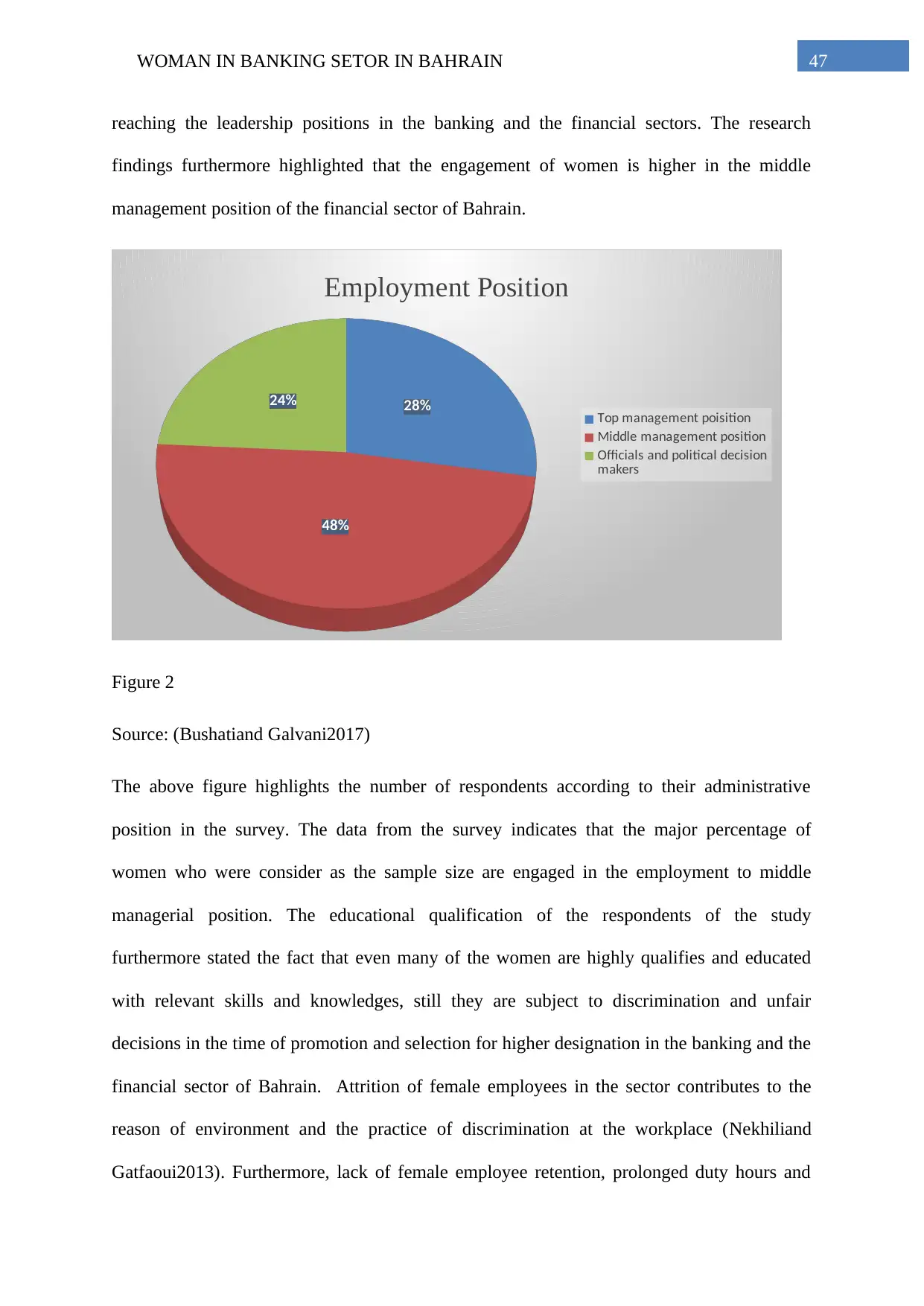
47WOMAN IN BANKING SETOR IN BAHRAIN
reaching the leadership positions in the banking and the financial sectors. The research
findings furthermore highlighted that the engagement of women is higher in the middle
management position of the financial sector of Bahrain.
28%
48%
24%
Employment Position
Top management poisition
Middle management position
Officials and political decision
makers
Figure 2
Source: (Bushatiand Galvani2017)
The above figure highlights the number of respondents according to their administrative
position in the survey. The data from the survey indicates that the major percentage of
women who were consider as the sample size are engaged in the employment to middle
managerial position. The educational qualification of the respondents of the study
furthermore stated the fact that even many of the women are highly qualifies and educated
with relevant skills and knowledges, still they are subject to discrimination and unfair
decisions in the time of promotion and selection for higher designation in the banking and the
financial sector of Bahrain. Attrition of female employees in the sector contributes to the
reason of environment and the practice of discrimination at the workplace (Nekhiliand
Gatfaoui2013). Furthermore, lack of female employee retention, prolonged duty hours and
reaching the leadership positions in the banking and the financial sectors. The research
findings furthermore highlighted that the engagement of women is higher in the middle
management position of the financial sector of Bahrain.
28%
48%
24%
Employment Position
Top management poisition
Middle management position
Officials and political decision
makers
Figure 2
Source: (Bushatiand Galvani2017)
The above figure highlights the number of respondents according to their administrative
position in the survey. The data from the survey indicates that the major percentage of
women who were consider as the sample size are engaged in the employment to middle
managerial position. The educational qualification of the respondents of the study
furthermore stated the fact that even many of the women are highly qualifies and educated
with relevant skills and knowledges, still they are subject to discrimination and unfair
decisions in the time of promotion and selection for higher designation in the banking and the
financial sector of Bahrain. Attrition of female employees in the sector contributes to the
reason of environment and the practice of discrimination at the workplace (Nekhiliand
Gatfaoui2013). Furthermore, lack of female employee retention, prolonged duty hours and
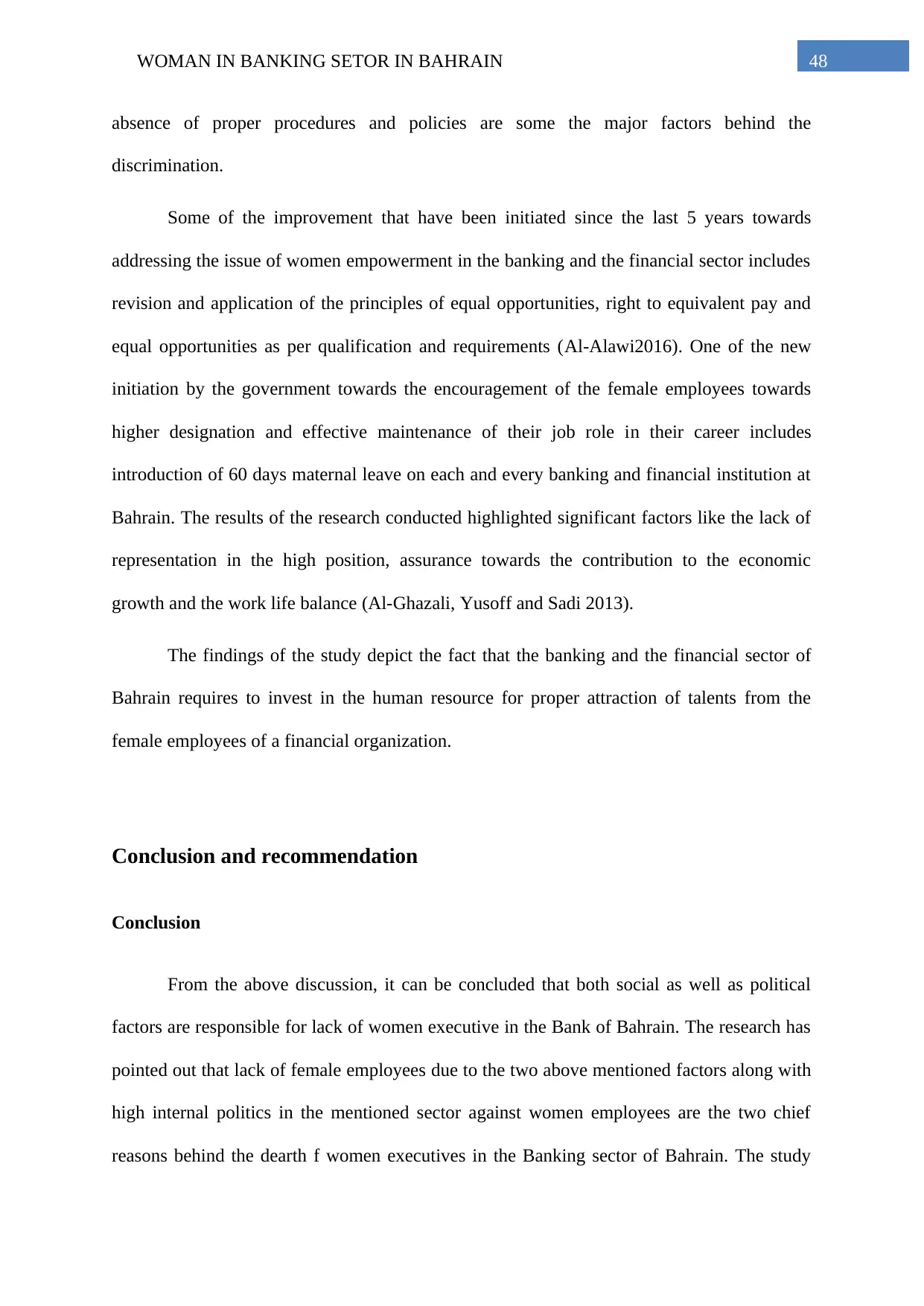
48WOMAN IN BANKING SETOR IN BAHRAIN
absence of proper procedures and policies are some the major factors behind the
discrimination.
Some of the improvement that have been initiated since the last 5 years towards
addressing the issue of women empowerment in the banking and the financial sector includes
revision and application of the principles of equal opportunities, right to equivalent pay and
equal opportunities as per qualification and requirements (Al-Alawi2016). One of the new
initiation by the government towards the encouragement of the female employees towards
higher designation and effective maintenance of their job role in their career includes
introduction of 60 days maternal leave on each and every banking and financial institution at
Bahrain. The results of the research conducted highlighted significant factors like the lack of
representation in the high position, assurance towards the contribution to the economic
growth and the work life balance (Al-Ghazali, Yusoff and Sadi 2013).
The findings of the study depict the fact that the banking and the financial sector of
Bahrain requires to invest in the human resource for proper attraction of talents from the
female employees of a financial organization.
Conclusion and recommendation
Conclusion
From the above discussion, it can be concluded that both social as well as political
factors are responsible for lack of women executive in the Bank of Bahrain. The research has
pointed out that lack of female employees due to the two above mentioned factors along with
high internal politics in the mentioned sector against women employees are the two chief
reasons behind the dearth f women executives in the Banking sector of Bahrain. The study
absence of proper procedures and policies are some the major factors behind the
discrimination.
Some of the improvement that have been initiated since the last 5 years towards
addressing the issue of women empowerment in the banking and the financial sector includes
revision and application of the principles of equal opportunities, right to equivalent pay and
equal opportunities as per qualification and requirements (Al-Alawi2016). One of the new
initiation by the government towards the encouragement of the female employees towards
higher designation and effective maintenance of their job role in their career includes
introduction of 60 days maternal leave on each and every banking and financial institution at
Bahrain. The results of the research conducted highlighted significant factors like the lack of
representation in the high position, assurance towards the contribution to the economic
growth and the work life balance (Al-Ghazali, Yusoff and Sadi 2013).
The findings of the study depict the fact that the banking and the financial sector of
Bahrain requires to invest in the human resource for proper attraction of talents from the
female employees of a financial organization.
Conclusion and recommendation
Conclusion
From the above discussion, it can be concluded that both social as well as political
factors are responsible for lack of women executive in the Bank of Bahrain. The research has
pointed out that lack of female employees due to the two above mentioned factors along with
high internal politics in the mentioned sector against women employees are the two chief
reasons behind the dearth f women executives in the Banking sector of Bahrain. The study
Paraphrase This Document
Need a fresh take? Get an instant paraphrase of this document with our AI Paraphraser
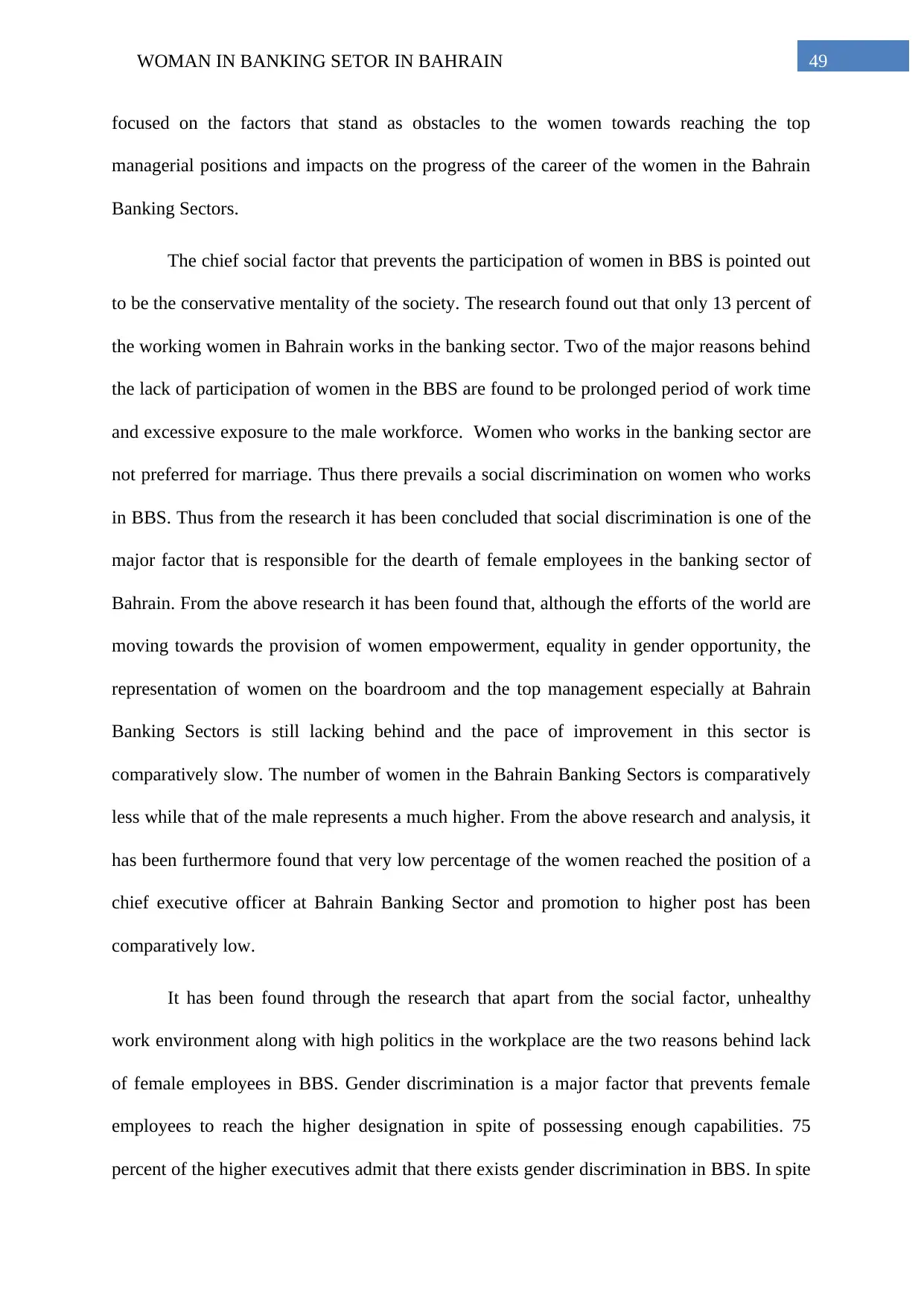
49WOMAN IN BANKING SETOR IN BAHRAIN
focused on the factors that stand as obstacles to the women towards reaching the top
managerial positions and impacts on the progress of the career of the women in the Bahrain
Banking Sectors.
The chief social factor that prevents the participation of women in BBS is pointed out
to be the conservative mentality of the society. The research found out that only 13 percent of
the working women in Bahrain works in the banking sector. Two of the major reasons behind
the lack of participation of women in the BBS are found to be prolonged period of work time
and excessive exposure to the male workforce. Women who works in the banking sector are
not preferred for marriage. Thus there prevails a social discrimination on women who works
in BBS. Thus from the research it has been concluded that social discrimination is one of the
major factor that is responsible for the dearth of female employees in the banking sector of
Bahrain. From the above research it has been found that, although the efforts of the world are
moving towards the provision of women empowerment, equality in gender opportunity, the
representation of women on the boardroom and the top management especially at Bahrain
Banking Sectors is still lacking behind and the pace of improvement in this sector is
comparatively slow. The number of women in the Bahrain Banking Sectors is comparatively
less while that of the male represents a much higher. From the above research and analysis, it
has been furthermore found that very low percentage of the women reached the position of a
chief executive officer at Bahrain Banking Sector and promotion to higher post has been
comparatively low.
It has been found through the research that apart from the social factor, unhealthy
work environment along with high politics in the workplace are the two reasons behind lack
of female employees in BBS. Gender discrimination is a major factor that prevents female
employees to reach the higher designation in spite of possessing enough capabilities. 75
percent of the higher executives admit that there exists gender discrimination in BBS. In spite
focused on the factors that stand as obstacles to the women towards reaching the top
managerial positions and impacts on the progress of the career of the women in the Bahrain
Banking Sectors.
The chief social factor that prevents the participation of women in BBS is pointed out
to be the conservative mentality of the society. The research found out that only 13 percent of
the working women in Bahrain works in the banking sector. Two of the major reasons behind
the lack of participation of women in the BBS are found to be prolonged period of work time
and excessive exposure to the male workforce. Women who works in the banking sector are
not preferred for marriage. Thus there prevails a social discrimination on women who works
in BBS. Thus from the research it has been concluded that social discrimination is one of the
major factor that is responsible for the dearth of female employees in the banking sector of
Bahrain. From the above research it has been found that, although the efforts of the world are
moving towards the provision of women empowerment, equality in gender opportunity, the
representation of women on the boardroom and the top management especially at Bahrain
Banking Sectors is still lacking behind and the pace of improvement in this sector is
comparatively slow. The number of women in the Bahrain Banking Sectors is comparatively
less while that of the male represents a much higher. From the above research and analysis, it
has been furthermore found that very low percentage of the women reached the position of a
chief executive officer at Bahrain Banking Sector and promotion to higher post has been
comparatively low.
It has been found through the research that apart from the social factor, unhealthy
work environment along with high politics in the workplace are the two reasons behind lack
of female employees in BBS. Gender discrimination is a major factor that prevents female
employees to reach the higher designation in spite of possessing enough capabilities. 75
percent of the higher executives admit that there exists gender discrimination in BBS. In spite
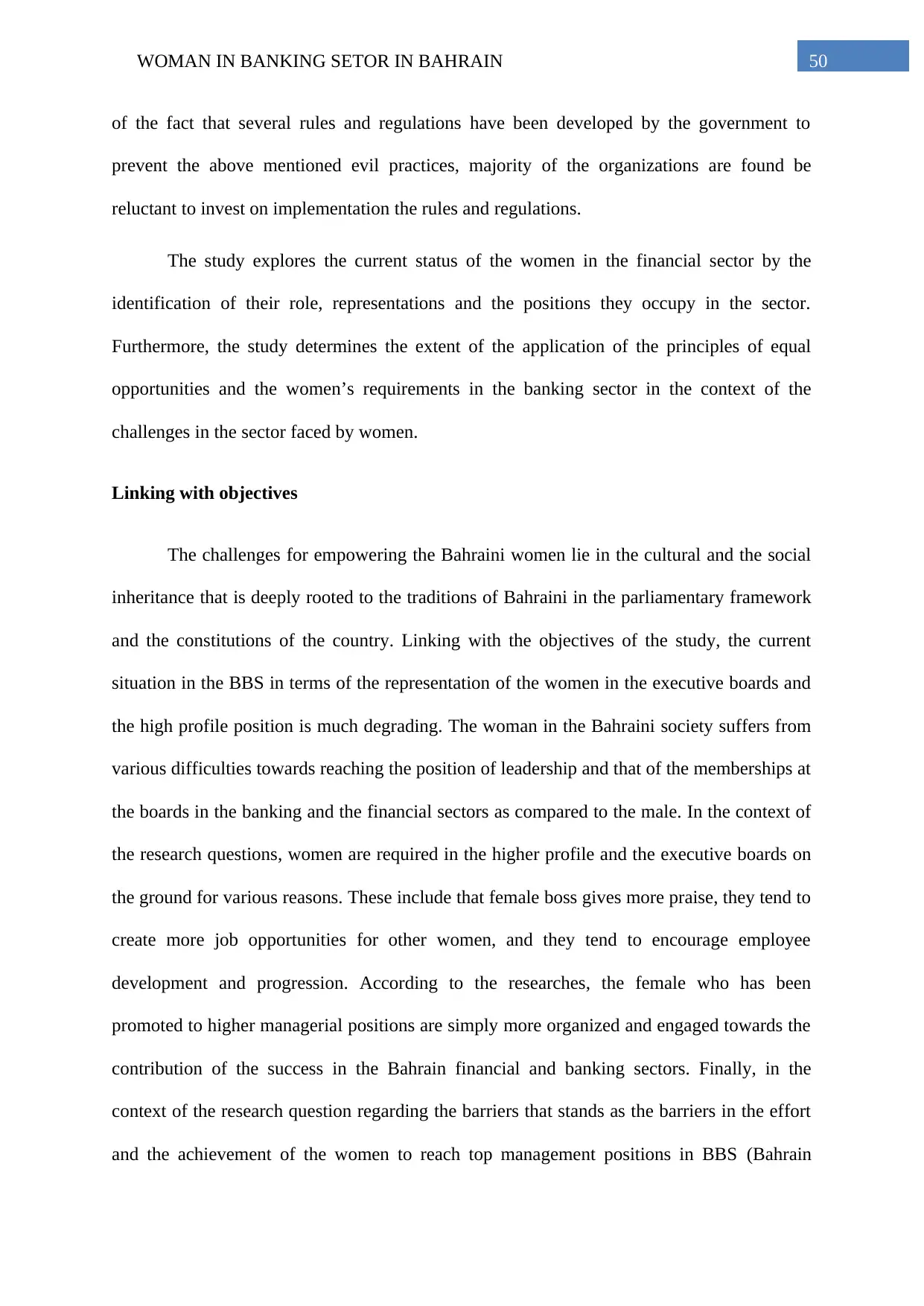
50WOMAN IN BANKING SETOR IN BAHRAIN
of the fact that several rules and regulations have been developed by the government to
prevent the above mentioned evil practices, majority of the organizations are found be
reluctant to invest on implementation the rules and regulations.
The study explores the current status of the women in the financial sector by the
identification of their role, representations and the positions they occupy in the sector.
Furthermore, the study determines the extent of the application of the principles of equal
opportunities and the women’s requirements in the banking sector in the context of the
challenges in the sector faced by women.
Linking with objectives
The challenges for empowering the Bahraini women lie in the cultural and the social
inheritance that is deeply rooted to the traditions of Bahraini in the parliamentary framework
and the constitutions of the country. Linking with the objectives of the study, the current
situation in the BBS in terms of the representation of the women in the executive boards and
the high profile position is much degrading. The woman in the Bahraini society suffers from
various difficulties towards reaching the position of leadership and that of the memberships at
the boards in the banking and the financial sectors as compared to the male. In the context of
the research questions, women are required in the higher profile and the executive boards on
the ground for various reasons. These include that female boss gives more praise, they tend to
create more job opportunities for other women, and they tend to encourage employee
development and progression. According to the researches, the female who has been
promoted to higher managerial positions are simply more organized and engaged towards the
contribution of the success in the Bahrain financial and banking sectors. Finally, in the
context of the research question regarding the barriers that stands as the barriers in the effort
and the achievement of the women to reach top management positions in BBS (Bahrain
of the fact that several rules and regulations have been developed by the government to
prevent the above mentioned evil practices, majority of the organizations are found be
reluctant to invest on implementation the rules and regulations.
The study explores the current status of the women in the financial sector by the
identification of their role, representations and the positions they occupy in the sector.
Furthermore, the study determines the extent of the application of the principles of equal
opportunities and the women’s requirements in the banking sector in the context of the
challenges in the sector faced by women.
Linking with objectives
The challenges for empowering the Bahraini women lie in the cultural and the social
inheritance that is deeply rooted to the traditions of Bahraini in the parliamentary framework
and the constitutions of the country. Linking with the objectives of the study, the current
situation in the BBS in terms of the representation of the women in the executive boards and
the high profile position is much degrading. The woman in the Bahraini society suffers from
various difficulties towards reaching the position of leadership and that of the memberships at
the boards in the banking and the financial sectors as compared to the male. In the context of
the research questions, women are required in the higher profile and the executive boards on
the ground for various reasons. These include that female boss gives more praise, they tend to
create more job opportunities for other women, and they tend to encourage employee
development and progression. According to the researches, the female who has been
promoted to higher managerial positions are simply more organized and engaged towards the
contribution of the success in the Bahrain financial and banking sectors. Finally, in the
context of the research question regarding the barriers that stands as the barriers in the effort
and the achievement of the women to reach top management positions in BBS (Bahrain
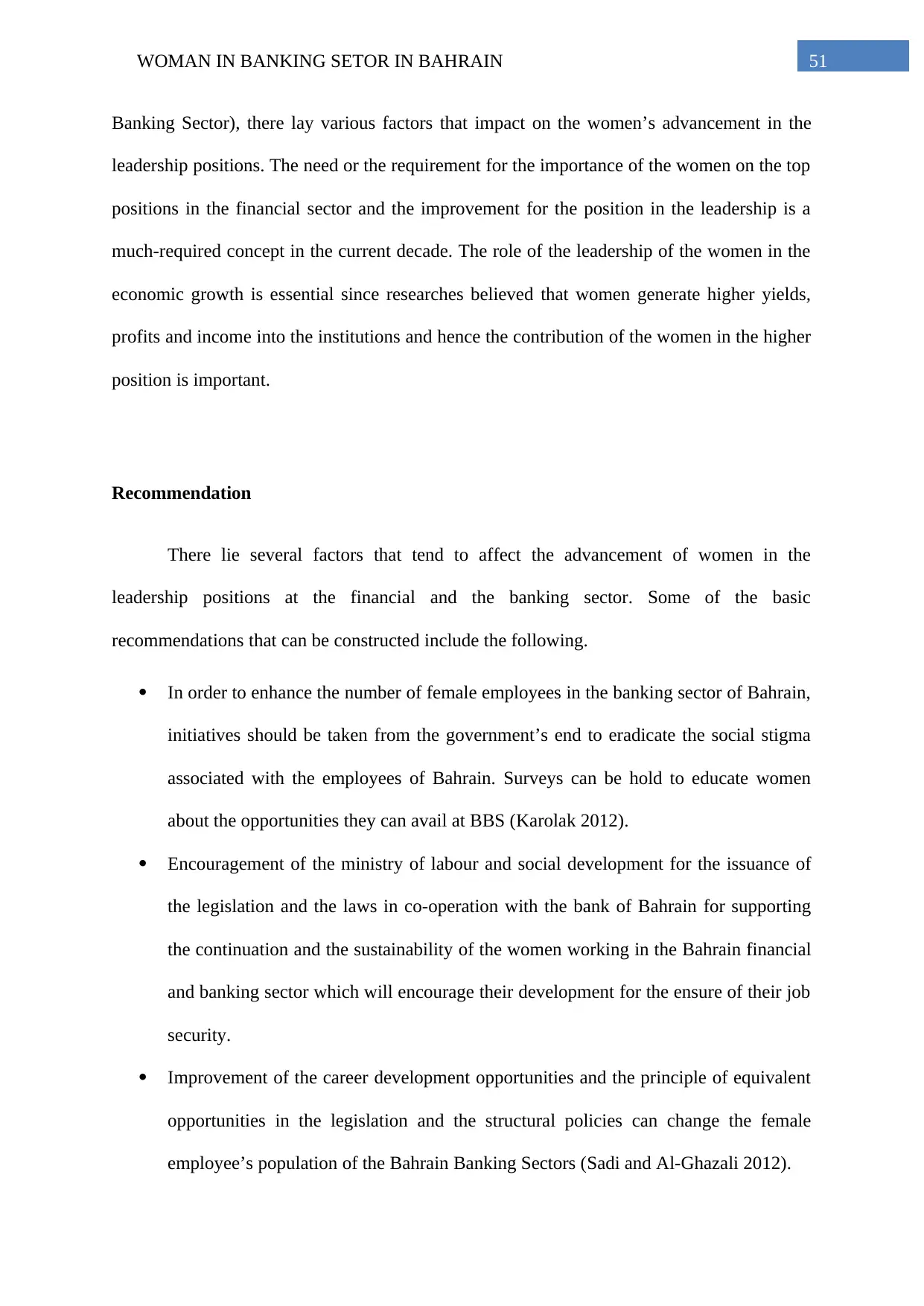
51WOMAN IN BANKING SETOR IN BAHRAIN
Banking Sector), there lay various factors that impact on the women’s advancement in the
leadership positions. The need or the requirement for the importance of the women on the top
positions in the financial sector and the improvement for the position in the leadership is a
much-required concept in the current decade. The role of the leadership of the women in the
economic growth is essential since researches believed that women generate higher yields,
profits and income into the institutions and hence the contribution of the women in the higher
position is important.
Recommendation
There lie several factors that tend to affect the advancement of women in the
leadership positions at the financial and the banking sector. Some of the basic
recommendations that can be constructed include the following.
In order to enhance the number of female employees in the banking sector of Bahrain,
initiatives should be taken from the government’s end to eradicate the social stigma
associated with the employees of Bahrain. Surveys can be hold to educate women
about the opportunities they can avail at BBS (Karolak 2012).
Encouragement of the ministry of labour and social development for the issuance of
the legislation and the laws in co-operation with the bank of Bahrain for supporting
the continuation and the sustainability of the women working in the Bahrain financial
and banking sector which will encourage their development for the ensure of their job
security.
Improvement of the career development opportunities and the principle of equivalent
opportunities in the legislation and the structural policies can change the female
employee’s population of the Bahrain Banking Sectors (Sadi and Al-Ghazali 2012).
Banking Sector), there lay various factors that impact on the women’s advancement in the
leadership positions. The need or the requirement for the importance of the women on the top
positions in the financial sector and the improvement for the position in the leadership is a
much-required concept in the current decade. The role of the leadership of the women in the
economic growth is essential since researches believed that women generate higher yields,
profits and income into the institutions and hence the contribution of the women in the higher
position is important.
Recommendation
There lie several factors that tend to affect the advancement of women in the
leadership positions at the financial and the banking sector. Some of the basic
recommendations that can be constructed include the following.
In order to enhance the number of female employees in the banking sector of Bahrain,
initiatives should be taken from the government’s end to eradicate the social stigma
associated with the employees of Bahrain. Surveys can be hold to educate women
about the opportunities they can avail at BBS (Karolak 2012).
Encouragement of the ministry of labour and social development for the issuance of
the legislation and the laws in co-operation with the bank of Bahrain for supporting
the continuation and the sustainability of the women working in the Bahrain financial
and banking sector which will encourage their development for the ensure of their job
security.
Improvement of the career development opportunities and the principle of equivalent
opportunities in the legislation and the structural policies can change the female
employee’s population of the Bahrain Banking Sectors (Sadi and Al-Ghazali 2012).
Secure Best Marks with AI Grader
Need help grading? Try our AI Grader for instant feedback on your assignments.
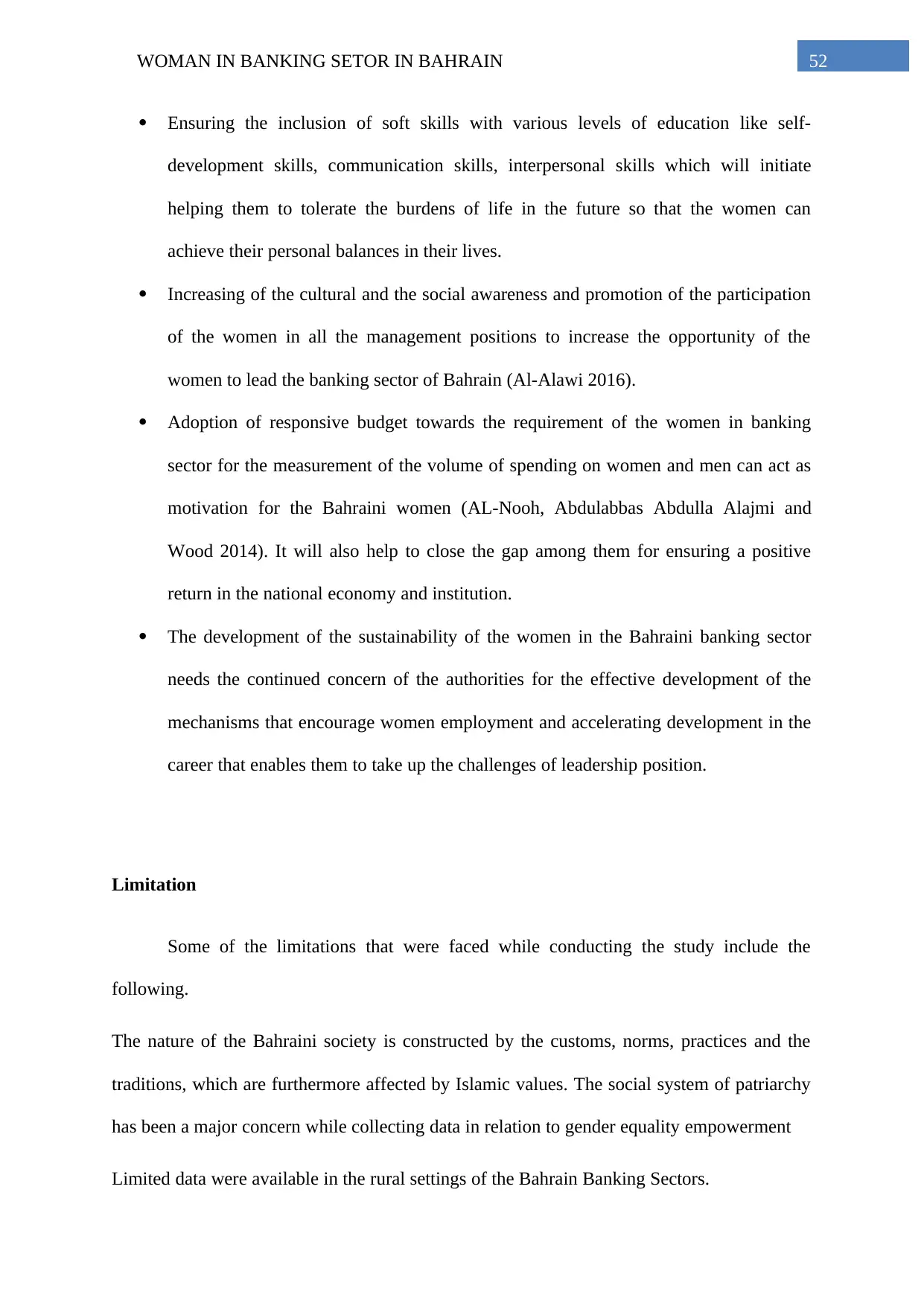
52WOMAN IN BANKING SETOR IN BAHRAIN
Ensuring the inclusion of soft skills with various levels of education like self-
development skills, communication skills, interpersonal skills which will initiate
helping them to tolerate the burdens of life in the future so that the women can
achieve their personal balances in their lives.
Increasing of the cultural and the social awareness and promotion of the participation
of the women in all the management positions to increase the opportunity of the
women to lead the banking sector of Bahrain (Al-Alawi 2016).
Adoption of responsive budget towards the requirement of the women in banking
sector for the measurement of the volume of spending on women and men can act as
motivation for the Bahraini women (AL-Nooh, Abdulabbas Abdulla Alajmi and
Wood 2014). It will also help to close the gap among them for ensuring a positive
return in the national economy and institution.
The development of the sustainability of the women in the Bahraini banking sector
needs the continued concern of the authorities for the effective development of the
mechanisms that encourage women employment and accelerating development in the
career that enables them to take up the challenges of leadership position.
Limitation
Some of the limitations that were faced while conducting the study include the
following.
The nature of the Bahraini society is constructed by the customs, norms, practices and the
traditions, which are furthermore affected by Islamic values. The social system of patriarchy
has been a major concern while collecting data in relation to gender equality empowerment
Limited data were available in the rural settings of the Bahrain Banking Sectors.
Ensuring the inclusion of soft skills with various levels of education like self-
development skills, communication skills, interpersonal skills which will initiate
helping them to tolerate the burdens of life in the future so that the women can
achieve their personal balances in their lives.
Increasing of the cultural and the social awareness and promotion of the participation
of the women in all the management positions to increase the opportunity of the
women to lead the banking sector of Bahrain (Al-Alawi 2016).
Adoption of responsive budget towards the requirement of the women in banking
sector for the measurement of the volume of spending on women and men can act as
motivation for the Bahraini women (AL-Nooh, Abdulabbas Abdulla Alajmi and
Wood 2014). It will also help to close the gap among them for ensuring a positive
return in the national economy and institution.
The development of the sustainability of the women in the Bahraini banking sector
needs the continued concern of the authorities for the effective development of the
mechanisms that encourage women employment and accelerating development in the
career that enables them to take up the challenges of leadership position.
Limitation
Some of the limitations that were faced while conducting the study include the
following.
The nature of the Bahraini society is constructed by the customs, norms, practices and the
traditions, which are furthermore affected by Islamic values. The social system of patriarchy
has been a major concern while collecting data in relation to gender equality empowerment
Limited data were available in the rural settings of the Bahrain Banking Sectors.
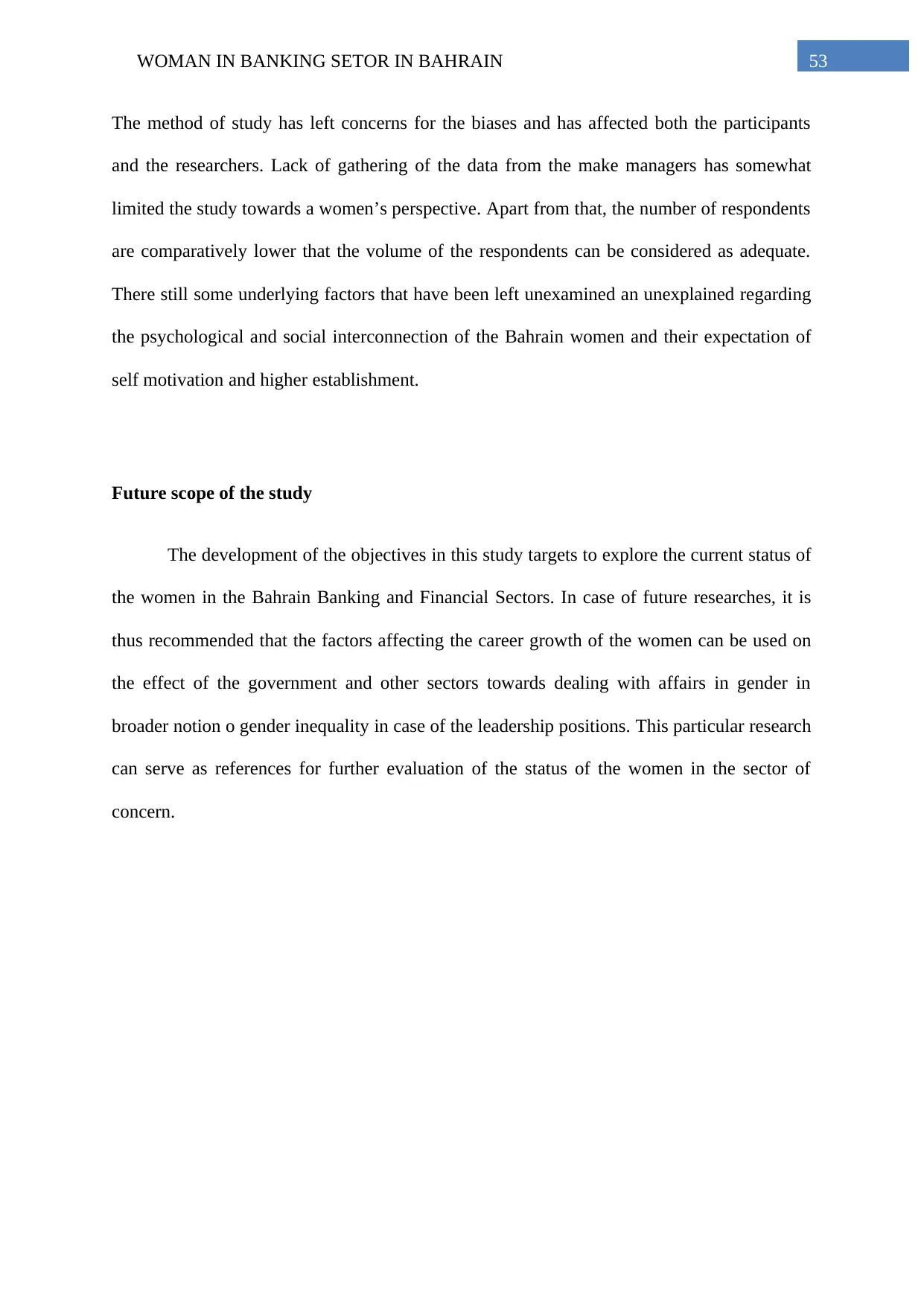
53WOMAN IN BANKING SETOR IN BAHRAIN
The method of study has left concerns for the biases and has affected both the participants
and the researchers. Lack of gathering of the data from the make managers has somewhat
limited the study towards a women’s perspective. Apart from that, the number of respondents
are comparatively lower that the volume of the respondents can be considered as adequate.
There still some underlying factors that have been left unexamined an unexplained regarding
the psychological and social interconnection of the Bahrain women and their expectation of
self motivation and higher establishment.
Future scope of the study
The development of the objectives in this study targets to explore the current status of
the women in the Bahrain Banking and Financial Sectors. In case of future researches, it is
thus recommended that the factors affecting the career growth of the women can be used on
the effect of the government and other sectors towards dealing with affairs in gender in
broader notion o gender inequality in case of the leadership positions. This particular research
can serve as references for further evaluation of the status of the women in the sector of
concern.
The method of study has left concerns for the biases and has affected both the participants
and the researchers. Lack of gathering of the data from the make managers has somewhat
limited the study towards a women’s perspective. Apart from that, the number of respondents
are comparatively lower that the volume of the respondents can be considered as adequate.
There still some underlying factors that have been left unexamined an unexplained regarding
the psychological and social interconnection of the Bahrain women and their expectation of
self motivation and higher establishment.
Future scope of the study
The development of the objectives in this study targets to explore the current status of
the women in the Bahrain Banking and Financial Sectors. In case of future researches, it is
thus recommended that the factors affecting the career growth of the women can be used on
the effect of the government and other sectors towards dealing with affairs in gender in
broader notion o gender inequality in case of the leadership positions. This particular research
can serve as references for further evaluation of the status of the women in the sector of
concern.
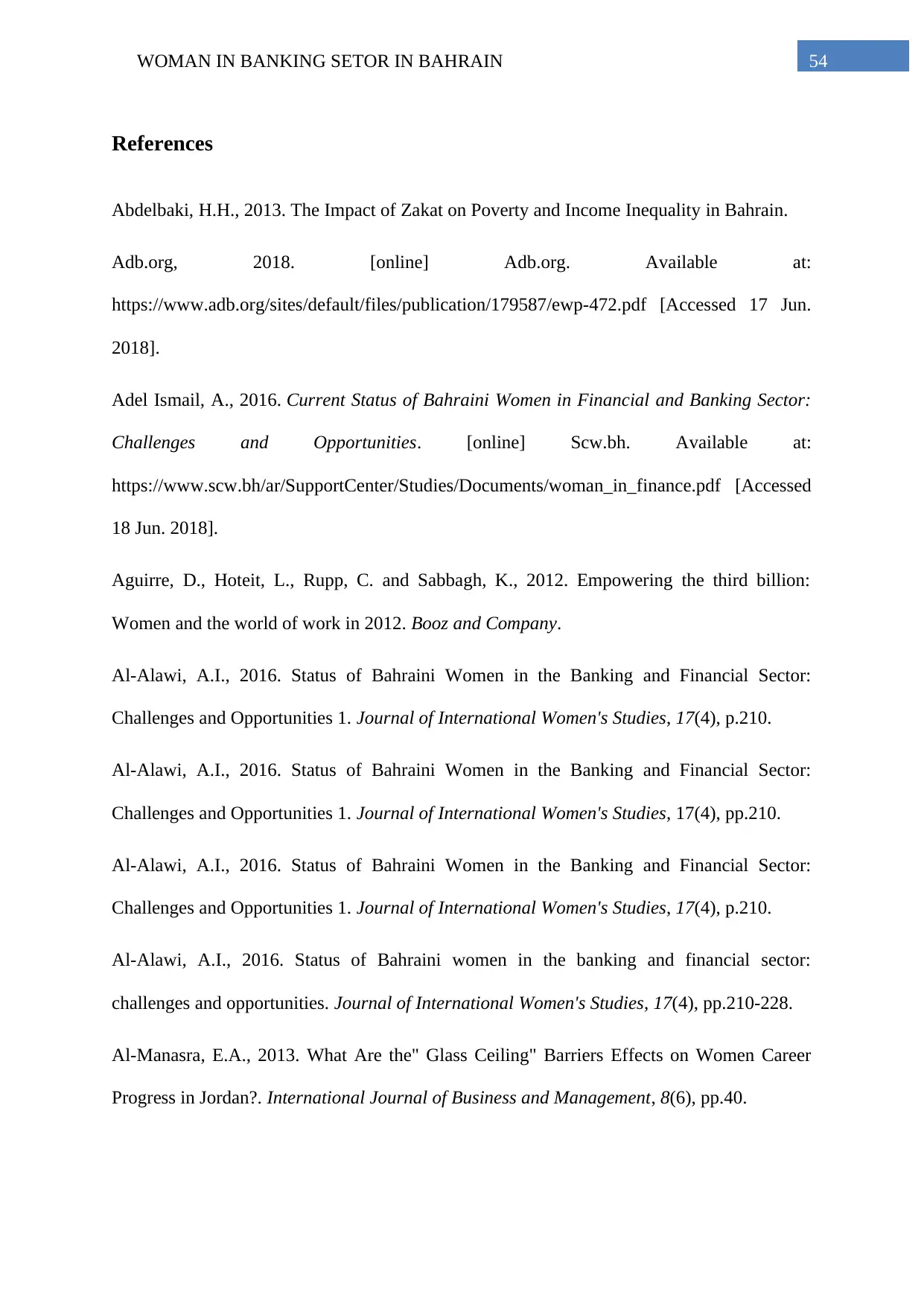
54WOMAN IN BANKING SETOR IN BAHRAIN
References
Abdelbaki, H.H., 2013. The Impact of Zakat on Poverty and Income Inequality in Bahrain.
Adb.org, 2018. [online] Adb.org. Available at:
https://www.adb.org/sites/default/files/publication/179587/ewp-472.pdf [Accessed 17 Jun.
2018].
Adel Ismail, A., 2016. Current Status of Bahraini Women in Financial and Banking Sector:
Challenges and Opportunities. [online] Scw.bh. Available at:
https://www.scw.bh/ar/SupportCenter/Studies/Documents/woman_in_finance.pdf [Accessed
18 Jun. 2018].
Aguirre, D., Hoteit, L., Rupp, C. and Sabbagh, K., 2012. Empowering the third billion:
Women and the world of work in 2012. Booz and Company.
Al-Alawi, A.I., 2016. Status of Bahraini Women in the Banking and Financial Sector:
Challenges and Opportunities 1. Journal of International Women's Studies, 17(4), p.210.
Al-Alawi, A.I., 2016. Status of Bahraini Women in the Banking and Financial Sector:
Challenges and Opportunities 1. Journal of International Women's Studies, 17(4), pp.210.
Al-Alawi, A.I., 2016. Status of Bahraini Women in the Banking and Financial Sector:
Challenges and Opportunities 1. Journal of International Women's Studies, 17(4), p.210.
Al-Alawi, A.I., 2016. Status of Bahraini women in the banking and financial sector:
challenges and opportunities. Journal of International Women's Studies, 17(4), pp.210-228.
Al-Manasra, E.A., 2013. What Are the" Glass Ceiling" Barriers Effects on Women Career
Progress in Jordan?. International Journal of Business and Management, 8(6), pp.40.
References
Abdelbaki, H.H., 2013. The Impact of Zakat on Poverty and Income Inequality in Bahrain.
Adb.org, 2018. [online] Adb.org. Available at:
https://www.adb.org/sites/default/files/publication/179587/ewp-472.pdf [Accessed 17 Jun.
2018].
Adel Ismail, A., 2016. Current Status of Bahraini Women in Financial and Banking Sector:
Challenges and Opportunities. [online] Scw.bh. Available at:
https://www.scw.bh/ar/SupportCenter/Studies/Documents/woman_in_finance.pdf [Accessed
18 Jun. 2018].
Aguirre, D., Hoteit, L., Rupp, C. and Sabbagh, K., 2012. Empowering the third billion:
Women and the world of work in 2012. Booz and Company.
Al-Alawi, A.I., 2016. Status of Bahraini Women in the Banking and Financial Sector:
Challenges and Opportunities 1. Journal of International Women's Studies, 17(4), p.210.
Al-Alawi, A.I., 2016. Status of Bahraini Women in the Banking and Financial Sector:
Challenges and Opportunities 1. Journal of International Women's Studies, 17(4), pp.210.
Al-Alawi, A.I., 2016. Status of Bahraini Women in the Banking and Financial Sector:
Challenges and Opportunities 1. Journal of International Women's Studies, 17(4), p.210.
Al-Alawi, A.I., 2016. Status of Bahraini women in the banking and financial sector:
challenges and opportunities. Journal of International Women's Studies, 17(4), pp.210-228.
Al-Manasra, E.A., 2013. What Are the" Glass Ceiling" Barriers Effects on Women Career
Progress in Jordan?. International Journal of Business and Management, 8(6), pp.40.
Paraphrase This Document
Need a fresh take? Get an instant paraphrase of this document with our AI Paraphraser
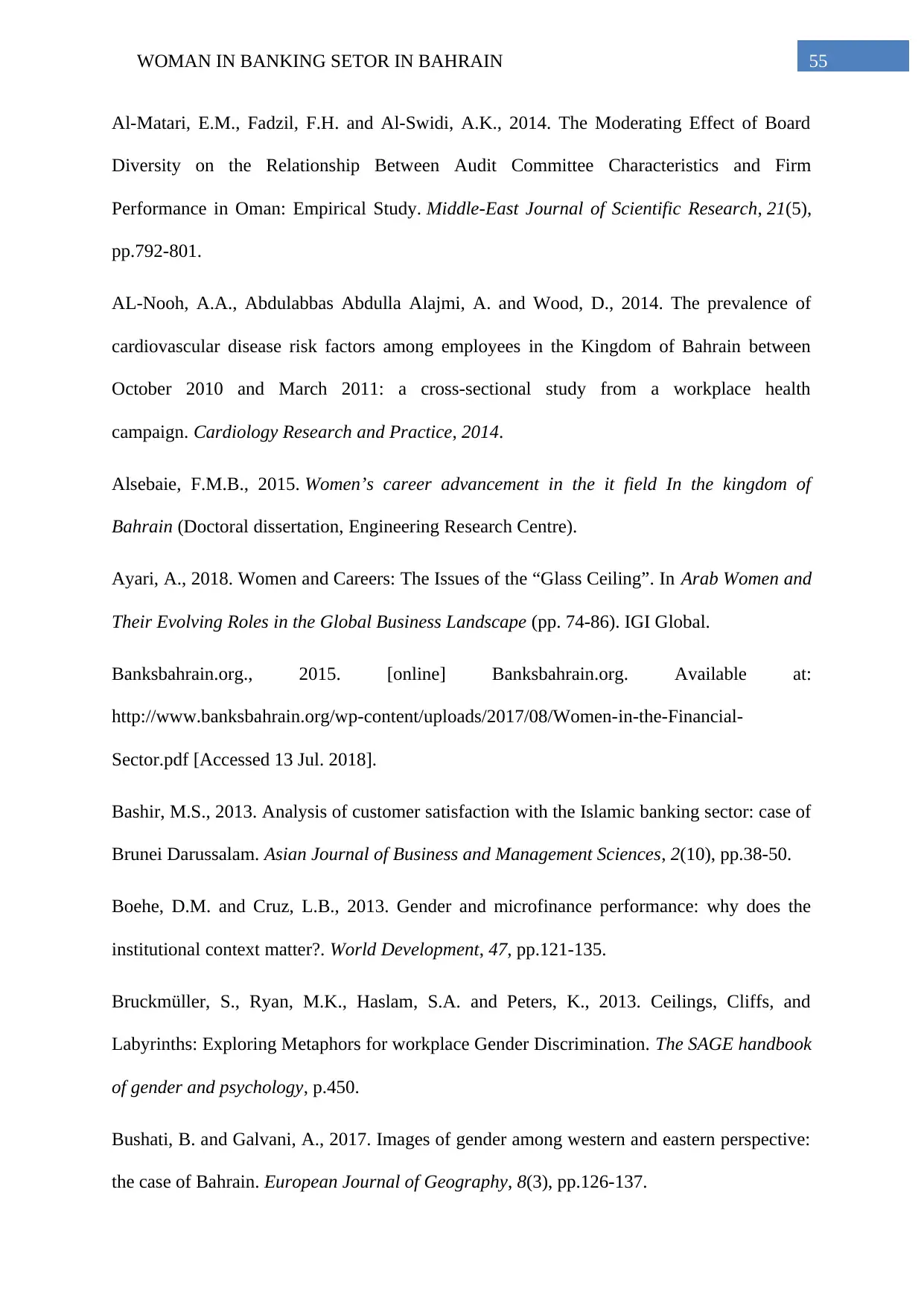
55WOMAN IN BANKING SETOR IN BAHRAIN
Al-Matari, E.M., Fadzil, F.H. and Al-Swidi, A.K., 2014. The Moderating Effect of Board
Diversity on the Relationship Between Audit Committee Characteristics and Firm
Performance in Oman: Empirical Study. Middle-East Journal of Scientific Research, 21(5),
pp.792-801.
AL-Nooh, A.A., Abdulabbas Abdulla Alajmi, A. and Wood, D., 2014. The prevalence of
cardiovascular disease risk factors among employees in the Kingdom of Bahrain between
October 2010 and March 2011: a cross-sectional study from a workplace health
campaign. Cardiology Research and Practice, 2014.
Alsebaie, F.M.B., 2015. Women’s career advancement in the it field In the kingdom of
Bahrain (Doctoral dissertation, Engineering Research Centre).
Ayari, A., 2018. Women and Careers: The Issues of the “Glass Ceiling”. In Arab Women and
Their Evolving Roles in the Global Business Landscape (pp. 74-86). IGI Global.
Banksbahrain.org., 2015. [online] Banksbahrain.org. Available at:
http://www.banksbahrain.org/wp-content/uploads/2017/08/Women-in-the-Financial-
Sector.pdf [Accessed 13 Jul. 2018].
Bashir, M.S., 2013. Analysis of customer satisfaction with the Islamic banking sector: case of
Brunei Darussalam. Asian Journal of Business and Management Sciences, 2(10), pp.38-50.
Boehe, D.M. and Cruz, L.B., 2013. Gender and microfinance performance: why does the
institutional context matter?. World Development, 47, pp.121-135.
Bruckmüller, S., Ryan, M.K., Haslam, S.A. and Peters, K., 2013. Ceilings, Cliffs, and
Labyrinths: Exploring Metaphors for workplace Gender Discrimination. The SAGE handbook
of gender and psychology, p.450.
Bushati, B. and Galvani, A., 2017. Images of gender among western and eastern perspective:
the case of Bahrain. European Journal of Geography, 8(3), pp.126-137.
Al-Matari, E.M., Fadzil, F.H. and Al-Swidi, A.K., 2014. The Moderating Effect of Board
Diversity on the Relationship Between Audit Committee Characteristics and Firm
Performance in Oman: Empirical Study. Middle-East Journal of Scientific Research, 21(5),
pp.792-801.
AL-Nooh, A.A., Abdulabbas Abdulla Alajmi, A. and Wood, D., 2014. The prevalence of
cardiovascular disease risk factors among employees in the Kingdom of Bahrain between
October 2010 and March 2011: a cross-sectional study from a workplace health
campaign. Cardiology Research and Practice, 2014.
Alsebaie, F.M.B., 2015. Women’s career advancement in the it field In the kingdom of
Bahrain (Doctoral dissertation, Engineering Research Centre).
Ayari, A., 2018. Women and Careers: The Issues of the “Glass Ceiling”. In Arab Women and
Their Evolving Roles in the Global Business Landscape (pp. 74-86). IGI Global.
Banksbahrain.org., 2015. [online] Banksbahrain.org. Available at:
http://www.banksbahrain.org/wp-content/uploads/2017/08/Women-in-the-Financial-
Sector.pdf [Accessed 13 Jul. 2018].
Bashir, M.S., 2013. Analysis of customer satisfaction with the Islamic banking sector: case of
Brunei Darussalam. Asian Journal of Business and Management Sciences, 2(10), pp.38-50.
Boehe, D.M. and Cruz, L.B., 2013. Gender and microfinance performance: why does the
institutional context matter?. World Development, 47, pp.121-135.
Bruckmüller, S., Ryan, M.K., Haslam, S.A. and Peters, K., 2013. Ceilings, Cliffs, and
Labyrinths: Exploring Metaphors for workplace Gender Discrimination. The SAGE handbook
of gender and psychology, p.450.
Bushati, B. and Galvani, A., 2017. Images of gender among western and eastern perspective:
the case of Bahrain. European Journal of Geography, 8(3), pp.126-137.
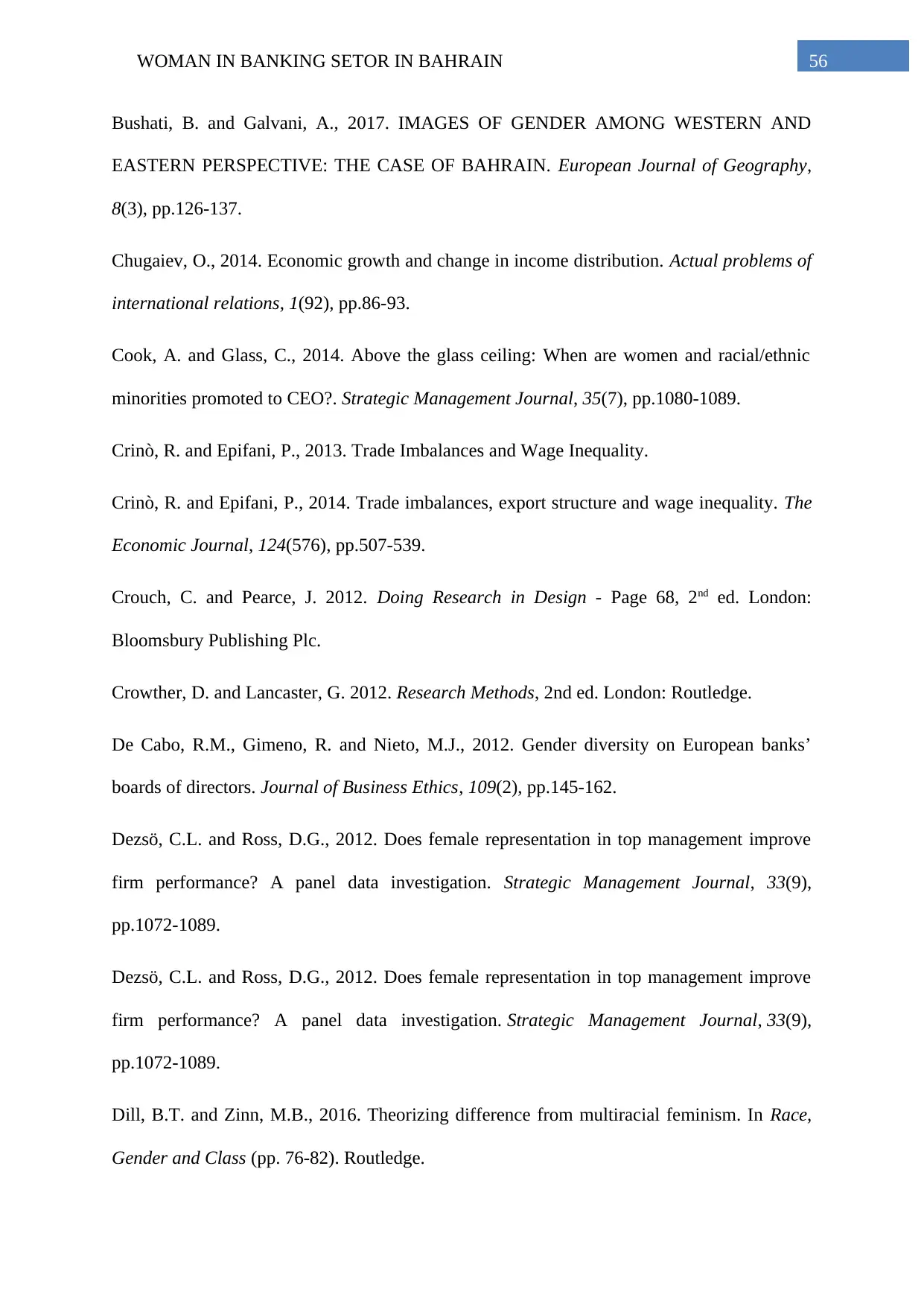
56WOMAN IN BANKING SETOR IN BAHRAIN
Bushati, B. and Galvani, A., 2017. IMAGES OF GENDER AMONG WESTERN AND
EASTERN PERSPECTIVE: THE CASE OF BAHRAIN. European Journal of Geography,
8(3), pp.126-137.
Chugaiev, О., 2014. Economic growth and change in income distribution. Actual problems of
international relations, 1(92), pp.86-93.
Cook, A. and Glass, C., 2014. Above the glass ceiling: When are women and racial/ethnic
minorities promoted to CEO?. Strategic Management Journal, 35(7), pp.1080-1089.
Crinò, R. and Epifani, P., 2013. Trade Imbalances and Wage Inequality.
Crinò, R. and Epifani, P., 2014. Trade imbalances, export structure and wage inequality. The
Economic Journal, 124(576), pp.507-539.
Crouch, C. and Pearce, J. 2012. Doing Research in Design - Page 68, 2nd ed. London:
Bloomsbury Publishing Plc.
Crowther, D. and Lancaster, G. 2012. Research Methods, 2nd ed. London: Routledge.
De Cabo, R.M., Gimeno, R. and Nieto, M.J., 2012. Gender diversity on European banks’
boards of directors. Journal of Business Ethics, 109(2), pp.145-162.
Dezsö, C.L. and Ross, D.G., 2012. Does female representation in top management improve
firm performance? A panel data investigation. Strategic Management Journal, 33(9),
pp.1072-1089.
Dezsö, C.L. and Ross, D.G., 2012. Does female representation in top management improve
firm performance? A panel data investigation. Strategic Management Journal, 33(9),
pp.1072-1089.
Dill, B.T. and Zinn, M.B., 2016. Theorizing difference from multiracial feminism. In Race,
Gender and Class (pp. 76-82). Routledge.
Bushati, B. and Galvani, A., 2017. IMAGES OF GENDER AMONG WESTERN AND
EASTERN PERSPECTIVE: THE CASE OF BAHRAIN. European Journal of Geography,
8(3), pp.126-137.
Chugaiev, О., 2014. Economic growth and change in income distribution. Actual problems of
international relations, 1(92), pp.86-93.
Cook, A. and Glass, C., 2014. Above the glass ceiling: When are women and racial/ethnic
minorities promoted to CEO?. Strategic Management Journal, 35(7), pp.1080-1089.
Crinò, R. and Epifani, P., 2013. Trade Imbalances and Wage Inequality.
Crinò, R. and Epifani, P., 2014. Trade imbalances, export structure and wage inequality. The
Economic Journal, 124(576), pp.507-539.
Crouch, C. and Pearce, J. 2012. Doing Research in Design - Page 68, 2nd ed. London:
Bloomsbury Publishing Plc.
Crowther, D. and Lancaster, G. 2012. Research Methods, 2nd ed. London: Routledge.
De Cabo, R.M., Gimeno, R. and Nieto, M.J., 2012. Gender diversity on European banks’
boards of directors. Journal of Business Ethics, 109(2), pp.145-162.
Dezsö, C.L. and Ross, D.G., 2012. Does female representation in top management improve
firm performance? A panel data investigation. Strategic Management Journal, 33(9),
pp.1072-1089.
Dezsö, C.L. and Ross, D.G., 2012. Does female representation in top management improve
firm performance? A panel data investigation. Strategic Management Journal, 33(9),
pp.1072-1089.
Dill, B.T. and Zinn, M.B., 2016. Theorizing difference from multiracial feminism. In Race,
Gender and Class (pp. 76-82). Routledge.

57WOMAN IN BANKING SETOR IN BAHRAIN
Duflo, E., 2012. Women empowerment and economic development. Journal of Economic
Literature, 50(4), pp.1051-79.
Ellis, T. and Levy, Y. 2012. ‘Towards a guide for novice researchers on research
methodology: Review and proposed methods’, Issues in Informing Science and Information
Technology, 6, 323-337.
Elstad, B. and Ladegard, G., 2012. Women on corporate boards: key influencers or tokens?.
Journal of Management & Governance, 16(4), pp.595-615.
Eslen-Ziya, H., 2013. Social media and Turkish feminism: New resources for social
activism. Feminist Media Studies, 13(5), pp.860-870.
Findlow, S., 2013. Higher education and feminism in the Arab Gulf. British Journal of
Sociology of Education, 34(1), pp.112-131.
Freshwater, D. 2012. “Reading mixed methods research: contexts for criticism”, Journal of
Mixed Methods Research, 1(2), pp. 134-46.
Friedrich, B., 2015. Trade shocks, firm hierarchies and wage inequality. Unpublished
working paper. Yale University.
Gipson, A.N., Pfaff, D.L., Mendelsohn, D.B., Catenacci, L.T. and Burke, W.W., 2017.
Women and leadership: selection, development, leadership style, and performance. The
Journal of Applied Behavioral Science, 53(1), pp.32-65.
Glass, C. and Cook, A., 2016. Leading at the top: Understanding women's challenges above
the glass ceiling. The Leadership Quarterly, 27(1), pp.51-63.
Gummerson, E. 2012. Qualitative methods in management research, 5th ed. Thousand Oaks,
Calif.: Sage
Duflo, E., 2012. Women empowerment and economic development. Journal of Economic
Literature, 50(4), pp.1051-79.
Ellis, T. and Levy, Y. 2012. ‘Towards a guide for novice researchers on research
methodology: Review and proposed methods’, Issues in Informing Science and Information
Technology, 6, 323-337.
Elstad, B. and Ladegard, G., 2012. Women on corporate boards: key influencers or tokens?.
Journal of Management & Governance, 16(4), pp.595-615.
Eslen-Ziya, H., 2013. Social media and Turkish feminism: New resources for social
activism. Feminist Media Studies, 13(5), pp.860-870.
Findlow, S., 2013. Higher education and feminism in the Arab Gulf. British Journal of
Sociology of Education, 34(1), pp.112-131.
Freshwater, D. 2012. “Reading mixed methods research: contexts for criticism”, Journal of
Mixed Methods Research, 1(2), pp. 134-46.
Friedrich, B., 2015. Trade shocks, firm hierarchies and wage inequality. Unpublished
working paper. Yale University.
Gipson, A.N., Pfaff, D.L., Mendelsohn, D.B., Catenacci, L.T. and Burke, W.W., 2017.
Women and leadership: selection, development, leadership style, and performance. The
Journal of Applied Behavioral Science, 53(1), pp.32-65.
Glass, C. and Cook, A., 2016. Leading at the top: Understanding women's challenges above
the glass ceiling. The Leadership Quarterly, 27(1), pp.51-63.
Gummerson, E. 2012. Qualitative methods in management research, 5th ed. Thousand Oaks,
Calif.: Sage
Secure Best Marks with AI Grader
Need help grading? Try our AI Grader for instant feedback on your assignments.

58WOMAN IN BANKING SETOR IN BAHRAIN
Hennessey, S.M., MacDonald, K. and Carroll, W., 2014. Is There a" Glass Cliff or a Solid
Ledge for Female Appointees to the Board of Directors?. Journal of Organizational Culture,
Communications and Conflict, 18(2), p.125.
Hunt‐Earle, K., 2012. Falling over a glass cliff: A study of the recruitment of women to
leadership roles in troubled enterprises. Global Business and Organizational Excellence,
31(5), pp.44-53.
Ilo.org. 2015. Women in Business and Management-GaininGMoMentuM. [online] Available
at: http://www.ilo.org/wcmsp5/groups/public/---dgreports/---dcomm/---publ/documents/
publication/wcms_334882.pdf [Accessed 29 Jun. 2018].
Johns, M.L., 2013. Breaking the glass ceiling: Structural, cultural, and organizational barriers
preventing women from achieving senior and executive positions. Perspectives in Health
Information Management/AHIMA, American Health Information Management Association,
10(Winter).
Karolak, M., 2012. Bahraini women in the 21st century: the Disputed legacy of the
unfinished revolution. Journal of International Women's Studies, 13(5), p.5.
Kemp, L.J., Madsen, S.R. and El-Saidi, M., 2013. The current state of female leadership in
the United Arab Emirates. Journal of Global Responsibility, 4(1), pp.99-112.
Krueger, R.A. and Casey, M.A., 2014. Focus groups: A practical guide for applied research.
Sage publications.
Lathabhavan, R. and Balasubramanian, S.A., 2017. Glass ceiling and women employees in
Asian organizations: A tri-decadal review. Asia-Pacific Journal of Business
Administration, 9(3), pp.232-246.
Lückerath-Rovers, M., 2013. Women on boards and firm performance. Journal of
Management & Governance, 17(2), pp.491-509.
Hennessey, S.M., MacDonald, K. and Carroll, W., 2014. Is There a" Glass Cliff or a Solid
Ledge for Female Appointees to the Board of Directors?. Journal of Organizational Culture,
Communications and Conflict, 18(2), p.125.
Hunt‐Earle, K., 2012. Falling over a glass cliff: A study of the recruitment of women to
leadership roles in troubled enterprises. Global Business and Organizational Excellence,
31(5), pp.44-53.
Ilo.org. 2015. Women in Business and Management-GaininGMoMentuM. [online] Available
at: http://www.ilo.org/wcmsp5/groups/public/---dgreports/---dcomm/---publ/documents/
publication/wcms_334882.pdf [Accessed 29 Jun. 2018].
Johns, M.L., 2013. Breaking the glass ceiling: Structural, cultural, and organizational barriers
preventing women from achieving senior and executive positions. Perspectives in Health
Information Management/AHIMA, American Health Information Management Association,
10(Winter).
Karolak, M., 2012. Bahraini women in the 21st century: the Disputed legacy of the
unfinished revolution. Journal of International Women's Studies, 13(5), p.5.
Kemp, L.J., Madsen, S.R. and El-Saidi, M., 2013. The current state of female leadership in
the United Arab Emirates. Journal of Global Responsibility, 4(1), pp.99-112.
Krueger, R.A. and Casey, M.A., 2014. Focus groups: A practical guide for applied research.
Sage publications.
Lathabhavan, R. and Balasubramanian, S.A., 2017. Glass ceiling and women employees in
Asian organizations: A tri-decadal review. Asia-Pacific Journal of Business
Administration, 9(3), pp.232-246.
Lückerath-Rovers, M., 2013. Women on boards and firm performance. Journal of
Management & Governance, 17(2), pp.491-509.
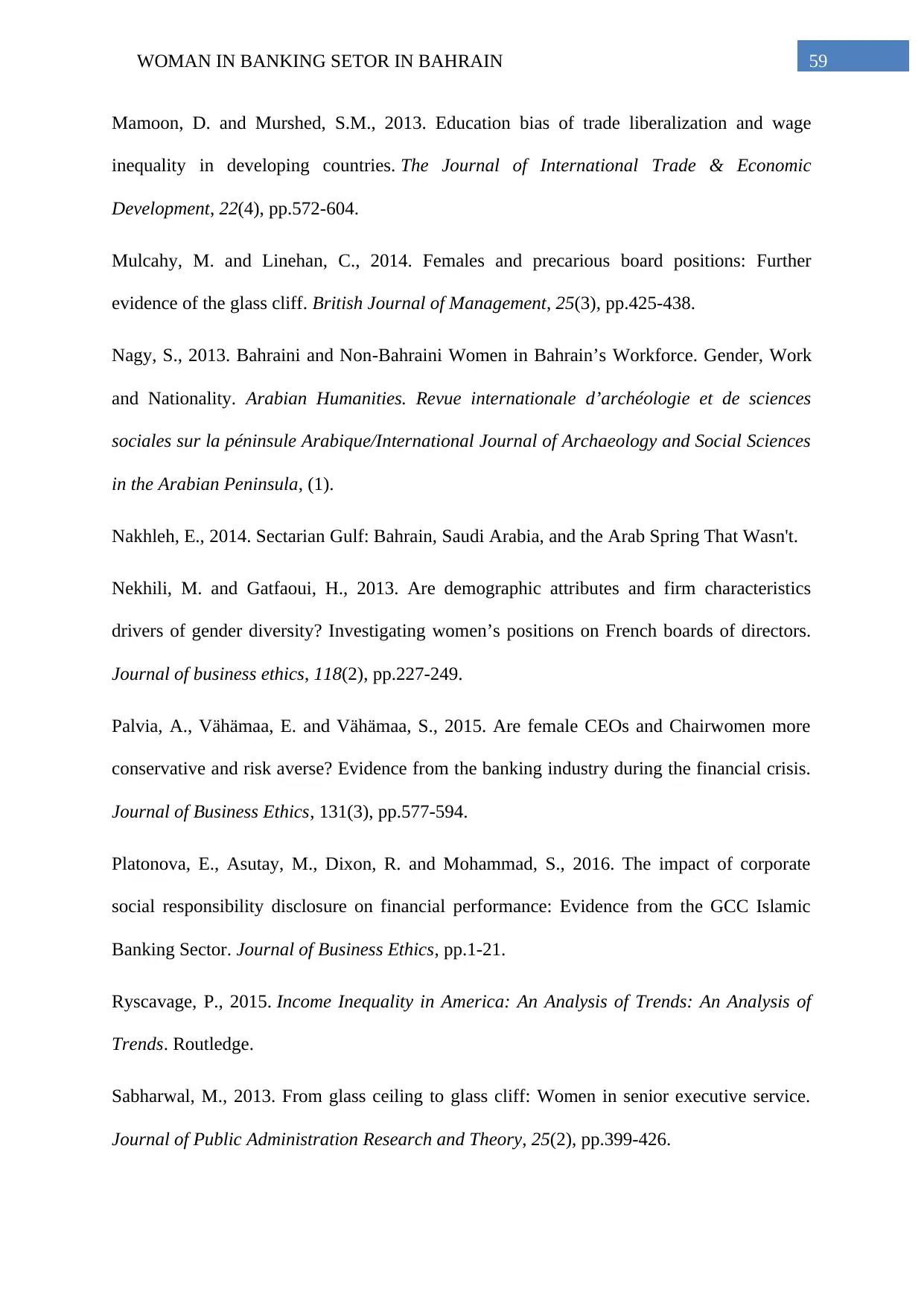
59WOMAN IN BANKING SETOR IN BAHRAIN
Mamoon, D. and Murshed, S.M., 2013. Education bias of trade liberalization and wage
inequality in developing countries. The Journal of International Trade & Economic
Development, 22(4), pp.572-604.
Mulcahy, M. and Linehan, C., 2014. Females and precarious board positions: Further
evidence of the glass cliff. British Journal of Management, 25(3), pp.425-438.
Nagy, S., 2013. Bahraini and Non-Bahraini Women in Bahrain’s Workforce. Gender, Work
and Nationality. Arabian Humanities. Revue internationale d’archéologie et de sciences
sociales sur la péninsule Arabique/International Journal of Archaeology and Social Sciences
in the Arabian Peninsula, (1).
Nakhleh, E., 2014. Sectarian Gulf: Bahrain, Saudi Arabia, and the Arab Spring That Wasn't.
Nekhili, M. and Gatfaoui, H., 2013. Are demographic attributes and firm characteristics
drivers of gender diversity? Investigating women’s positions on French boards of directors.
Journal of business ethics, 118(2), pp.227-249.
Palvia, A., Vähämaa, E. and Vähämaa, S., 2015. Are female CEOs and Chairwomen more
conservative and risk averse? Evidence from the banking industry during the financial crisis.
Journal of Business Ethics, 131(3), pp.577-594.
Platonova, E., Asutay, M., Dixon, R. and Mohammad, S., 2016. The impact of corporate
social responsibility disclosure on financial performance: Evidence from the GCC Islamic
Banking Sector. Journal of Business Ethics, pp.1-21.
Ryscavage, P., 2015. Income Inequality in America: An Analysis of Trends: An Analysis of
Trends. Routledge.
Sabharwal, M., 2013. From glass ceiling to glass cliff: Women in senior executive service.
Journal of Public Administration Research and Theory, 25(2), pp.399-426.
Mamoon, D. and Murshed, S.M., 2013. Education bias of trade liberalization and wage
inequality in developing countries. The Journal of International Trade & Economic
Development, 22(4), pp.572-604.
Mulcahy, M. and Linehan, C., 2014. Females and precarious board positions: Further
evidence of the glass cliff. British Journal of Management, 25(3), pp.425-438.
Nagy, S., 2013. Bahraini and Non-Bahraini Women in Bahrain’s Workforce. Gender, Work
and Nationality. Arabian Humanities. Revue internationale d’archéologie et de sciences
sociales sur la péninsule Arabique/International Journal of Archaeology and Social Sciences
in the Arabian Peninsula, (1).
Nakhleh, E., 2014. Sectarian Gulf: Bahrain, Saudi Arabia, and the Arab Spring That Wasn't.
Nekhili, M. and Gatfaoui, H., 2013. Are demographic attributes and firm characteristics
drivers of gender diversity? Investigating women’s positions on French boards of directors.
Journal of business ethics, 118(2), pp.227-249.
Palvia, A., Vähämaa, E. and Vähämaa, S., 2015. Are female CEOs and Chairwomen more
conservative and risk averse? Evidence from the banking industry during the financial crisis.
Journal of Business Ethics, 131(3), pp.577-594.
Platonova, E., Asutay, M., Dixon, R. and Mohammad, S., 2016. The impact of corporate
social responsibility disclosure on financial performance: Evidence from the GCC Islamic
Banking Sector. Journal of Business Ethics, pp.1-21.
Ryscavage, P., 2015. Income Inequality in America: An Analysis of Trends: An Analysis of
Trends. Routledge.
Sabharwal, M., 2013. From glass ceiling to glass cliff: Women in senior executive service.
Journal of Public Administration Research and Theory, 25(2), pp.399-426.
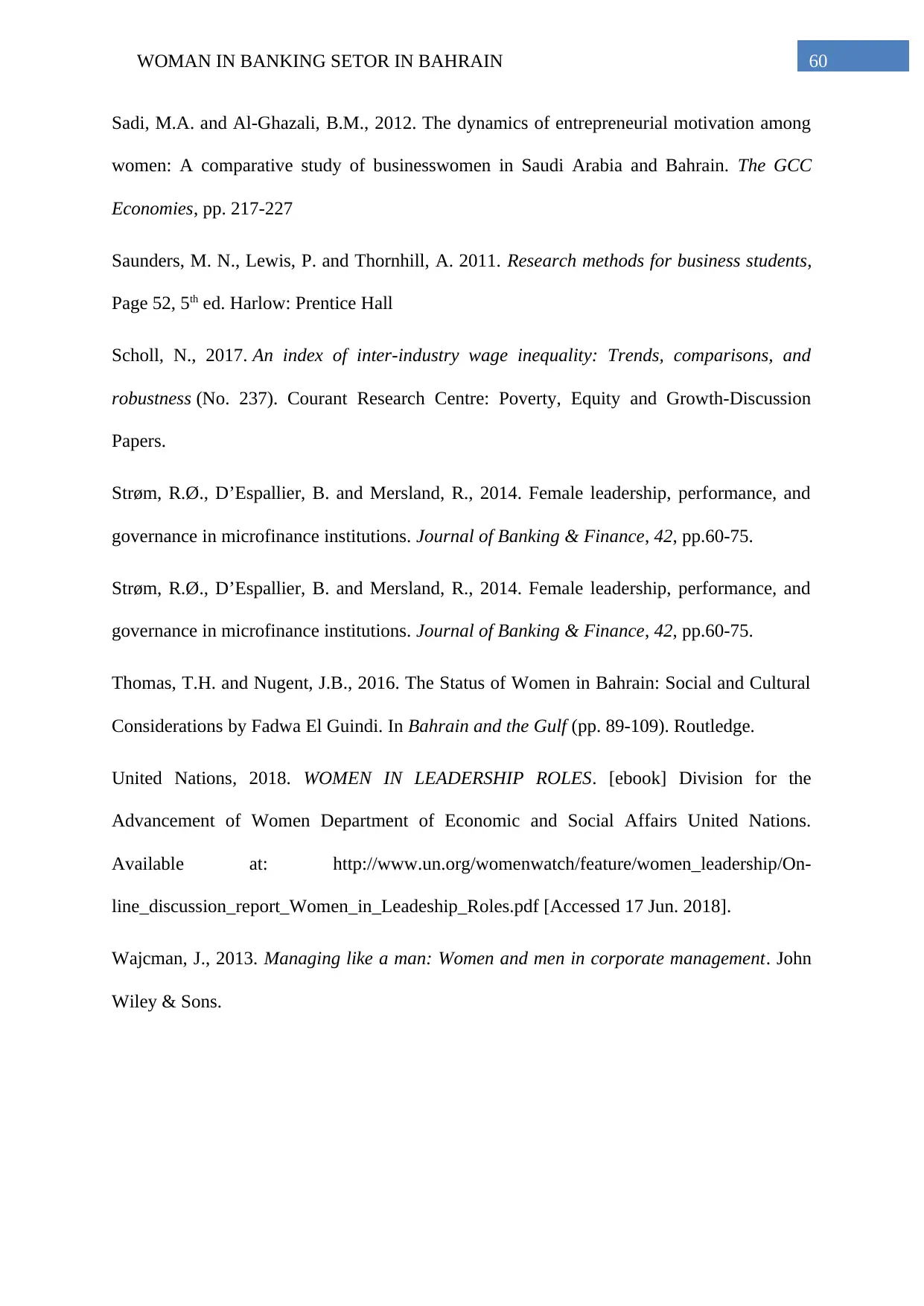
60WOMAN IN BANKING SETOR IN BAHRAIN
Sadi, M.A. and Al-Ghazali, B.M., 2012. The dynamics of entrepreneurial motivation among
women: A comparative study of businesswomen in Saudi Arabia and Bahrain. The GCC
Economies, pp. 217-227
Saunders, M. N., Lewis, P. and Thornhill, A. 2011. Research methods for business students,
Page 52, 5th ed. Harlow: Prentice Hall
Scholl, N., 2017. An index of inter-industry wage inequality: Trends, comparisons, and
robustness (No. 237). Courant Research Centre: Poverty, Equity and Growth-Discussion
Papers.
Strøm, R.Ø., D’Espallier, B. and Mersland, R., 2014. Female leadership, performance, and
governance in microfinance institutions. Journal of Banking & Finance, 42, pp.60-75.
Strøm, R.Ø., D’Espallier, B. and Mersland, R., 2014. Female leadership, performance, and
governance in microfinance institutions. Journal of Banking & Finance, 42, pp.60-75.
Thomas, T.H. and Nugent, J.B., 2016. The Status of Women in Bahrain: Social and Cultural
Considerations by Fadwa El Guindi. In Bahrain and the Gulf (pp. 89-109). Routledge.
United Nations, 2018. WOMEN IN LEADERSHIP ROLES. [ebook] Division for the
Advancement of Women Department of Economic and Social Affairs United Nations.
Available at: http://www.un.org/womenwatch/feature/women_leadership/On-
line_discussion_report_Women_in_Leadeship_Roles.pdf [Accessed 17 Jun. 2018].
Wajcman, J., 2013. Managing like a man: Women and men in corporate management. John
Wiley & Sons.
Sadi, M.A. and Al-Ghazali, B.M., 2012. The dynamics of entrepreneurial motivation among
women: A comparative study of businesswomen in Saudi Arabia and Bahrain. The GCC
Economies, pp. 217-227
Saunders, M. N., Lewis, P. and Thornhill, A. 2011. Research methods for business students,
Page 52, 5th ed. Harlow: Prentice Hall
Scholl, N., 2017. An index of inter-industry wage inequality: Trends, comparisons, and
robustness (No. 237). Courant Research Centre: Poverty, Equity and Growth-Discussion
Papers.
Strøm, R.Ø., D’Espallier, B. and Mersland, R., 2014. Female leadership, performance, and
governance in microfinance institutions. Journal of Banking & Finance, 42, pp.60-75.
Strøm, R.Ø., D’Espallier, B. and Mersland, R., 2014. Female leadership, performance, and
governance in microfinance institutions. Journal of Banking & Finance, 42, pp.60-75.
Thomas, T.H. and Nugent, J.B., 2016. The Status of Women in Bahrain: Social and Cultural
Considerations by Fadwa El Guindi. In Bahrain and the Gulf (pp. 89-109). Routledge.
United Nations, 2018. WOMEN IN LEADERSHIP ROLES. [ebook] Division for the
Advancement of Women Department of Economic and Social Affairs United Nations.
Available at: http://www.un.org/womenwatch/feature/women_leadership/On-
line_discussion_report_Women_in_Leadeship_Roles.pdf [Accessed 17 Jun. 2018].
Wajcman, J., 2013. Managing like a man: Women and men in corporate management. John
Wiley & Sons.
Paraphrase This Document
Need a fresh take? Get an instant paraphrase of this document with our AI Paraphraser

61WOMAN IN BANKING SETOR IN BAHRAIN
Appendix
Appendix
1 out of 62
Related Documents
Your All-in-One AI-Powered Toolkit for Academic Success.
+13062052269
info@desklib.com
Available 24*7 on WhatsApp / Email
![[object Object]](/_next/static/media/star-bottom.7253800d.svg)
Unlock your academic potential
© 2024 | Zucol Services PVT LTD | All rights reserved.





